Herschel Objects Listed in Order
| H400 | NGC | Date | Instrument | Location | Constellation | Comments |
| 1 | 40 | Aug 13, 2018 | 13.1" dob | Blue Ridge Parkway | Cepheus | 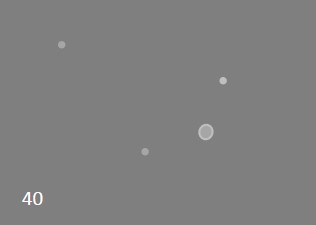 This is the first observation that I can
recall ever making of this object; I noted it as bright, of rather medium size compared
to other planetaries that I have seen (at 76x), very clearly non-stellar, and without any
color. It made a very distinctive pattern with the field stars in the eyepiece.
One interesting thing I noted was that, unlike all of the galaxies that I've viewed based
on the H400 list, the magnitude they list for NGC 40 is 10.0, while the magnitude in TheSky
is shown at 11.0; in every other case, the planetarium software showed the objects brighter
than the H400 list. This is the first observation that I can
recall ever making of this object; I noted it as bright, of rather medium size compared
to other planetaries that I have seen (at 76x), very clearly non-stellar, and without any
color. It made a very distinctive pattern with the field stars in the eyepiece.
One interesting thing I noted was that, unlike all of the galaxies that I've viewed based
on the H400 list, the magnitude they list for NGC 40 is 10.0, while the magnitude in TheSky
is shown at 11.0; in every other case, the planetarium software showed the objects brighter
than the H400 list. |
| 2 | 129 | Nov 11, 2018 | 150mm f/5 achromat | 213 OLC | Cassiopeia | This cluster has a large symbol in the planetarium software TheSky, but under the sky conditions this evening (clear but frosty) and the ambient light, it did not pop out at me despite using a 6 inch telescope. I did see an irregularly-shaped region of unresolved haze with several small groups of much brighter stars over the haze, and I verified with the charts that I was looking in the right spot; additionally, a nice tight triangle of stars just north of the brightest field star seemed embedded in the haze in my eyepiece, and it clearly shows in the planetarium software that I had the correct location. This cluster would be nice with a bigger scope in a dark sky. |
| 3 | 136 | Dec 4, 2018 | 150mm f/5 achromat | 213 OLC | Cassiopeia | On November 11, 2018, I attempted to observe this open cluster at 37.5x with my new 6 inch f/5 achromat, but could not see it. I am certain of the location, so I know that the object was centered in my field of view, but I could not detect anything there; according to images of the object, such as this one from phys.ttu.edu, it is quite small, so I guess I should not be surprised that I could not see anything at such low power. Will have to try more aperture and/or magnification next time. Now, finally, on December 4, 2018, I believe I saw the cluster with the 6" refractor at 60x; conditions were good but in the driveway there is some light pollution and my eyes were not fully dark adapted. I saw an area of very faint haze speckled by a few faint stars that was in the exact position that I know the cluster to be in, but I was not able to detect anything beyond that. |
| 4 | 157 | Sept 5, 2018 | 13.1" dob | Blue Ridge Parkway | Cetus | Conditions were good; the sky was very clear but also very humid, so the transparency was not the best. My notes indicate that I saw this galaxy as large, very apparent in the eyepiece, and with an ususual look to it ~ I did not detect much of a core, so the illumination across the face of the object seemed more even than many of the other galaxies that I've observed; it appeared to be elongated if I interpreted the fainter outer regions correctly. This image from virtual telescope shows a much more detailed, but still quite representative view of what I saw; compare it to my sketch of the star field to see that I drew the galaxy with the same orientation with respect to the three field stars and that my notes indicate a low, even surface brightness, which matches the visual appearance of a galaxy without a prominent core. |
| 5 | 185 | Dec 3, 2018 | 150mm f/5 achromat | 213 OLC | Cassiopeia | This galaxy, which I think is a satellite of the Andromeda galaxy, was seen as a faint smudge in a 12.4mm eyepiece giving about 60x; it was hard to see but not too difficult to locate in binoculars and the finderscope. The sky conditions were actually very good this evening although there is some light pollution in my sky; nevertheless, I could not see any structure or features or anything about this galaxy except a faint brightening of the sky in the exact location of the galaxy, so I know that I was observing the correct object. |
| 6 | 205 | Nov 20, 2017 | 13.1" dob | 213 OLC | Andromeda | Also known as M110, I have observed this galaxy on many occasions, often just with 20x80 binoculars ~ amazing how diffuse it is compared to M32, but it is quite noticeable when panning across it, however it becomes less noticeable when staring at it; orientation is very evident |
| 7 | 225 | Dec 3, 2018 | 150mm f/5 achromat | 213 OLC | Cassiopeia | This is a bright and large open cluster, which should be easy to find since it lies along the path from Gamma Cassiopeiae (Navi) to Kappa, in a position about half-way between the two; I could see the cluster in the finderscope and with no difficulty using a 20mm erfle, giving about 37x, even though there were some thin clouds in the field of view at the time. The cluster was totally resolved, with maybe a dozen to fifteen stars arranged in a half or semi-circular pattern, with the northern and western parts of the circle populated by a regular pattern of evenly-spaced stars. |
| 8 | 246 | Sept 5, 2018 | 13.1" dob | Blue Ridge Parkway | Cetus | 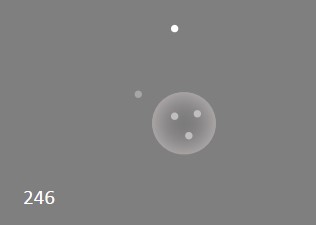 I have observed this planetary on several occasions,
at least one time on which I found it to be obvious. On this evening, the conditions were good;
the sky was very clear but also very humid, so the transparency was not the best. I noted it as
large, with low surface brightness, but still very obvious owing to its size ~ I could not detect any
structure or color, so I saw it as just grey. There was a line of stars to one side of the body
of the planetary, as well as three prominent stars visible within the nebula itself, as shown in this image by Martin Germano. The presence of
the stars within the nebula resulted in an overall impression of three-dimensionality. I have observed this planetary on several occasions,
at least one time on which I found it to be obvious. On this evening, the conditions were good;
the sky was very clear but also very humid, so the transparency was not the best. I noted it as
large, with low surface brightness, but still very obvious owing to its size ~ I could not detect any
structure or color, so I saw it as just grey. There was a line of stars to one side of the body
of the planetary, as well as three prominent stars visible within the nebula itself, as shown in this image by Martin Germano. The presence of
the stars within the nebula resulted in an overall impression of three-dimensionality. |
| 9 | 247 | Sept 5, 2018 | 13.1" dob | Blue Ridge Parkway | Cetus | I have observed this galaxy several times, among them on December 1, 2008, from near a location between Magdalena and the VLA in New Mexico with 20x80 binoculars as well as my old Meade 2045 SCT; the transparency of the skies on that occasion was unlike any I have ever experienced. On other occasions, with much larger scopes but in a milky sky, I have missed seeing it altogether. This evening, the conditions were good; the sky was very clear but also very humid, so the transparency was not the best. Despite the less than perfect transparency, I was able to see this galaxy as dim, large, with a very low surface brightness, but easily seen. It was adjacent to a star, and clearly elongated in a direction away from the star, and toward another one that was farther away. Compare this image from wikimedia commons to my sketch to see that the galaxy does indeed have a very low surface brightness and that I correctly noted the star at one end, however I am not sure which of the other stars I was seeing that made me draw them in but not others. NGC 247 is only about 11 million light years distant, so it's almost exactly the same distance away as NGC 253. |
| 10 | 253 | Sept 5, 2018 | 13.1" dob | Blue Ridge Parkway | Sculptor | I have observed the silver dollar galaxy many times, most notably in New Mexico in early December 2008 under the most transparent skies I've ever experienced (with 20x80 binoculars and my 4" SCT Meade 2045). On the date indicated in the table, observing with my 13.1" dob, I noted it as huge, taking up half the FOV of the erfle at 76x, mottling across the entire disk, and with the central part of the galaxy seemingly brighter on one side than the other; maybe 3/5 of the way from the left end in my view toward the right, the brightness drops off noticeably. |
| 11 | 278 | Dec 3, 2018 | 150mm f/5 achromat | 213 OLC | Cassiopeia | This is another of the surprising group of galaxies in southern Cassiopeia, and this one is not a satellite of Andromeda; I was able to see it in a triangle pattern with two other stars on the opposite side of the pair of bright stars that I used to jump off to see NGC 185. It was seen as a faint and very small smudge at 60x adjacent to a faint star that made the triangle with the two stars east of Omicron Cassiopeiae. I could not detect any structure or features in the faint smudge, but I definitely saw the correct object. |
| 12 | 288 | Sept 5, 2018 | 13.1" dob | Blue Ridge Parkway | Sculptor | On most occasions when I have observed NGC 253, above, I have also checked in on this random globular cluster, although it has never made much of an impression on me; its location is more remarkable than its appearance, based on my observations. In September 2018, I noted it as dim but not small, with the outer portions seeming to be resolved; overall it presented a granular appearance. |
| 13 | 381 | Dec 4, 2018 | 150mm f/5 achromat | 213 OLC | Cassiopeia | This cluster was far easier to identify than NGC 136, but still was not bright; I saw it as dim, but surprisingly large, at 60x, and with just a hint of barely resolved stars across most of the area that I saw as a much dimmer and somewhat smaller version of NGC 7789. |
| 14 | 404 | Nov 20, 2017 | 13.1" dob | 213 OLC | Andromeda | first observation ever of this galaxy; amazed at how easy it was at 76x, not overwhelmed by the glare of Beta Andromedae at all; fairly concentrated and bright, maybe a slight elongation |
| 15 | 436 | Dec 4, 2018 | 150mm f/5 achromat | 213 OLC | Cassiopeia | This cluster was more difficult to identify than NGC 381 above; it was smaller, and less distinct, although I was able to detect a small concentration of stars in the area of the cluster, just to the east of a middling bright field star. To me, there appeared to be two knots of stars barely touching that made up the cluster, so I am not sure if both were part of it, or just one of them. |
| 16 | 457 | Dec 4, 2018 | 150mm f/5 achromat | 213 OLC | Cassiopeia | The ET cluster is easy to locate and observe and on this occasion I was able to see a dozen or so stars in the center of the cluster just off of the two bright stars that make up the eyes, and from the linear group in the center, the legs and two curling arms could easily be seen as well ~ but it's not clear from the view as to how many of these stars comprise the cluster. |
| 17 | 488 | Sept 5, 2018 | 13.1" dob | Blue Ridge Parkway | Pisces | I doubt I have ever observed this galaxy before;
based on deep images such
as this one from Mount Lemon Observatory, it's a beautiful face-on spiral with yellow core
and blue arms ~ although I anticipate that my view will be much more like this image from Martin Germano, if I even see any of the
arms at all. This galaxy is about 90 million light years away according to the wikipedia
article on it. Despite its distance, TheSky software lists its magnitude at 10.3, so it
ought not be too difficult to pick up if the skies are clear. I noted it as not small, but not much of a core, with a low surface brightness, and it has a very noticeable orientation, in other words it is elongated and has a clearly discernible axis of orientation. Interesting that I noted that, because in the image by Martin Germano, it shows up as almost perfectly round. Not sure how I came to the conclusion that it was clearly elongated. |
| 18 | 524 | Sept 5, 2018 | 13.1" dob | Blue Ridge Parkway | Pisces | This galaxy is listed as magnitude 10.6 by my
planetarium software, TheSky, and lies within a grouping of about six galaxies in central Pisces;
this sketch
of NGC 524 is probably about what I'll see in the eyepiece. In 2018, this galaxy hosts the planet Uranus in its part of the sky, although I did not stop by to see it. My notes describe NGC 524 as dim, with a not very pronounced orientation or elongation, with a low surface brightness and not much of a core either. My sketch shows that I noted two obvious stars on either end of the galaxy, very close to it. In terms of showing its location relative to the two field stars, this image on www.phys.ttu.edu gives an authentic view compared to what I saw in the eyepiece. |
| 19 | 559 | Dec 4, 2018 | 150mm f/5 achromat | 213 OLC | Cassiopeia | This cluster was easy to locate as well, or maybe I am just getting used to navigating around with this telescope; it was faint, and not large, but distinct as a small knot of stars over a slightly brighter region of sky, just off of the western-most of a small diamond or rectangle shape of stars. |
| 20 | 584 | Sept 5, 2018 | 13.1" dob | Blue Ridge Parkway | Cetus | This next grouping of galaxies was interesting and would be my first time observing any of them. Conditions were good; the sky was very clear but also very humid, so the transparency was not the best. I saw NGC 584 as small, but bright, with a very noticeable core, not much of a halo, and nestled in between two stars, which made identifying it easier due to the contrast with the two stars. According to my planetarium software, TheSky, this galaxy is magnitude 10.4, although in the Herschel 400 list it cites magnitude 12.0, which I think is too dim based on what I saw. The perfect image of the entire galaxy group by Jim Thommes shows the three H400 galaxies as well as NGC 600, although in his image, it does not appear to be larger than the other three, as it does on TheSky planetarium software (see the entry for NGC 615 for that). |
| 21 | 596 | Sept 5, 2018 | 13.1" dob | Blue Ridge Parkway | Cetus | Conditions were good; the sky was very clear but also very humid, so the transparency was not the best. My notes indicate I saw this object as being similar to NGC 584, but with a lower surface brightness; it was slightly larger but also dimmer. TheSky cites a magnitude of 10.9 for this galaxy, which matches my impression that it is dimmer than NGC 584. The three galaxies in this group are all anywhere from 65 to 70 million light years away (including NGC 600, not part of the H400 list). |
| 22 | 598 | Sept 5, 2018 | 13.1" dob | Blue Ridge Parkway | Triangulum | This object is M33, which of course I have seen before, but this time I think I had my best ever view of it; it was easily visible in the finder on this humid but otherwise clear evening, and the telescopic view at 76x was more detailed than I can ever remember having. I saw the core of the galaxy as being noticeably offset from the center of the overall nebulosity; in my upside-down view, the core was toward the bottom of the FOV and the upper part of the nebulous region included areas that extended out to the upper left and to the right that delineated two of the arms. |
| 23 | 613 | Sept 5, 2018 | 13.1" dob | Blue Ridge Parkway | Sculptor | This is probably the first time I have observed this galaxy; I noted it as quite elongated, not dim, not much of a core, with a low surface brightness, and an obvious orientation. Of course, I did not see a hint of the wierd spiral arms seen in long-exposure images. |
| 24 | 615 | Sept 5, 2018 | 13.1" dob | Blue Ridge Parkway | Cetus | Conditions were good; the sky was very clear but also very humid, so the transparency was not the best. I saw this galaxy as small and dim, mostly just a core with a barely detectable halo around it. This group of three galaxies was interesting to observe even though none of the individual galaxies were very noteworthy. NGC 615 has a magnitude of 11.5 from TheSky and 12.5 in the H400 list, and based on my observations I agree that it is the dimmest of the three. What is interesting, and something I definitely want to go back to, is that the H400 list did not include NGC 600, which shows up on the chart below a line drawn to connect the three H400 galaxies; this galaxy was cited by JLE Dreyer as "most extremely faint" and by others as "very large, low surface brightness", so it might be an interesting target for a time when we have dark, transparent skies. |
| 25 | 637 | Dec 4, 2018 | 150mm f/5 achromat | 213 OLC | Cassiopeia | This cluster was quite small compared to most of the other ones I've observed; it was rather bright however, with just a few stars that were bright, several more that were dimmer, tightly packed, and all of them over a faint haze that looked like a group of many more unresolved stars; there was no humidity or sky haze this evening, and no dewing of the optics that could fool you into thinking there was some haziness, so I believe it was real. |
| 26 | 651 | Feb 20, 2018 | 13.1" dob | 213 OLC | Perseus | I have observed the Little Dumbell before but not very often; I was clearly able to see it but I was not able to distinguish the part of this planetary that is NGC 651 separated from NGC 650 ~ it just looked like one object to me, a grayish irregular blob without any structure visible to me on this evening with a 5-day old Moon out and some car headlights always shining at me. |
| 27 | 654 | Dec 4, 2018 | 150mm f/5 achromat | 213 OLC | Cassiopeia | This cluster was easy to see but not bright; it was a fairly dense area of haze with a few dim stars speckling the haze, just to the northwest of a field star; it made a surprisingly good impression at just 60x, but this might be a good object with the dob under dark skies. |
| 28 | 659 | Dec 4, 2018 | 150mm f/5 achromat | 213 OLC | Cassiopeia | This cluster was easy to locate but I found it to be considerably more difficult to see than NGC 654; it was dimmer and less distinct to me, although similar in the sense that it was mostly an unresolved haze with maybe a few dim stars interspersed. |
| 29 | 663 | Dec 4, 2018 | 150mm f/5 achromat | 213 OLC | Cassiopeia | Much easier to see than its companion clusters, this one was fully resolved, with 20 to 25 stars of varying brightnesses in a rich field; would make a spectacular sight in the dob under a dark sky. |
| 30 | 720 | Sept 5, 2018 | 13.1" dob | Blue Ridge Parkway | Cetus | Conditions were good; the sky was very clear but also very humid, so the transparency was not the best. This galaxy was not easy to locate, because it is located in a sparse region of southern Cetus, roughly about equidistant from the pair of stars Zeta and Chi Ceti to the north and Tau Ceti to the southeast. It could pose difficulties having to star hop to this galaxy on a hazy night or under some light pollution if you couldn't see enough stars in the finder. I noted that NGC 720 appeared small but I saw it as brighter than the three galaxies above (NGC 584, 596, and 615); I noted an orientation to the galaxy but no structure, which tells me it is probably a distant spiral. TheSky lists its magnitude as 10.2 and provides the descriptions "elongated galaxy with bright core" and the comment from JLE Dreyer, "considerably bright, pretty large, little extended, westward abruptly much brighter middle." According to the wikipedia entry for NGC 720, it lies approximately 80 million light years away. |
| 31 | 752 | Nov 20, 2017 | 13.1" dob | 213 OLC | Andromeda | many faint stars and moderately bright ones scattered over a large area, not very clear where the cluster starts and ends at 76x; many multiple stars in this cluster |
| 32 | 772 | Nov 20, 2017 | 13.1" dob | 213 OLC | Aries | first observation, very faint, maybe slightly elongated along axis between two bright stars, between which the galaxy is about equidistant, but otherwise no structure, difficult to find but not difficult to hold once acquired |
| 33 | 779 | Sept 5, 2018 | 13.1" dob | Blue Ridge Parkway | Cetus | Conditions were good; the sky was very clear but also very humid, so the transparency was not the best. I saw this galaxy as not small, not bright, but with an obvious orientation, although I didn't try to decipher the direction of its elongation given my dobsonian mount and upside down eyepiece view; the core did not seem bright to me, so it had more of an even illumination across its face. This object, just like NGC 720 above, was located in a very sparse area of Cetus, far away from bright guide stars, so the star-hopping would be very challenging if your limiting magnitude was not good. I sketched the galaxy and field stars but I can't find a wide enough view on the internet to completely validate all the field stars I noted. |
| 34 | 869 | Feb 20, 2018 | 13.1" dob | 213 OLC | Perseus | Always a beautiful view, this cluster shows a nice concentration of stars with some colored ones scattered throughout. |
| 35 | 884 | Feb 20, 2018 | 13.1" dob | 213 OLC | Perseus | The trailing cluster in the pair is clearly more open than its neighbor, almost with a hole in the middle, and also its share of nice orange stars to give a pleasing contrast to the white and blue stars. |
| 36 | 891 | Nov 20, 2017 | 13.1" dob | 213 OLC | Andromeda | very faint, extremely elongated, no structure visible at 76x |
| 37 | 908 | Sept 5, 2018 | 13.1" dob | Blue Ridge Parkway | Cetus | Conditions were good; the sky was very clear but also very humid, so the transparency was not the best. I noted this galaxy as very large, but not bright, therefore with a low surface brightness, it had an obvious orientation and clear elongation to it; I thought it was interesting that this thing was very low in the southeast but still very easily visible ~ that means it would likely be a great object if it were high in a good sky. It is listed as magnitude 11.0 in the H400 catalog, but 10.2 in TheSky software. This galaxy, like several of the previous ones in this list, was difficult to find owing to its location in a sparse area with no bright stars nearby. |
| 38 | 936 | Jan 6, 2018 | 13.1" dob | 213 OLC | Cetus | This galaxy was easy to spot as an even glow around an obvious core; nearby, its neighbor NGC 941 was also fairly easy to detect, although it was not as big as 936; they must make a nice view in a dark sky, such as this image. |
| 39 | 1022 | Jan 6, 2018 | 13.1" dob | 213 OLC | Cetus | First time observing this galaxy; I think I got a clear sighting of this galaxy without too much trouble; it appeared like a faint glow around a condensed core that clearly moved around as I moved the field of view, so it wasn't just haze on the eyepiece or light pollution or something; to me it seemed a little more obvious than 1052 below. |
| 40 | 1023 | Feb 20, 2018 | 13.1" dob | 213 OLC | Perseus | This galaxy was immediately visible in the eyepiece as an elongated glow with a strong concentration in the center ~ although I could not see any structure, the elongation did appear to me to be oriented along a similar axis as a line drawn between two stars just off one corner of the galaxy. This image from Martin Germano confirms for me that I was seeing the right object and picking up the detail correctly. |
| 41 | 1027 | Dec 7, 2018 | 150mm f/5 achromat | 213 OLC | Cassiopeia | This cluster was not difficult to locate but not very obvious in the eyepiece, at least at 60x. I saw a smattering of stars in the area of what I assume is a brighter field star, which the charts show as being in the center of the cluster, and which images such as this image from lex.sk.ca which shows a smattering of stars with no unresolved haze surrounding the bright star in the middle. What I saw was less striking than this image; I noted only a few of the brighter stars around the main star, perhaps ten or twelve, but I would say there was a noticeable increase in the stellar density in this area compared to the surroundings, so I guess I can say that it did look like a very sparse cluster. |
| 42 | 1052 | Jan 6, 2018 | 13.1" dob | 213 OLC | Cetus | First time observing this galaxy; in conditions that were not great (10 deg F, clear but somewhat milky sky with not good dark adaptation), this galaxy seemed to be fairly obvious and rather extended; there was a central core but then a discernable glow around it. |
| 43 | 1055 | Jan 6, 2018 | 13.1" dob | 213 OLC | Cetus | I have observed this object before under better conditions, but this time it was difficult to detect at first; sweeping around the object brought up M77 very distinctly, so then I went back to the location of 1055 and believed that I could detect the glow of the galaxy; there was no core that I could see, but rather an extended glow that appeared quite a bit bigger than M77. This amateur image tells me that I was not looking in the exact correct spot, since I thought I saw the glow a bit further up towards M77; will have to look again. Another look with better dark adaptation and I did notice the tilted glow of the galaxy in the right spot, but this one needs a better sky for me to really make an unaided observation. |
| 44 | 1084 | Dec 3, 2018 | 150mm f/5 achromat | 213 OLC | Eridanus | Despite being out in the middle of nowhere, this galaxy was surprisingly easy to find, even at 37x in my 6 inch achromat under good sky conditions but with some light pollution and my eyes not being dark adapted. I was able to see a faint but distinct, small, and slightly elongated smudge located south of a notable pattern of three stars in a shallow arc, with the center star of the arc closest to the galaxy. I could not see any structure to the galaxy, but this object might be worth a look under dark skies with the dobsonian. |
| 45 | 1245 | Feb 20, 2018 | 13.1" dob | 213 OLC | Perseus | This open cluster showed nicely in that it was not very difficult to detect, but still a bit challenging, with the 5-day old Moon out in the western sky. I think this is the first time I have observed it; I noticed a faint haze overlaid with a partially resolved clutch of faint stars, all set in a nice star-field. |
| 46 | 1342 | Feb 20, 2018 | 13.1" dob | 213 OLC | Perseus | 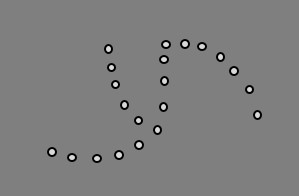 NGC
1342 was a real treat to observe, so it's a shame that I don't recall ever having observed it before!
It presented a nice array of fairly bright, or at least easily visible, stars arranged in three
arcs that intersected near the middle of the cluster, with a large number of barely unresolved stars
scattered throughout the cluster, all over a granular haze. The sketch shows what it looked like
to me, at least in terms of the orientation of the main stars (I used the same sized dots, but I don't
mean to suggest that they appeared evenly bright to me). NGC
1342 was a real treat to observe, so it's a shame that I don't recall ever having observed it before!
It presented a nice array of fairly bright, or at least easily visible, stars arranged in three
arcs that intersected near the middle of the cluster, with a large number of barely unresolved stars
scattered throughout the cluster, all over a granular haze. The sketch shows what it looked like
to me, at least in terms of the orientation of the main stars (I used the same sized dots, but I don't
mean to suggest that they appeared evenly bright to me). |
| 47 | 1407 | Feb 12, 2018 | 13.1" dob | 213 OLC | Eridanus | This is the first observation I can recall of this galaxy; under humid skies, i.e., not very transparent, I was able to easily see NGC 1407 and its companion NGC 1400 at 48x, although I could not discern any structure. At 103x, The galaxies became brighter and more of the extended gray haze could be seen, but I still could not see any structure. These would be nice for a revisit under truly clear, dark skies. |
| 48 | 1444 | Feb 20, 2018 | 13.1" dob | 213 OLC | Perseus | This open cluster is one I have never observed before ~ it was difficult to detect on this night with a 5 day old Moon in the western sky. Very hard to determine if I was seeing a cluster at all, but I did notice that there was a condensed haze around a bright star, with the haze seeming to extend a little out in an asymmetric direction. This image kind of shows what I was seeing (although I could not resolve the stars like they are in the image). |
| 49 | 1501 | Dec 16, 2017 | 13.1" dob | 213 OLC | Camelopardalis | This is the first observation I can recall making of this planetary nebula; it was fairly obvious once I found it, but was just a dim gray fuzz with no discernable variation in terms of pattern or brightness |
| 50 | 1502 | Dec 16, 2017 | 13.1" dob | 213 OLC | Camelopardalis | In the orientation of my viewing, this was a very nice cluster with the immediate impression of a bunch of double stars, the most prominent being at the very center of the cluster, but extending to the lower right of it were two more doubles that progressively got wider and gradually changed their orientation with respect to each other; there was another double to the upper left of the center double, and then there was a wider double well off to the right of the cluster that seemed to fit in with the overall picture of doubles; above the center double, there were fainter stars that made up the remainder of the cluster but those were not noticeably grouped in doubles |
| 51 | 1513 | Feb 20, 2018 | 13.1" dob | 213 OLC | Perseus | This cluster was difficult to see, but with averted vision, I could detect maybe a half-dozen stars over a slight haze. For some reason, I had difficulty locating this object, I kept getting mis-oriented. |
| 52 | 1528 | Feb 20, 2018 | 13.1" dob | 213 OLC | Perseus | I have observed this open cluster many times but would not have remembered what it looked like ~ so now I know, using the larger telescope, that it shows several chains of stars curving out from the center; many dozens of stars were resolved and there was also a slight hazy look to the background between the resolved stars. |
| 53 | 1535 | Feb 12, 2018 | 13.1" dob | 213 OLC | Eridanus | This planetary jumped out at me immediately upon looking into the eyepiece; a clearly blue fuzzball at 103x, but even going up to 173x, I was not able to see any structure except an even blue disk in the center that faded away to a fuzzy edge outside of the even toned interior. Reminded me of NGC 7662 in Andromeda. |
| 54 | 1545 | Feb 20, 2018 | 13.1" dob | 213 OLC | Perseus | This open cluster presented a combination of a granular haze over faint and brighter resolved stars, off-centered around a bright star and within a triangle of stars or star-pairs. Easy to locate and observe, even with a 5 day old crescent Moon in the sky. |
| 55 | 1647 | Sept 5, 2018 | 13.1" dob | Blue Ridge Parkway | Taurus | Conditions were quite good on this evening (in reality, by this time, it was well after midnight, into September 6) except for the high humidity that was causing dew on the optics. This cluster presented a sparse appearance, it is very large, I could not detect any unresolved stars or haze, and there were quite a few noticeable pairs of stars across the extent of the cluster. |
| 56 | 1664 | Nov 27, 2017 | 13.1" dob | 213 OLC | Auriga | This open cluster had the appearance almost like a galaxy made of dots, because there was a central grouping of stars and at least three curved chains that extended outward, one above, one to the right, and one below; my first observation of this object |
| 57 | 1788 | Jan 19, 2018 | 13.1" dob | 213 OLC | Orion | This is the first time I have observed this diffuse nebula, and was concerned that the skies were not transparent enough nor my vision dark-adapted enough, but I need not have worried; it was a fairly obvious glow at the nexus of an M-shaped group of stars and clearly moved around the field of view as I nudged the telescope around. I can't say that I saw any real structure to it, but maybe I should revisit this object in a darker sky and with better dark adaptation. This APOD shows NGC 1788 as the small whitish area just below the "equator" of the image about 70% to the right side, almost directly above the brightest star in the lower right quadrant; the pattern of stars at the nebula matches exactly what I saw in the eyepiece, so I am 100% confident I saw it. |
| 58 | 1817 | Sept 5, 2018 | 13.1" dob | Blue Ridge Parkway | Taurus | I noted this as a very fine cluster, with many faint stars, a few bright ones, and that the cluster possessed a noticeable elongation. It makes a nice contrasting pair with NGC 1807, which is coarser and with brighter stars. This image shows the two clusters nicely, however the elongation in the shape of 1817 that I noticed is not apparent in the image. |
| 59 | 1857 | Nov 27, 2017 | 13.1" dob | 213 OLC | Auriga | At first hard to locate this object until I realized it was a very faint and small cluster around an orange-ish star; there were several faint stars in a box- like pattern that surrounded a faint haze that remained unresolved even at 159x; also my first observation of this open cluster |
| 60 | 1907 | Nov 27, 2017 | 13.1" dob | 213 OLC | Auriga | First observation of this open cluster; very neat object, close to M38 but so small and almost unresolved at 76x; at 103x, more of the individual stars came out and presented a nice view, with one star in the middle brighter than the rest |
| 61 | 1931 | Nov 27, 2017 | 13.1" dob | 213 OLC | Auriga | Not my first observation of this diffuse nebula but still not an obvious object to find; once located, it appeared fairly bright, but almost starlike at its center with just the faintest haze around it, not a large extent at all; easy to see how David Levy mistook it for a comet when he first observed it; will have to go back to this object at some point when the Moon is not out (a 7 day old Moon was setting at the time); post-observation: one description I found indicated that I need to use more magnification on this object to get more detail than just a fuzzy starlike object, because it's supposed to look like a miniature M42! |
| 62 | 1961 | Dec 16, 2017 | 13.1" dob | 213 OLC | Camelopardalis | First observation of this galaxy ever and it was the most difficult object I've observed to date in the Herschel 400; very faint, fairly close to a dim star, no structure detectable |
| 63 | 1964 | Feb 12, 2018 | 13.1" dob | 213 OLC | Lepus | This was my first attempt at observing this object, and I found it to be very difficult, even with the 13" dob. The skies were on the humid side, so even though it was clear, the skies were not transparent, and everything was dewing up quickly so there could also have been some dew on the optics. At 48x, I could not detect the galaxy for sure, although there were some possible hazy spots in the field of view. At 103x, I thought I could detect a hazy spot, and when I increased the magnification to 173x, I became more convinced that I was seeing the galaxy in close proximity to a small clump of field stars. This image from wikimedia confirms that I was looking in the right spot because I saw the triangular pattern of field stars below the galaxy (in my orientation). |
| 64 | 1980 | Jan 19, 2018 | 13.1" dob | 213 OLC | Orion | Very obvious glow around the star iota Orionis, not any discernible structure to me at this observation, but easily detected. This object is also the open cluster surrouding iota Orionis, which is populated almost exclusively by blue stars, as seen in the lower right of this image of Orion's sword. |
| 65 | 1999 | Jan 19, 2018 | 13.1" dob | 213 OLC | Orion | First time I have observed this object, and it was surprising how bright it was, although very small; it appeared to be a bright knot of nebulosity around a star, althgough without looking up its appearance, it could have just been a particularly bright core of nebulosity. Wikipedia shows that the core of this nebula is actually a dark nebula, but from the wider-out views, it is clear that at low power (my observations were at 48x and 109x), it could look like an almost star- like object. Another observation from a truly dark site could be interesting. |
| 66 | 2022 | Jan 19, 2018 | 13.1" dob | 213 OLC | Orion | This planetary was difficult to find until I consulted a detailed chart in TheSky and locked on to the exact location; once I was able to pinpoint its location in the eyepiece, it was clear to see (not obvious, but clear). I could not discern any kind of structure, just a faint, even gray glow at the location of the nebula. Compared to other planetary nebulae, this was interesting because it was faint but still detectable as a planetary, as opposed to some that are so large that their surface brightness is extremely low which makes them undetectable in my skies. |
| 67 | 2024 | Jan 19, 2018 | 13.1" dob | 213 OLC | Orion | I have seen the flame nebula before, better than on this occasion. My skies this evening were too bright and my dark adaptation not good enough to make a clear identification of the nebula; the only thing I could detect was the slight reduction in brightness where the dark lane through the middle of the nebula divides it in half, so I'm going to count this as an observation owing to the fact that for the dark lane to be detectable, the area of sky on either side must have been barely bright enough that the dark lane stood out. |
| 68 | 2126 | Nov 27, 2017 | 13.1" dob | 213 OLC | Auriga | First observation; faint, not very distinct, adjacent to and perhaps including a bright star at one edge; other members stretched out to the west and north from the bright star, with a faint haze and a few faint individual stars in the right angle between the west and north oriented chains |
| 69 | 2129 | Jan 19, 2018 | 13.1" dob | 213 OLC | Gemini | My first observation of this open cluster, although definitely not by any means my first time observing this part of the sky; I have observed the stars all around the northern feet of Gemini many times, usually taking note of the many wide double stars here. Now I see the faint granular glow of the cluster surrounding the bright star at this location, SAO 77842, which is one of the stars making up one of the wide doubles. The glow surrounds this star and handful of other stars that are detectable here. |
| 70 | 2158 | Jan 19, 2018 | 13.1" dob | 213 OLC | Gemini | This faint companion to M35 is one I have observed often, but this time with 109x, I could see a similarity to NGC 2129 listed above, in that both are still a haze at this power, with only a few resolved members, unless those are foreground stars. |
| 71 | 2169 | Jan 19, 2018 | 13.1" dob | 213 OLC | Orion | This open cluster is one I had not ever viewed before; it made a nice appearance at 48x, with several groups of stars overlaid on a faint unresolved haze. In the center was a nice triangle of stars near several others that were very faint, with two only being visible with averted vision; at the lower edge were three stars in a straight line, and continuing on from those was another grouping with one brighter star. |
| 72 | 2185 | March 10, 2018 | 120mm f/5 achromat | 213 OLC | Monoceros | This is my first attempt to located this object, a diffuse nebula ~ it was extremely faint and small at 33x, but even with car headlights coming over the horizon at me and not being dark adapted, I could detect a slightly glowing spot that definitely moved with the stars in the eyepiece (i.e., it was not fogging or a reflection). This is an object to attempt with the larger dob from a dark site. |
| 73 | 2186 | Jan 19, 2018 | 13.1" dob | 213 OLC | Orion | This is my first observation of this open cluster; in my opinion, pretty unremarkable view. It was actually difficult to determine the boundary of the cluster; there was one group of faint stars that was surely part of the cluster, and then two more successively more scattered groups that could also have been part of it. |
| 74 | 2194 | Jan 19, 2018 | 13.1" dob | 213 OLC | Orion | This is my first observation of this open cluster; unlike the other Orion open clusters, this one was fascinating to find and observe ~ it was a faint haze at low power (48x) but began to be resolved at 109x which suggests that it must be much farther away and richer than the other clusters observed so far in Orion. |
| 75 | 2204 | Feb 20, 2018 | 13.1" dob | 213 OLC | Canis Major | This object was very difficult to acquire under the
conditions this night (6 day old Moon in the west, some light pollution in my neighborhood, although
very clear skies and no haze). My first attempt at 30x yielded nothing, although I was certain
that I was looking in the correct area. My second attempt, at 50x, also yielded nothing, even
though as before, I know I was looking in the right spot. This image by Jim Thommes shows a view that
I doubt I'll ever have of this cluster! Going to have to continue to try for this cluster when
it's a bit darker. Although I failed to see it on Jan 23, on Feb 20 I was able to make it out with the larger scope and less moonlight. I definitely saw some of the stars and a hazy, granular glow in the area just offset to the southeast from a bright star. |
| 76 | 2215 | March 10, 2018 | 120mm f/5 achromat | 213 OLC | Monoceros | My first observation of this open cluster ~ it was faint with a slight sprinkling of stars and a slight haze, located above a pair of stars, which matches the location on the charts and planetarium software, so I know I had it clearly. |
| 77 | 2232 | March 10, 2018 | 120mm f/5 achromat | 213 OLC | Monoceros | Large, bright cluster, nice view compared to the previous faint objects! I cannot remember if I have observed this before, but it seems like I must have since it's so prominent. |
| 78 | 2244 | Feb 12, 2018 | 13.1" dob | 213 OLC | Monoceros | I have observed this object many times, although most often of course seen only the open cluster but not the nebulosity of the Rosette Nebula ~ on this evening, I checked the Rosette while aligning my finder and noted that with the 14mm UWA, I could indeed see a brightening of the sky all around the cluster, with the brightest portion being to the lower left of the cluster, although what orientation that corresponds to in the sky is not clear since I was using a dob with alt-az motions and an upside down view. A better sky with no light pollution or headlights, as well as a filter, would probably make this thing pop out very well given my aperture. |
| 79 | 2251 | March 10, 2018 | 120mm f/5 achromat | 213 OLC | Monoceros | I had a bit of difficulty in identifying this open cluster, but based on my sketch of what I thought it was, if I compare it to this image from Jim Thommes, I am sure that I had the correct location and object. Presenting a slighty curving and very elongated appearance, it is one of the strangest looking open clusters I've seen. The shape reminds me of the "leaping minnow" asterism in Auriga. |
| 80 | 2264 | Mar 5, 2018 | 13.1" dob | 213 OLC | Monoceros | The Christmas Tree cluster is always pretty easy to see ~ this evening it offered a nice view, particularly compared to the faint galaxies I have been chasing in Lynx and Leo. I could see the nebulosity around S Monocerotis, but none of the other nebulosity around here was visible under these not very dark skies. |
| 81 | 2266 | Jan 19, 2018 | 13.1" dob | 213 OLC | Gemini | I had never attempted this object before, so I had no idea what to expect; this open cluster gave the appearance of a stubby comet, partly probably because the "coma" of the comet was marked by a bright star which sat at the edge of the cluster and probably is not a cluster member. I don't think I was able to resolve any of the stars in this cluster, just a triangular-shaped haze. |
| 82 | 2281 | Nov 27, 2017 | 13.1" dob | 213 OLC | Auriga | First observation of this object; finally, after all of the small, faint clusters in Auriga, a larger one to make it easy; it was easy to count out several dozen members, depending on where you define the boundary of the cluster, but the notable feature to me was a small, diamond-shaped pattern in the geographic center of the cluster, just below the largest group of cluster members |
| 83 | 2286 | March 10, 2018 | 120mm f/5 achromat | 213 OLC | Monoceros | This is my first observation of this open cluster, and it was not easy despite its given magnitude of 8.5 in the Astronomical League listing. I was observing with direct lights shining into my eyes so I never got dark adapted, and was only using 33x, although I think sky conditions were very transparent and almost no humidity. What I saw was only the slightest hazy spot and a few faint stars in the location where the cluster should be. I believe I had the right location based on a comparison of the drawing I made against a 2-degree wide view from the SkyView website of the DSS. |
| 84 | 2301 | March 10, 2018 | 120mm f/5 achromat | 213 OLC | Monoceros | I'm sure that I have observed this object before, simply because of its magnitude (6.00) and because I recall the object number, but I don't recall what I saw previously. Unfortunately, at 33x, I did not have a great view of the cluster, so I wasn't totally sure that I had located it, but my sketch indicates that I saw a prominent line of stars going north-south, and the hazy, granular object that should have been the cluster was pretty much in the middle of the line of stars. The planetarium software I have confirmed that exactly. |
| 85 | 2304 | Jan 19, 2018 | 13.1" dob | 213 OLC | Gemini | This open cluster is one of the most remarkable views I've had of an open cluster; I had never seen an OC before that was so faint and unresolved that it looked like a galaxy in the eyepiece. Even at 109x, I could not resolve the ever so faint glow; this object must be very far away to appear so faint and with no stars visible. This reference states that it is over 14,000 light years away, which is quite far for an open cluster IIRC. |
| 86 | 2311 | March 10, 2018 | 120mm f/5 achromat | 213 OLC | Monoceros | Definitely my first observation of this open cluster, and like many others in this series in Monoceros, locating and identifying it was difficult. I found a faint hazy spot with only a few faint stars grouped in a location that, later, when I checked the crude sketch I made at the eyepiece, turned out to be the correct location based on its orientation with respect to field stars. |
| 87 | 2324 | March 10, 2018 | 120mm f/5 achromat | 213 OLC | Monoceros | This open cluster was just south of a bright pair of field stars, but just like the others, it was not obvious to me at 33x in the 120mm refractor. The faint hazy glow was off to the side of a grouping of field stars that were closer than the two bright ones mentioned at the start, so this matches the scene in my planetarium software. Unfortunately, like many of these clusters tonight, nothing much to make note of with this aperture and very low power. |
| 88 | 2335 | March 10, 2018 | 120mm f/5 achromat | 213 OLC | Monoceros | This cluster was clearly quite a bit brighter and more obvious than most of the previous ones, and it's possible that I may have observed it before since it's so bright. It presented some brighter stars with a good number of fainter ones, over a hazy glow of unresolved stars. The sketch I made matches well with the view in the planetarium software. |
| 89 | 2343 | March 10, 2018 | 120mm f/5 achromat | 213 OLC | Monoceros | I have never observed this open cluster before and it's clear why ~ this one is not easy. I saw a slight concentration of stars in the area that I subsequently found out was the correct location, so I think I was looking at the correct object. Not much to report with this cluster either. |
| 90 | 2353 | March 10, 2018 | 120mm f/5 achromat | 213 OLC | Monoceros | This object was much easier to find owing to its location surrounding a bright star in a gentle arc of three stars very close together, so when you find them in the eyepiece, there is no mistaking the cluster. It comprises at least a dozen or so stars bright enough that they stand out on their own and also there is a slight haze around the main bright star. This thing reminds me of the cluster around tau Canis Majoris. |
| 91 | 2354 | Jan 23, 2018 | 120mm f/5 Achro | 213 OLC | Canis Major | I believe this is my first observation of this object, which showed only faintly in the refractor; the sky was very clear, no haze, but a 6 day old Moon off to the west. This cluster gave the appearance of a very elongated patch of extremely faint stars which I think ran along an east-west axis. The stars were faint but I did not detect an area of unresolved haze such as with NGC 2362. This image kind of gives the idea of the east-west elongation of the cluster, although I did not in any way come close to that kind of view. |
| 92 | 2355 | Jan 23, 2018 | 120mm f/5 Achro | 213 OLC | Gemini | Definitely my first observation of this cluster, and unlike its neighbor, NGC 2395, this one was just barely visible as a small round, faint but slightly granular glow just off of a field star. Martin Germano's image gives a little bit of the flavor of this object compared to the field star to the upper left (11 o'clock position) of its edge. |
| 93 | 2360 | Jan 23, 2018 | 120mm f/5 Achro | 213 OLC | Canis Major | My first observation of this object; a very pleasant surprise to see it so readily visible. The sky was very clear, no haze, balmy for January, but a 6 day old Moon in the west; the concentration of stars was very clear to see, and were resolved to the core of the cluster, which showed perhaps fifteen to twenty faint stars. |
| 94 | 2362 | Jan 23, 2018 | 120mm f/5 Achro | 213 OLC | Canis Major | This is a cluster that I have observed many times, but on this evening, which was balmy, clear, no haze, but a 6 day old Moon in the west, I was able to see it with no difficulty at 30x and 50x. About ten to fifteen individual stars were visible against a backdrop of unresolved haze, which is what I have usually seen of this cluster. |
| 95 | 2371 | Jan 19, 2018 | 13.1" dob | 213 OLC | Gemini | This planetary nebula was very difficult for me to see under the conditions this evening; the skies were clear, but somewhat bright, and I was not very well dark-adapted. After consulting a detailed chart, I was able to confirm that I had seen the two halves of the planetary, although it was faint. I detected a pair of glows in the correct area, so I think I can say that I found these objects. This is one that I should revisit when at a dark sky location again to see if I can detect any structure in the object. |
| 96 | 2372 | Jan 19, 2018 | 13.1" dob | 213 OLC | Gemini | See the above comments. |
| 97 | 2392 | Jan 19, 2018 | 13.1" dob | 213 OLC | Gemini | On this evening, after the faint planetaries in Orion and NGC 2371/2, this was a breath of fresh air! Bright, blue, and fairly large, this was obvious in the 14mm eyepiece at 109x. I was only able to see a pretty uniform blue fuzzy ball on this evening. |
| 98 | 2395 | Feb 18, 2018 | 13.1" dob | 213 OLC | Gemini | On a very clear, no haze, balmy evening with a 6-day old Moon, I was not able to see this cluster using my 120mm f/5 achromat, even though I know I was looking in the exact spot, using 50x. Will have to revisit this object later under darker conditions. Later, on Feb 18, using the 13" dob, I was able to see the open cluster fairly easily ~ it presented an off-center appearance to me, with maybe two dozen stars visible in the cluster (using 76x power). |
| 99 | 2403 | Dec 16, 2017 | 13.1" dob | 213 OLC | Camelopardalis | This has got to be one of the hardest objects to find by star-hopping! Once found, it was quite obvious, or at least the brightest part of it was quite obvious, situated right in between two stars; dimmer nebulosity could be detected above that point, although what orientation that was could not be determined |
| 100 | 2419 | Mar 5, 2018 | 13.1" dob | 213 OLC | Lynx | This is not my first observation of this object, but I haven't seen it on too many occasions ~ this evening, cold but with some haze and clouds, and of course somewhat light polluted (this early in the evening I was not dark-adapted), I could detect a small hazy spot adjacent to the field star. No structure visible and it was not obvious, but unmistakably detected. I hope my difficulty can be traced to not yet being dark adapted, because it would be embarrassing to not be able to see this easily with a 13" scope! |
| 101 | 2420 | Jan 23, 2018 | 120mm f/5 Achro | 213 OLC | Gemini | My first observation of this cluster; under balmy, mild, clear skies with no haze, but a 6 day old Moon, I clearly saw a granular haze at the spot of this object at 50x. A few stars came into occasional view as distinct points, but mostly it appeared granular, i.e., not like NGC 2362 in Canis Major. At 50x, it was fairly compact, situated an even distance between three field stars. |
| 102 | 2421 | Mar 13, 2018 | 13.1" dob | 213 OLC | Puppis | My first observation of this cluster ~ I noted that it was small, there were some bright stars located off of what I thought was the center of the cluster, and there could have been a granular haze to the middle, although owing to my light pollution, I was not sure of this. |
| 103 | 2422 | Mar 13, 2018 | 13.1" dob | 213 OLC | Puppis | I was a bit disappointed in the view of this cluster tonight ~ conditions were excellent, although there is always light pollution here ~ the cluster is marked by a few bright stars, but not a clearly discernible boundary made out of dimmer stars or a granular haze, so it was not obvious how large this cluster is; charts routinely show it as the same size or slightly larger than M46, but this evening it did not look that way (observing at 48x with the 32mm SWA). |
| 104 | 2423 | Mar 13, 2018 | 13.1" dob | 213 OLC | Puppis | This object, which I must have easily observed on several other occasions, was a surprising treat in that it makes a nice contrast with M47 to its south. It is richer than M47 and presents a granular haze with a good number of faint stars sprinkled over an area smaller than M47 but not much smaller, if you take into account the outer extent of the haziness of this cluster. |
| 105 | 2438 | Mar 13, 2018 | 13.1" dob | 213 OLC | Puppis | This is the famous planetary nebula embedded in M46, which I have observed before. This evening, at 48x, the cluster presented its typical and rewarding view of hundreds of evenly bright, faint stars sprinkled with a good number of slightly brighter ones, making up the cluster ~ the planetary stood out nicely in the northern part of the cluster as a grey, evenly illuminated circle, with no central concentration or color. |
| 106 | 2440 | Mar 13, 2018 | 13.1" dob | 213 OLC | Puppis | This planetary was easily visible once I got good focus on the 18mm SWA (85x) ~ it was very bright and condensed, with an even core and a rapidly dimming haze almost like a halo around the core. I could not detect any color this evening. |
| 107 | 2479 | Mar 13, 2018 | 13.1" dob | 213 OLC | Puppis | Almost guaranteed that this is my first view of this cluster ~ very nice appearance ~ center completely resolved into nice chains of stars, the best one being a gentle curve that reminded me of Corona Australis, although there were other star chains as well. No granular haze observed here ~ observation made at 85x. |
| 108 | 2482 | Mar 13, 2018 | 13.1" dob | 213 OLC | Puppis | This object was easy to identify, and based on its location, I would say that I have observed it before, although I don't recall it. It presented a concentrated, granular view with some resolved stars, and there was a small group of stars on either side of the cluster to set it off nicely. The observation was made at 85x. |
| 109 | 2489 | Mar 13, 2018 | 13.1" dob | 213 OLC | Puppis | Probably my first observation of this object, and I would say it was the winner of all the objects in Puppis this night ~ the cluster center was concentrated, with a granular haze surrounding it, and the whole cluster nicely set off from the surrounding field so that its boundaries appeared very well defined. Then to top it off, there were two groups of stars on either side of the cluster, nicely bracketing it and accentuating the offset effect. One of the star groups in particular was a nice curving arc, almost like a parenthesis mark around the cluster. |
| 110 | 2506 | March 10, 2018 | 120mm f/5 achromat | 213 OLC | Monoceros | Finally, for the evening's close we end with a much easier target. According to the planetarium software, this object is relatively small; I saw it as bright with ten to a dozen stars clearly visible in the center of the object, and some fainter ones over an unresolved granular haze. |
| 111 | 2509 | Mar 13, 2018 | 13.1" dob | 213 OLC | Puppis | This is almost assuredly my first view of this cluster ~ it presented an elongated fuzzy, granular hazy central area with a nice group of field stars above it, arranged in an arc offset from the cluster center. |
| 112 | 2527 | Mar 13, 2018 | 13.1" dob | 213 OLC | Puppis | This cluster was partially resolved, appeared bright at 85x, and large in extent ~ I must have observed this object before but I can't recall it. Very obvious in the way it stands out from the field. |
| 113 | 2539 | Mar 13, 2018 | 13.1" dob | 213 OLC | Puppis | This was a very nice view ~ situated right next to a bright star and its companion, the cluster gave the appearance of having two long lobes going north and west, and one shorter lobe going southeast toward the star, so it had an unbalanced clover look to it at 85x. |
| 114 | 2548 | Mar 16, 2018 | 13.1" dob | 213 OLC | Hydra | This object is better known as M48, and of course I have observed this on many occasions with instruments down to 10x or maybe even 7x binoculars. The view of the cluster showed a fully resolved, keystone-shaped grouping of stars, with the view suggesting various chains of stars and some nice multiple groupings in the center. |
| 115 | 2567 | Mar 13, 2018 | 13.1" dob | 213 OLC | Puppis | Definitely first view ever of this cluster, and owing to the view directly over a lit-up house, I had difficulty seeing it at 85x. There could have been a slight haziness or graininess in the center and there was a slight increase in the stars at the location of the cluster ~ this definitely needs a better horizon view unspoiled by lights. |
| 116 | 2571 | Mar 13, 2018 | 13.1" dob | 213 OLC | Puppis | First view that I can recall of this cluster ~ it appeared loose without much of a central concentration, but there could have been a granular haze associated with the center. Sky conditions were excellent, but unfortunately was looking directly over a house with lights on. The view was with 85x with the 18mm SWA. |
| 117 | 2613 | Mar 16, 2018 | 13.1" dob | 213 OLC | Pyxis |  This
galaxy was extremely difficult to detect. I had
never observed this object before, and on this night, which started out with some haze and high clouds, as
well as direct lights shining into the location of my scope, I had to come back to this object four times
before I was able to see something at its location. I saw only the faintest hint of a smudge, but the
sketch that I drew of the galaxy amid its field stars turned out to be correct. The sketch shows
what I saw in the eyepiece at 76x, although I could not say that I noted the oval shape of the galaxy, I
just indicated that in the sketch to make it clear that the galaxy was at that location. I only noted
a slightly fuzzy spot in the sky, no structure, no elongation, no orientation. This
galaxy was extremely difficult to detect. I had
never observed this object before, and on this night, which started out with some haze and high clouds, as
well as direct lights shining into the location of my scope, I had to come back to this object four times
before I was able to see something at its location. I saw only the faintest hint of a smudge, but the
sketch that I drew of the galaxy amid its field stars turned out to be correct. The sketch shows
what I saw in the eyepiece at 76x, although I could not say that I noted the oval shape of the galaxy, I
just indicated that in the sketch to make it clear that the galaxy was at that location. I only noted
a slightly fuzzy spot in the sky, no structure, no elongation, no orientation. |
| 118 | 2627 | Mar 16, 2018 | 13.1" dob | 213 OLC | Pyxis | This open cluster was observed by me for the first time this evening, and despite being low in a hazy sky and almost looking into the neighbor's house lights, I was able to find it on the first try without too much difficulty. The cluster was not bright, but I could definitely detect a small knot of stars in the center and a slight brightening of the sky in the center, so I am sure that I located it correctly. |
| 119 | 2655 | Dec 16, 2017 | 13.1" dob | 213 OLC | Camelopardalis | This galaxy was observed for the first time, and it was quite a bit fainter than 2403, but easier to find; to me this looked like a small galaxy with a fairly elongated shape, almost like an edge on one, with strong central condensation; was I seeing the right object? This image tells me that I was looking at the correct object, definitely not NGC 2715 to the east of it |
| 120 | 2681 | Mar 18, 2018 | 13.1" dob | 213 OLC | Ursa Major | This is my first observation of this galaxy, and I found it to be easy to identify at 62x once I found the correct location ~ it was bright and roundish, with a little bit of central condensation and the brightness falling off as you get farther from the center. My sketch verified that I had the correct location, as verified by this image from jwinman.com. |
| 121 | 2683 | Mar 5, 2018 | 13.1" dob | 213 OLC | Lynx | After a bit of disappointment with the Intergalactic Tramp above, this galaxy (my first observation) was a real treat ~ easy to locate and the very distinct shape of an edge-on spiral showed up at 62x. easily. I almost thought I could see some mottling along the galaxy ~ something to re-attack from a dark site perhaps. |
| 122 | 2742 | Mar 18, 2018 | 13.1" dob | 213 OLC | Ursa Major | Also the first observation of this 11.7 mag galaxy, and just like the previous one, this was pretty easy to see once I had the correct location. It was not large, and not too bright, but distinct nonetheless, situated near two stars, one dim and the other brighter. |
| 123 | 2768 | Mar 18, 2018 | 13.1" dob | 213 OLC | Ursa Major | This galaxy was also fairly easy to see, and unlike the first two, was also not hard to locate. My sketch showed the orientation of the oval smudge to match this image from jwinman.com, with the galaxy making a trapezoid with three other unevenly bright stars. |
| 124 | 2775 | Feb 12, 2018 | 13.1" dob | 213 OLC | Cancer | First ever observation of this galaxy; it was not too hard to locate once I had familiarized myself with the starfields to hop through. I could not discern any structure at 103x through light-polluted skies, but it stood out fairly well from the sky background because I was able to see it without any reference stars close by. |
| 125 | 2782 | Mar 5, 2018 | 13.1" dob | 213 OLC | Lynx | Now with this galaxy, my first observation of it brought us back to Earth with the level of difficulty ~ difficult to locate and it took me a while to even convince myself that I could see it, but after a while, I was able to keep the small hazy spot in view and based on the way it moved with the stars in the eyepiece, I know that I was seeing it. No detail, no structure, just a barely detectable fuzzy spot. |
| 126 | 2787 | Mar 18, 2018 | 13.1" dob | 213 OLC | Ursa Major | My first observation of this galaxy made me wish I had seen it before, because it was bright and easy (magnitude 10.8), and made a nice oblique triangle with two other bright field stars. Despite the fact that it was easy, I did not notice any structure to it, just a central condensation with diminishing brightness as you go farther from the center. |
| 127 | 2811 | Mar 16, 2018 | 13.1" dob | 213 OLC | Hydra | I certainly had never observed this galaxy before, and although it was not easy to see on this evening, it was not the hardest to see. I could only detect the slightest hazy spot at a location where the galaxy was supposed to plot out, but I could not see any orientation, central condensation, or orientation. I sketched what I saw and based on this image from lex.sk.ca, I scored a direct hit. |
| 128 | 2841 | Mar 18, 2018 | 13.1" dob | 213 OLC | Ursa Major | This galaxy was the best one of the evening so far, it was easy to locate and jumped out at me in the eyepiece. My sketch of the star field showed me I correctly identified it when compared to the image on jwinman.com. In the eyepiece at 62x, I could easily see the orientation of the spiral and tell that it showed a central brightening with dimmer extended outer areas. |
| 129 | 2859 | June 14, 2018 | 13.1" dob | Blue Ridge Parkway | Leo Minor | This galaxy was quite easy to locate and identify, even though it is listed in the index as magnitude 12.0; its location just to the east of alpha Lyncis makes it simple to find because it sits between two gate-keeper stars. My planetarium software TheSky lists it as magnitude 10.7, which if that is true would explain why it was easy; I saw it as being very concentrated. |
| 130 | 2903 | Feb 12, 2018 | 13.1" dob | 213 OLC | Leo | I have observed NGC 2903 on many occasions, so this time it was easy to find, and although the sky is somewhat light-polluted at my house, the eastern sky is best and Leo was about half-way up the sky. The galaxy appeared clearly elongated and it seemed like I could see some mottling in the center of the glow. The sky conditions seemed better now than earlier in the night, because I could not detect any dew on the car any more. |
| 131 | 2950 | Jan 6, 2019 | 13.1" dob | Blue Ridge Parkway | Ursa Major | On a cold, clear, windy night, I noted this galaxy as being small (much smaller than NGC 3184 and NGC 3198, the other two UMa objects I observed tonight), having a very strong core, and only a small hazy area surrounding the core; despite being small, it was easy to see at 76x, very noticeable as soon as I moved it into the field of view. Interestingly, as an indication of the transparency of this night, while orienting myself in the 9x50 finderscope to move toward this galaxy, I could see M81 in the finder as a small fuzzy patch, so I quickly scanned through M81, M82, NGC 2976, and NGC 3077 before moving to NGC 2950. They were all large and obvious on this evening. |
| 132 | 2964 | Feb 12, 2018 | 13.1" dob | 213 OLC | Leo | First ever observation of this galaxy, but even though I have never seen it before, locating it was not difficult. I could not detect any structure in the galaxy at 103x, but I could almost as easily see its companion, NGC 2968, albeit also without structure. In both cases, I saw a stellar core surrounded by a relatively small grey haze. |
| 133 | 2974 | Feb 18, 2018 | 13.1" dob | 213 OLC | Sextans | This is my first attempted observation of this galaxy; I had a hard time locating it, and even when I found something that I thought was the galaxy, I was not sure ~ what I saw looked like a fuzzy object surrounding, but a bit off to the side of, a star. This image from In-The-Sky.org confirms that I was seeing something that matches exactly what it is supposed to look like. |
| 134 | 2976 | Mar 18, 2018 | 13.1" dob | 213 OLC | Ursa Major | I have observed this galaxy before, most notably in May 2000 at the Star Hill Inn in New Mexico with Phil Mahon's 22" dobsonian. It looked as good in that instrument as M81 or M82 look in my normal telescopes. On this date, I wasa able to tell that the galaxy was large, not with high surface brightness, but nevertheless easy to see as a grey oval area against the sky, oriented perpendicular to the direction from this galaxy to M81. |
| 135 | 2985 | July 14, 2018 | 13.1" dob | Blue Ridge Parkway | Ursa Major | It was still twilight when I observed this galaxy, which I have never attempted prior to this evening; I noted it was being small, with a fairly prominent core, and no discernible shape or structure. |
| 136 | 3034 | July 14, 2018 | 13.1" dob | Blue Ridge Parkway | Ursa Major | Still twilight when I observed this galaxy, which is better known as M82, the lesser member of the pair with M81; I noted it as a long sliver, noticeably larger than M81 under these conditions, which tells me that in twilight, the surface brightness of most of M82 is higher than the outer regions of M81, because I could not see those. Some mottling along the length of the sliver seemed to be noticeable. |
| 137 | 3077 | Mar 18, 2018 | 13.1" dob | 213 OLC | Ursa Major | I have observed this galaxy many times before with various telescopes while in the neighborhood of M81 and M82, but my most notable viewing of this galaxy was at the Star Hill Inn with the 22" dob. It forms a very distinctive Y shaped pattern, like a distorted Aquarius water jar, with M81, M82, and NGC 2976. On this night, I could easily see this galaxy by navigating directly from M81 and M82, and could tell that it looked smaller than NGC 2976, but brighter owing to the higher surface brightness. |
| 138 | 3079 | July 14, 2018 | 13.1" dob | Blue Ridge Parkway | Ursa Major | It was still twilight when I viewed this galaxy, which I have never attempted before, and I noted it as barely visible, but its elongated nature was discernible. If we compare my sketch with this image from virtualtelescope.com, we see that I definitely drew the correct object and that it also probably matches my impression that in twilight, low in the northwest, it was probably barely visible. |
| 139 | 3115 | Feb 18, 2018 | 13.1" dob | 213 OLC | Sextans | Not entirely sure if I've seen this object before, but my guess is that I probably have seen it. This time, even with some light pollution in my neighborhood skies, I was able to see it clearly, oriented almost parallel to a pair of bright field stars located to the upper right of the galaxy. In this view from insightobservatory.com, the two stars are to the left of the galaxy, and tells me that it matches exactly what I saw in the eyepiece. |
| 140 | 3147 | Feb 24, 2019 | 13.1" dob | 213 OLC | Draco | This galaxy is a face-on spiral located in the
far western (leading) portion of Draco, just to the north of the M81/M82 pair. TheSky
planetarium software lists it at magnitude 10.7, so it should be fairly easy to observe unless
its surface brightness is low. I finally cracked into Draco on this cool, extremely windy but very clear evening; I saw this galaxy, after much difficulty doing the star hopping, as not too bright, not too small, with not much of a core, but clearly non-stellar. To the northeast from my house, there is some light pollution, and my eyes were not dark adapted at all, but I was still able to see the galaxy immediately upon looking in the eyepiece, so it must be a very good object if observed under better conditions ~ I could not detect any hint of structure nor that it is a face-on spiral. |
| 141 | 3166 | Feb 18, 2018 | 13.1" dob | 213 OLC | Sextans | I am sure that this is the first attempt of this galaxy that I've made, and it was quite rewarding to scan across this field of two obvious galaxies and several fairly bright field stars. NGC 3166 was somewhat brighter and more obvious than NGC 3169, but not very much, so in other words both were clear to see with no trouble. I could not detect any structure in these galaxies at 76x power. |
| 142 | 3169 | Feb 18, 2018 | 13.1" dob | 213 OLC | Sextans | See the above comments for comparing this galaxy to NGC 3166. While in this area, I did attempt to observe NGC 3156, which is short distance away from this pair, located close to a bright field star, but I was not able to detect it; NGC 3156 is 13th magnitude supposedly, so maybe I need darker skies or more power to see it. |
| 143 | 3184 | Jan 6, 2019 | 13.1" dob | Blue Ridge Parkway | Ursa Major | On a clear, cold, and windy night, I saw this galaxy as rather large, very near a field star, no core to speak of, bright enough to be very noticeable immediately upon moving it into the field of view, and slightly oval in shape; this object is easily found near the middle pair of stars in the "three leaps of the gazelle" asterism. I could not detect any structure in the galaxy. |
| 144 | 3190 | Feb 12, 2018 | 13.1" dob | 213 OLC | Leo | I have observed this galaxy and its companion, NGC 3193 (below) several times under better conditions, but even in these somewhat light polluted skies (but otherwise good conditions), this galaxy was easy to find and see. I could not detect any structure, but the location of the hazy spot was very distinct. In the field, there were several hazy spots, which were in the correct location and orientation to each other making it clear that I was in the right spot. I could not detect any structure in NGC 3190 at 103x. This wide angle image shows the orientation of the galaxies and matches what I saw in the eyepiece. |
| 145 | 3193 | Feb 12, 2018 | 13.1" dob | 213 OLC | Leo | See above for the observation of the main galaxy in this group, and note that the two main fuzzy spots in the field were NGC 3190 and NGC 3193. I also noted that NGC 3193 was definitely dimmer and smaller than 3190. I was also able to detect NGC 3185 but it was more difficult. No structure was visible in any of the three. |
| 146 | 3198 | Jan 6, 2019 | 13.1" dob | Blue Ridge Parkway | Ursa Major | My notes for this galaxy, also seen on a cold, clear, and windy night, show that I noted it as very easy to see, having a very clearly oval, elongated appearance, no core, but possibly a dark lane in the middle; there was a field star just off to one side of one of the ends, sort of like in this sketch. |
| 147 | 3226 | Feb 12, 2018 | 13.1" dob | 213 OLC | Leo | I have observed NGC 3226 and NGC 3227 on other occasions, for example from the Blue Ridge mountains under much darker conditions, with this telescope, so this observation was not as good, but still the galaxies were clearly visible, with no mistaking their location. At first, I thought that there should be two galaxies visible in the field, but after a moment it was clear that they were so close together that they appeared to almost merge; I could see the two separate nuclei, however, with haze surrounding them and in between. |
| 148 | 3227 | Feb 12, 2018 | 13.1" dob | 213 OLC | Leo | See the above observation for my impression of the pair of galaxies and to see that they really do appear to merge in reality. |
| 149 | 3242 | Jan 6, 2019 | 13.1" dob | Blue Ridge Parkway | Hydra | On this cold, windy, and very clear night, this planetary nebula, which I have observed on a good number of occasions, popped out as soon as I moved it into the field of view; I was able to see it at 76x as a very bright, blue, round fuzzy object that was not small, just blatantly obvious as a planetary as soon as I moved the field of view over it. It was not difficult to locate, either, in the sense that I could locate the rough position in the finder and it was already in the field of view in the eyepiece. Very pleasing object to observe; if I see it again during a warmer time, I need to put more magnification on it, because on this night, it was much too cold to linger on the object for more in depth study. |
| 150 | 3245 | June 14, 2018 | 13.1" dob | Blue Ridge Parkway | Leo Minor | 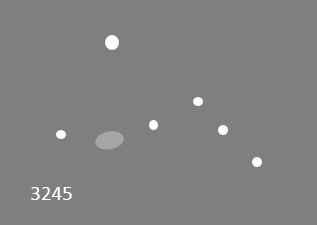 This galaxy was obvious and bright, but
more difficult to locate ~ it took a bit of star-hopping to get there, all through rather
unfamiliar parts of the sky; although this galaxy is listed as magnitude 12.0 according
to the Herschel 400 list, TheSky lists it as magnitude 10.8, which might explain why it
was so easy for me to see. If you can mentally turn this picture around, you can see that
my sketch matches some of the major field stars (my sketch covers a bit more ground). This galaxy was obvious and bright, but
more difficult to locate ~ it took a bit of star-hopping to get there, all through rather
unfamiliar parts of the sky; although this galaxy is listed as magnitude 12.0 according
to the Herschel 400 list, TheSky lists it as magnitude 10.8, which might explain why it
was so easy for me to see. If you can mentally turn this picture around, you can see that
my sketch matches some of the major field stars (my sketch covers a bit more ground). |
| 151 | 3277 | June 14, 2018 | 13.1" dob | Blue Ridge Parkway | Leo Minor | 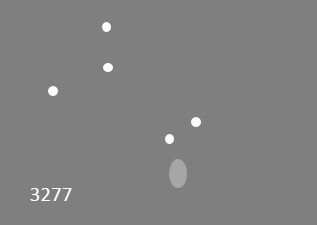 This galaxy is listed at magnitude 13.0 in
the table, but I found it to be easy, a rather concentrated core but an easily noted region
of extended dimmer area around the core; my planetarium software TheSky lists it as magnitude
11.7, which might explain why it appeared pretty easy to me compared to what I would think a
mag 13 object would look like. If you turn this image from the DSS
around counter-clockwise, it is apparent that I sketched the correct object, omitting some of
the field stars. This galaxy is listed at magnitude 13.0 in
the table, but I found it to be easy, a rather concentrated core but an easily noted region
of extended dimmer area around the core; my planetarium software TheSky lists it as magnitude
11.7, which might explain why it appeared pretty easy to me compared to what I would think a
mag 13 object would look like. If you turn this image from the DSS
around counter-clockwise, it is apparent that I sketched the correct object, omitting some of
the field stars. |
| 152 | 3294 | June 14, 2018 | 13.1" dob | Blue Ridge Parkway | Leo Minor | 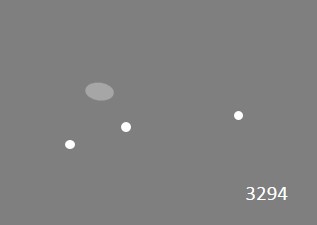 NGC 3294 is listed as magnitude 12 in the H400 list, and I found it quite obvious
at 76x; I observed a strong central condensation but also with a noticeably fuzzy surrounding
area beyond the core. I could not find a wide enough image on the internet to validate
my sketch, but a 1.5 degree wide DSS image showed field stars that sort of match with what I
drew. NGC 3294 is listed as magnitude 12 in the H400 list, and I found it quite obvious
at 76x; I observed a strong central condensation but also with a noticeably fuzzy surrounding
area beyond the core. I could not find a wide enough image on the internet to validate
my sketch, but a 1.5 degree wide DSS image showed field stars that sort of match with what I
drew. |
| 153 | 3310 | July 14, 2018 | 13.1" dob | Blue Ridge Parkway | Ursa Major | By this time in the evening, twilight was over, although all of the Ursa Major galaxies that I was attempting at this point were low in the northwest, where there was some skyglow (from what, I am not sure; no city I know of is in that direction); I noted it as small, bright, with a very noticeable core, easy to find, and near a bright star which made its nebulous appearance stand out even more. |
| 154 | 3344 | June 14, 2018 | 13.1" dob | Blue Ridge Parkway | Leo Minor | This galaxy was the first one of the night for which I noted something interesting ~ it was the first one presenting a striking appearance in the eyepiece, and one to which I would return later on just for the enjoyment. It was rather distended, no obvious core, and adjacent to two field stars that were rather bright, as shown in this image from www.virtualtelescope.eu; in this image, there does appear to be a noticeable core, but I didn't make a note of that. The H400 list puts it at magnitude 11, but TheSky lists it as magnitude 10.0, which would explain why it was so prominent and interesting. |
| 155 | 3377 | Feb 18, 2018 | 13.1" dob | 213 OLC | Leo | This is my first observation of this galaxy; it was very easy to see to the lower left (southeast) of the star 52 Leonis, and I could detect the elongation that is so apparent in images such as this from Canada. I was able to detect the elongation in the disk, but no other detail. |
| 156 | 3379 | Feb 18, 2018 | 13.1" dob | 213 OLC | Leo | I did not realize that this object is better known as M105, one of the western-most "Leo trios". Therefore, I know that I have seen this galaxy under better conditions several times, but it was still pleasing to see that for operating under less than ideal conditions (clouds were beginning to move in, and headlights from route 3 coming over the hill shining into my driveway), I could easily detect NGC 3379, as well as a companion galaxy that I had never previously observed. |
| 157 | 3384 | Feb 18, 2018 | 13.1" dob | 213 OLC | Leo | This object must have been observed prior to this occasion because it was an obvious companion to M105 but I don't recall ever having noticed NGC 3384 before this evening. The pair M105 and NGC 3384 is shows at the upper left of this Twin City Amateur Astronomers image; I was not able to see the fainter galaxy just below NGC 3384. |
| 158 | 3395 | June 14, 2018 | 13.1" dob | Blue Ridge Parkway | Leo Minor | This galaxy, although listed at magnitude 12.5 in the H400 list, was also very interesting to observe; I noted that the nucleus and the outer area were both nicely visible with averted vision, but my notes don't indicate exactly what about its appearance was so striking to make me note that it was particularly appealing. Now that I looked up this galaxy to find an image of it, I see what makes it so interesting to observe, namely that it is interacting with NGC 3396 and you are actually seeing both galaxies; I know now that I saw that on the Sky Atlas 2000.0 chart, but didn't describe that in my notes for some reason. |
| 159 | 3412 | Feb 18, 2018 | 13.1" dob | 213 OLC | Leo | Some clouds were beginning to move in on an otherwise ideal evening (no Moon, clear but zero humidity, slight breeze), but I made an observation of this galaxy without too much difficulty ~ what I saw was probably a spiral galaxy with a tilt that I would guess is northwest to southeast; I could not detect any structure except for the elongation in the direction noted. |
| 160 | 3414 | June 14, 2018 | 13.1" dob | Blue Ridge Parkway | Leo Minor | 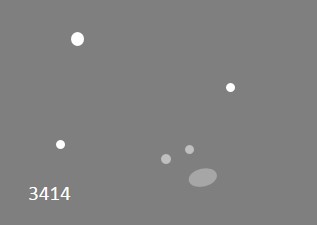 I marked this galaxy down as easy, with a good concentration in the core, and fairly
large; the H400 list shows it as magnitude 12.0. TheSky shows it as magnitude 10.8, so
that's why it was so easy; also, the galaxy is very easy to find because it sits right in
between two bright stars. I marked this galaxy down as easy, with a good concentration in the core, and fairly
large; the H400 list shows it as magnitude 12.0. TheSky shows it as magnitude 10.8, so
that's why it was so easy; also, the galaxy is very easy to find because it sits right in
between two bright stars. |
| 161 | 3432 | June 14, 2018 | 13.1" dob | Blue Ridge Parkway | Leo Minor | I noted that this magnitude 12 galaxy gave the appearance of being fairly large, no central condensation, and a definite oblong shape in the style of a lenticular galaxy, although I don't know if this is one; my sketch showed that this galaxy was positioned right in between two field stars, which were on either end of the long dimension of the galaxy. This image from Gregg's Astronomy shows that it doesn't fit the category of being a lenticular, but it does definitely present a very elongated aspect. |
| 162 | 3486 | June 14, 2018 | 13.1" dob | Blue Ridge Parkway | Leo Minor | This magnitude 11.0 galaxy was not hard at all to see; I noted a fairly evenly distributed brightness across the face of the galaxy without much of any kind of central condensation or core. |
| 163 | 3489 | Mar 5, 2018 | 13.1" dob | 213 OLC | Leo | This was my second attempt at this galaxy, and again I had some initial difficulty in locating it, but then suddenly I found it and realized how bright and easy this galaxy is ~ I could not see any structure, but a definite concentration toward the center and hazy glow decreasing in brightness going outward from the core. The Sky cites a magnitude of 10.30, which seems about right as that would be bright compared to many galaxies. |
| 164 | 3504 | June 14, 2018 | 13.1" dob | Blue Ridge Parkway | Leo Minor | I was able to see this galaxy easily but only noted that it showed an evenly distributed brightness across its face, i.e., not any noticeable central brightening. |
| 165 | 3521 | Jan 6, 2019 | 13.1" dob | Blue Ridge Parkway | Leo | On this cold, windy, but very clear night, I saw this galaxy as quite elongated, with a good core, fairly large, and possible structure in the hazy part immediately around the core; it was very easy to see at 76x. |
| 167 | 3593 | Mar 5, 2018 | 13.1" dob | 213 OLC | Leo | Just like with 3489 above, I had difficulty in locating this galaxy, which I have never before observed, but once I came back to the area and swept a bit with the telescope, I found and realized that it was fairly easy. I could not detect any structure, but a definite fuzzy spot with a core. It made up the fourth point in an almost diamond-shaped group to the west of the central star in a 3-star alignment. |
| 168 | 3607 | Mar 5, 2018 | 13.1" dob | 213 OLC | Leo | I am not sure if I've ever observed this galaxy and its companion before, but this time, even in my driveway with headlights coming over the crest of the hill shining into my face, I could easily see 3607 and its companion 3608; they were both bright, although 3607 a bit brighter and larger; it had a central concentration but otherwise I could not detect any structure. |
| 169 | 3608 | Mar 5, 2018 | 13.1" dob | 213 OLC | Leo | Just the same as above, easy to locate and easy to see, just a tad smaller and dimmer than 3607. These two galaxies would be a great target under really dark skies. |
| 170 | 3610 | July 14, 2018 | 13.1" dob | Blue Ridge Parkway | Ursa Major | This galaxy was tiny by comparison to some of the other galaxies in Ursa Major on the H400 list, but easy to see because it was bright, with a noticeable core; my notes indicate that I thought it looked like a fuzzy star more than anything, because there was very little of the hazy outer areas of a galaxy surrounding the core. |
| 171 | 3613 | July 14, 2018 | 13.1" dob | Blue Ridge Parkway | Ursa Major | 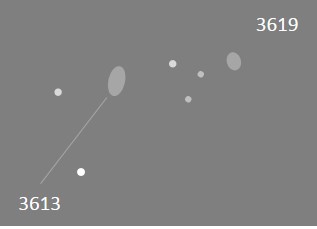 This next grouping of galaxies
was an interesting pair; I noted that NGC 3613 seemed larger than NGC 3610 above, but
not as obvious; there was hardly any elongation to notice and only a slight condensation
in the core; comparing the image below in the entry for NGC 3619 with my sketch, it
seems I drew the three stars making a squarish L with NGC 3613 pretty accurately, but
I did not draw the other two closer to NGC 3619 very well. This next grouping of galaxies
was an interesting pair; I noted that NGC 3613 seemed larger than NGC 3610 above, but
not as obvious; there was hardly any elongation to notice and only a slight condensation
in the core; comparing the image below in the entry for NGC 3619 with my sketch, it
seems I drew the three stars making a squarish L with NGC 3613 pretty accurately, but
I did not draw the other two closer to NGC 3619 very well. |
| 172 | 3619 | July 14, 2018 | 13.1" dob | Blue Ridge Parkway | Ursa Major | 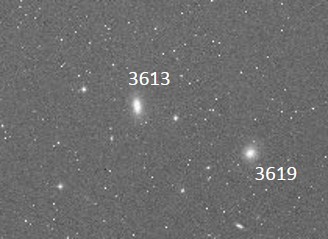 This image shows the DSS survey
field around NGC 3613 (above) and NGC 3619, as labeled; I noted that 3619 was markedly
fainter than 3613, barely visible in fact, displaying no core nor elongation that I
could see. In this image, north is to the left, because I rotated it to match
the sketch I made shown above. This DSS image shows them with the same surface
brightness, and from it one would think they should be about equally visible, but I
did not find that to be the case. This image shows the DSS survey
field around NGC 3613 (above) and NGC 3619, as labeled; I noted that 3619 was markedly
fainter than 3613, barely visible in fact, displaying no core nor elongation that I
could see. In this image, north is to the left, because I rotated it to match
the sketch I made shown above. This DSS image shows them with the same surface
brightness, and from it one would think they should be about equally visible, but I
did not find that to be the case. |
| 173 | 3621 | Mar 27, 2019 | 150mm f/5 Achromat | 213 OLC | Hydra | This galaxy was seen with difficulty, most likely because I was not dark adapted, and was observing from my front porch while lights were on in the house; the sky was clear and dark however, so even without preparing myself for observing, I was able to detect the galaxy. I used only 38x with the short focus refractor, and was able to see the galaxy as somewhat elongated and possibly even with some of the mottling that should define it. |
| 174 | 3626 | Mar 5, 2018 | 13.1" dob | 213 OLC | Leo | A first-time observation of this galaxy ~ it was definitely a slightly lesser sight than the 3607/3608 pair, but still not hard to detect. I could not see any structure, only an indistinct hazy glow. |
| 175 | 3628 | Mar 16, 2018 | 13.1" dob | 213 OLC | Leo | On this evening, which at the time of my observation was slightly hazy, dry, but also with some high clouds, and the ever-present lights shining into my face, I was barely able to detect this galaxy, which I have nevertheless observed many times. On this night, I was just able to detect the galaxy and see its orientation. M66 and M65 were easy to see, and moving in the right direction from them easily swept up the galaxy. |
| 176 | 3631 | July 14, 2018 | 13.1" dob | Blue Ridge Parkway | Ursa Major | This galaxy looked like a face-on spiral to me, because of its very low surface brightness, almost no core to be seen, and the fact that it appeared large and faint. Apparently, this galaxy hosted a supernova in 2016, as shown in this image from virtualtelescope.eu, in which it is also clear that I was correct in my supposition that it looked like a face-on spiral. |
| 177 | 3640 | June 14, 2018 | 13.1" dob | Blue Ridge Parkway | Leo | 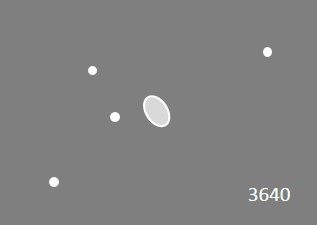 Still faint
twilight when I made this observation; it
was difficult, but showed a strong central condensation in the core. Comparing my sketch to
this image shows I had the right object. It
took me a while to identify the galaxy even though I was sure that I was looking in the right general
vicinity; a combination of being twilight and only about 30 degrees above the western horizon resulted
in the difficulty. Still faint
twilight when I made this observation; it
was difficult, but showed a strong central condensation in the core. Comparing my sketch to
this image shows I had the right object. It
took me a while to identify the galaxy even though I was sure that I was looking in the right general
vicinity; a combination of being twilight and only about 30 degrees above the western horizon resulted
in the difficulty.I observed this galaxy again on Jan 6, 2019, when I was trying to clean up my last remaining object in Leo, and wasn't sure which one I had missed, so on this cold, windy, and very clear night, with this galaxy higher up in the eastern sky, I noted it as very easily visible, small, with a strong core, but no structure visible. It immediately came into view as soon as I moved it into the field of view (no straining to make it out on this night!) |
| 178 | 3655 | Mar 16, 2018 | 13.1" dob | 213 OLC | Leo | This 11.6 magnitude galaxy was difficult to find, especially given the sky conditions. At first I could not located it, but then I came back outside 30 minutes later and the conditions seemed to have improved, so I was finally able to see a faint smudge at the given location ~ I could not detect any structure, orientation, or anything about it except that it seemed to be noticeably larger than NGC 2811 in Hydra or NGC 2613 in Pyxis. My sketch of the star field leading to the galaxy matches the chart: from 81 Leonis, there are two wide pairs of stars at different alignments that point toward NGC 3655. I observed it again from Big Spy Mtn Overlook on the Blue Ridge Parkway on June 14, 2018 and in the dark skies there found it to be easy, with a strong core compared to the fainter outer regions of the galaxy. |
| 179 | 3665 | July 14, 2018 | 13.1" dob | Blue Ridge Parkway | Ursa Major | 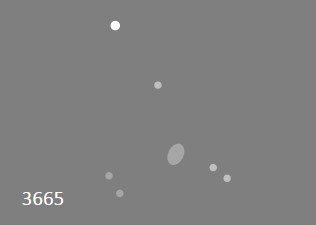 This is my first observation of
this galaxy, and it showed a noticeable core, and although it was not very large, it
was very obvious as a galaxy; I could not detect any noticeable orientation or
elongation. I also noted that averted vision was essential to keeping the
galaxy in view. Some interesting things regarding the entry for this galaxy
in TheSky software: first off, the detailed attributes claim that it's in
Leo, but clearly it plots out way up in Ursa Major as it is supposed to; secondly,
the description reads, "Round galaxy with bright core", and they list it at magnitude
10.8, considerably brighter than the 12.5 given in the H400 list. Unlike many
of the other galaxies on this list, my impression at the eyepiece is much more in
line with the 12.5 magnitude figure, rather than the brightness listed in TheSky.
Unfortunately, I cannot square the sketch that I made with the image of the wide field
around the galaxy from the DSS site; is it possible that I had the wrong object?
Maybe I was really looking at NGC 3658, who knows? This is my first observation of
this galaxy, and it showed a noticeable core, and although it was not very large, it
was very obvious as a galaxy; I could not detect any noticeable orientation or
elongation. I also noted that averted vision was essential to keeping the
galaxy in view. Some interesting things regarding the entry for this galaxy
in TheSky software: first off, the detailed attributes claim that it's in
Leo, but clearly it plots out way up in Ursa Major as it is supposed to; secondly,
the description reads, "Round galaxy with bright core", and they list it at magnitude
10.8, considerably brighter than the 12.5 given in the H400 list. Unlike many
of the other galaxies on this list, my impression at the eyepiece is much more in
line with the 12.5 magnitude figure, rather than the brightness listed in TheSky.
Unfortunately, I cannot square the sketch that I made with the image of the wide field
around the galaxy from the DSS site; is it possible that I had the wrong object?
Maybe I was really looking at NGC 3658, who knows? |
| 180 | 3675 | July 14, 2018 | 13.1" dob | Blue Ridge Parkway | Ursa Major | 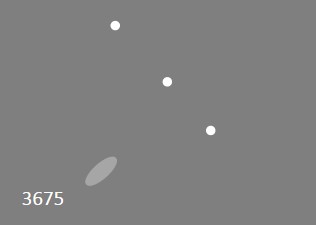 This is also my first ever viewing
of this galaxy; I noted that it appeared large, with a low surface brightness, enough
of a core to be noticeable, but not very pronounced; the elongated nature of it was
very pronounced, as was the orientation, indicated in the sketch. This is also my first ever viewing
of this galaxy; I noted that it appeared large, with a low surface brightness, enough
of a core to be noticeable, but not very pronounced; the elongated nature of it was
very pronounced, as was the orientation, indicated in the sketch. |
| 181 | 3686 | June 14, 2018 | 13.1" dob | Blue Ridge Parkway | Leo | 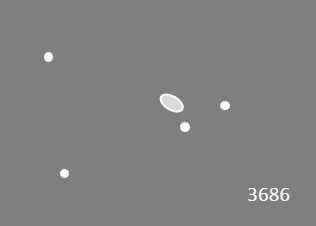 I
attempted this galaxy from 213 OLC once but the skies
were not great and ended up not being able to see it, but here on the Blue Ridge Parkway, I learned why
it could not be seen from home ~ it was still not easy here! I saw it as faint, somewhat extended,
no discernible core, and larger than other galaxies I have been observing, so a low surface brightness
object. I
attempted this galaxy from 213 OLC once but the skies
were not great and ended up not being able to see it, but here on the Blue Ridge Parkway, I learned why
it could not be seen from home ~ it was still not easy here! I saw it as faint, somewhat extended,
no discernible core, and larger than other galaxies I have been observing, so a low surface brightness
object. |
| 182 | 3726 | July 14, 2018 | 13.1" dob | Blue Ridge Parkway | Ursa Major | Even though this galaxy was listed in the H400 list as being of magnitude 11.0, which is quite bright for most of the galaxies listed here, I found this one to be large and faint, indicating very low surface brightness; it did not show much of a core to me, and was clearly elongated. |
| 183 | 3729 | June 15, 2018 | 13.1" dob | Blue Ridge Parkway | Ursa Major | Even though this galaxy is listed at magnitude 13.0 in the H400 table, I was able to see it without difficulty, although it was faint, moderately sized, no discernible core, and therefore had a rather low surface brightness; I saw that it was located close to NGC 3718, which is brighter. This is my first observation of this galaxy (either one in fact), but they are a nice pair, so I will definitely revisit them. |
| 184 | 3810 | June 14, 2018 | 13.1" dob | Blue Ridge Parkway | Leo | Compared to 3686 above, this was fairly easy, even in the faint twilight that still shone in that part of the sky ~ this 11.5 magnitude galaxy was pretty concentrated, so it had a high surface brightness. |
| 185 | 3813 | June 15, 2018 | 13.1" dob | Blue Ridge Parkway | Ursa Major | I saw this galaxy as elongated, rather faint, and no discernible core; it presented a low surface brightness; I didn't see anything noticeable or remarkable about this object. |
| 186 | 3877 | June 15, 2018 | 13.1" dob | Blue Ridge Parkway | Ursa Major | Even though the H400 list indicates this galaxy is magnitude 12.0, I saw it as faint, very elongated, with a low surface brightness, and seemed to me to be oriented in approximately a north-south direction; very easy to locate this object since it is just to the southeast of Chi UMa. |
| 187 | 3893 | June 15, 2018 | 13.1" dob | Blue Ridge Parkway | Ursa Major | 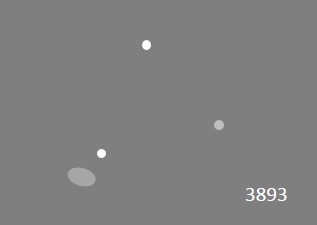 This galaxy was listed at magnitude 11.5 in the H400 table, but 11.0 in TheSky,
and I saw it as fairly bright, rather large compared to many of the galaxies that I have
been observing this night, but not much of a core; from a wide angle image of this object
one can see that this is a face-on spiral, but with the inner arms fairly bright, which
could contribute to the view that the core and inner arms are almost equally bright; I
probably could not see the outer arms. This galaxy was listed at magnitude 11.5 in the H400 table, but 11.0 in TheSky,
and I saw it as fairly bright, rather large compared to many of the galaxies that I have
been observing this night, but not much of a core; from a wide angle image of this object
one can see that this is a face-on spiral, but with the inner arms fairly bright, which
could contribute to the view that the core and inner arms are almost equally bright; I
probably could not see the outer arms. |
| 188 | 3898 | June 15, 2018 | 13.1" dob | Blue Ridge Parkway | Ursa Major | 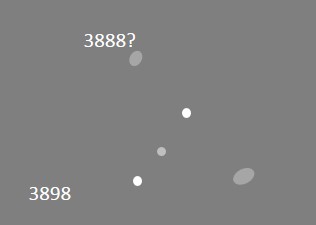 I noted this galaxy as being small, with a noticeable core and a high surface
brightness, but a decent amount of less-bright area surrounding the core; this image from www.phys.ttu.edu shows
that I had the correct object since I sketched the three field stars in a row making a
triangle with the galaxy; compare my sketch with this DSS
image to see how 3898 is situated compared to the three stars in a row and NGC 3888
to the lower right (southwest) in the image. I also noted that 3888 was clearly
smaller than 3898, as seen in the DSS image. I noted this galaxy as being small, with a noticeable core and a high surface
brightness, but a decent amount of less-bright area surrounding the core; this image from www.phys.ttu.edu shows
that I had the correct object since I sketched the three field stars in a row making a
triangle with the galaxy; compare my sketch with this DSS
image to see how 3898 is situated compared to the three stars in a row and NGC 3888
to the lower right (southwest) in the image. I also noted that 3888 was clearly
smaller than 3898, as seen in the DSS image. |
| 189 | 3900 | June 14, 2018 | 13.1" dob | Blue Ridge Parkway | Leo | 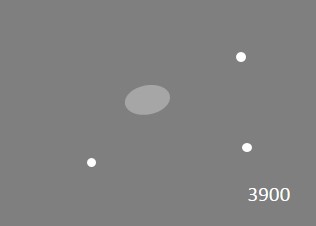 Twilight
was over by now; this 12.5 magnitude galaxy
was pretty easy, appearing fairly bright; this image of NGC 3900 shows the same
rough orientation to the three field stars that I observed, so I am confident I had the correct object;
make adjustments for mirror-reversal, upside-downness, and orientation LOL. Twilight
was over by now; this 12.5 magnitude galaxy
was pretty easy, appearing fairly bright; this image of NGC 3900 shows the same
rough orientation to the three field stars that I observed, so I am confident I had the correct object;
make adjustments for mirror-reversal, upside-downness, and orientation LOL. |
| 190 | 3912 | June 14, 2018 | 13.1" dob | Blue Ridge Parkway | Leo | This galaxy was very difficult to identify; even though I was sure I had found the correct location, I could not see anything using the 20mm eyepiece at 76x, so I switched to the 12.4mm for 123x, and once I did that, I was able to see the magnitude 13 galaxy, although it was faint, with no discernible central condensation, so it must be a low surface brightness object in addition to being faint overall. |
| 191 | 3938 | June 15, 2018 | 13.1" dob | Blue Ridge Parkway | Ursa Major | 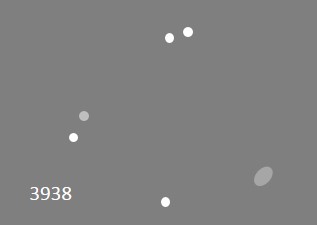 Even though this galaxy is listed as
magnitude 11.0 on the H400 list, and rates 10.4 in TheSky, I noted that it was not very
bright, had a low surface brightness, was rather large, and no discernible core.
I guess I'm not JLE Dreyer, who described it as "bright" LOL. This image from kopernik.org shows
that NGC 3938 is a face-on spiral, which could explain its low surface brightness, although
it clearly shows a star-like core on the image, not sure why I didn't see that. Even though this galaxy is listed as
magnitude 11.0 on the H400 list, and rates 10.4 in TheSky, I noted that it was not very
bright, had a low surface brightness, was rather large, and no discernible core.
I guess I'm not JLE Dreyer, who described it as "bright" LOL. This image from kopernik.org shows
that NGC 3938 is a face-on spiral, which could explain its low surface brightness, although
it clearly shows a star-like core on the image, not sure why I didn't see that. |
| 192 | 3941 | June 15, 2018 | 13.1" dob | Blue Ridge Parkway | Ursa Major | I noted NGC 3941 as being elongated, a very noticeable core, not too much of a hazy halo, and oriented north-south I think. Although the description by JLE Dreyer says it is "round", this image from in-the-sky.org shows that it is indeed oblong as I saw it. |
| 193 | 3945 | June 15, 2018 | 13.1" dob | Blue Ridge Parkway | Ursa Major | My notes for this galaxy indicate that I saw it as small, most prominent was the core, and the surrounding haze of the arms or outer region was slight; I did not think it was bright, but it did have a high surface brightness compared to some of the galaxies that I have been observing. |
| 194 | 3949 | June 15, 2018 | 13.1" dob | Blue Ridge Parkway | Ursa Major | I saw this galaxy has not having much of a core region, but rather it presented an overall evenly bright hazy appearance; it was small with an even surface brightness across its face. |
| 195 | 3953 | June 15, 2018 | 13.1" dob | Blue Ridge Parkway | Ursa Major | I saw this galaxy as quite large, similar to M109 in appearance, not much of a core, and maybe I even detected some mottling across the surface (I was using a 20mm eyepiece for 76x). This galaxy was easy to find, being just south of gamma UMa (Phecda). Since it is so close to M109, I wondered if the two were related, and indeed, according to Anne's Astronomy News, it is a member of the M109 group, with NGC 3953 being about 56 million light years distant. |
| 196 | 3962 | Feb 3, 2019 | 13.1" dob | 213 OLC | Crater | 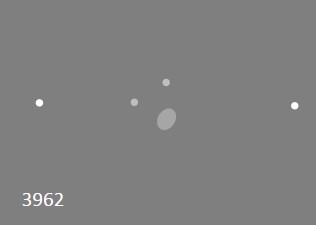 In rather poor skies in the early morning
hours of February 3, with haze and humidity in the air and some light pollution, I could
see this galaxy without difficulty, but not with any structure or detail; I saw it as small,
concentrated, and fairly bright, but could not see any of the extended regions beyond the
core. It was situated nicely in a triangle with two field stars, and the group of
three was set in between two opposing stars in a line. In rather poor skies in the early morning
hours of February 3, with haze and humidity in the air and some light pollution, I could
see this galaxy without difficulty, but not with any structure or detail; I saw it as small,
concentrated, and fairly bright, but could not see any of the extended regions beyond the
core. It was situated nicely in a triangle with two field stars, and the group of
three was set in between two opposing stars in a line.This wide-angleimage from lex nicely shows the relationship of the galaxy to the two field stars that I noted. My observation was with a 20mm erfle which yielded 76x. |
| 197 | 3982 | June 15, 2018 | 13.1" dob | Blue Ridge Parkway | Ursa Major | My notes for this object indicate that I saw it as faint, with no discernible core, and not as easy to see as NGC 3998, two objects below in this list. This is located north and slightly east of Phecda among a group of about five galaxies. |
| 198 | 3992 | June 15, 2018 | 13.1" dob | Blue Ridge Parkway | Ursa Major | A little unusual to have a Messier object in the list, but this is M109; I saw it as large compared to other galaxies that I have been observing (no surprise), but surprisingly low surface brightness, and definitely elongated in a sort of east-west direction. |
| 199 | 3998 | June 15, 2018 | 13.1" dob | Blue Ridge Parkway | Ursa Major | I saw this galaxy as small, bright, good surface brightness, a very noticeable core, but I did not make any notes about a companion galaxy; NGC 3990 is just to the west of this galaxy but apparently I did not see it. TheSky rates 3990 as magnitude 12.6, which means that if it were to be placed on the scale of objects in the H400 list I have, it would probably be around 13.5, which is quite faint. Going by this image, I might have just assumed that NGC 3990 (to the right of NGC 3998 in the picture) was a field star. |
| 200 | 4026 | June 15, 2018 | 13.1" dob | Blue Ridge Parkway | Ursa Major | I saw this galaxy as very elongated with a bright core, and the arms or outer regions rather faint; it was situated fairly close to a bright field star, positioned at about a 30 degree angle from "tangent" to the star. This image by Martin Germano is a good representation of what I saw in terms of the galaxy's position relative to that star above and to the left of the galaxy in his image. His image also suggests that my impression of a prominent core and weaker outer regions is accurate. |
| 201 | 4027 | Feb 3, 2019 | 13.1" dob | 213 OLC | Corvus | 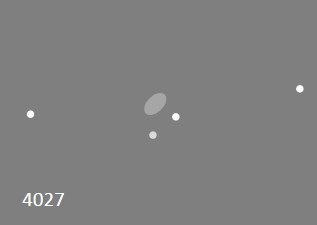 I had no difficulty in locating this galaxy
on a poor early February morning, although due to the conditions, I was not able to see
much of it; I noted that it was faint, just a roundish glow, and with a surprisingly similar
presentation as NGC 3962 in Crater from the standpoint of its relationship to field stars; I
noted that it made a nearly equilateral triangle with two faint stars, and the grouping was
situated in between two other stars farther apart which made a line with the galaxy and its
two attendants. I had no difficulty in locating this galaxy
on a poor early February morning, although due to the conditions, I was not able to see
much of it; I noted that it was faint, just a roundish glow, and with a surprisingly similar
presentation as NGC 3962 in Crater from the standpoint of its relationship to field stars; I
noted that it made a nearly equilateral triangle with two faint stars, and the grouping was
situated in between two other stars farther apart which made a line with the galaxy and its
two attendants.For this galaxy and the next one, NGC 4038, this image from dslr-astrophotography.com shows how close they are together and the pair of stars just to the north of NGC 4027 that I noted at the eyepiece. My observation was with a 20mm erfle which yielded 76x. |
| 202 | 4030 | June 14, 2018 | 13.1" dob | Blue Ridge Parkway | Virgo | This galaxy was given as magnitude 11.5 in the H400 list, and my notes indicate that I saw it as easy and bright, between two stars, and that the halo around the central part was also pretty bright. Based on this page from phys.ttu.edu, I correctly identified the galaxy as being between the two bright stars and slightly offset from a line between the two; I did not see the halo extending out to make contact with the two stars, so my view was more like the top image in the linked page. I did not make any note of the spiral structure that clearly shows on both of the images. |
| 203 | 4036 | June 15, 2018 | 13.1" dob | Blue Ridge Parkway | Ursa Major | My notes indicate I saw this galaxy as having a good surface brightness, elongated east-west, and a strong core. This is another one for which TheSky shows a much lower magnitude number (10.6) than the H400 list (12.0); based on my observing skills, I would say the ease with which I saw this galaxy suggests that the 10.6 is more in line with what I saw. Locating this galaxy is fairly easy, by the way, because it's situated somewhat to the northeast of a prominent arc of three stars that curve toward the southeast and descend in brightness with a nice even gradient ~ easy to see in the finder. |
| 204 | 4038 | Feb 3, 2019 | 13.1" dob | 213 OLC | Corvus | I have observed the antennae galaxy pair (this one
along with NGC 4039) on several occasions, including with the 13" dob, although I did not make any
notes in earlier sessions. Although I don't have any doubts as to my ability to correctly
locate and identify the galaxy(ies) in the eyepiece, this very nice DSLR Image of the
pair shows the surrounding star field for comparison's sake. On this hazy and rather humid but cold night of not very good transparency, I was able to see this galaxy fairly easily, but the structure was not apparent; it was easier to see than NGC 4027, with a bit more concentration, but for example the tails were totally invisible. It did appear a bit larger than 4027. My observation was with a 20mm erfle which yielded 76x. |
| 205 | 4041 | June 15, 2018 | 13.1" dob | Blue Ridge Parkway | Ursa Major | This galaxy is located just to the northeast of NGC 4036 (the above listing), so they make a good pair in a low power eyepiece; when you first pick these galaxies up, you have to make sure you know which is which to make a positive identification! I noted that 4041 had about the same surface brightness as 4036, but it was smaller and rounder; this site from jwinman.com has an image in the middle of the page that shows the two galaxies together ~ 4041 is the rounder galaxy to the upper left, and 4036 the elongated one in the middle; this matches what I noted in terms of their shape. |
| 206 | 4051 | June 15, 2018 | 13.1" dob | Blue Ridge Parkway | Ursa Major | I noted this galaxy was faint, large, no discernible core, and adjacent to a field star; I did not think this was an easy object. This image from jwinman shows that this galaxy is a barred spiral, and based on its appearance I would say that my initial impression that it had an even surface brightness is an accurate view; interestingly, he cites a distance of only 32 million light years for this galaxy, which would be much closer than many of the other galaxies that I've observed so far. |
| 207 | 4085 | June 15, 2018 | 13.1" dob | Blue Ridge Parkway | Ursa Major | This was one of the more difficult galaxies to see in the entire evening; I noted that it was very faint, even barely discernible. The magnitude of this galaxy is 13.0 according to the H400 list, so that explains why it was difficult to see. |
| 208 | 4088 | June 15, 2018 | 13.1" dob | Blue Ridge Parkway | Ursa Major | 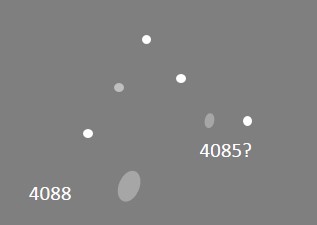 According to my sketch, this galaxy is situated close to 4085; I noted that 4088
was large, had an even brightness across its face, and no discernible core; based on the
middle image on this site
by jwinman, I had the correct object, since you can see the mirror-reversed view of 4088
which is the distorted barred spiral, the pattern of field stars, and then 4085 above 4088.
he cites a distance of 52 million light years for 4088, which puts it at about the
normal distance for most of these Ursa Major galaxies. Also, his image shows that 4088
has an even brightness across its face with very little brightening toward the center, which
matches what I observed. According to my sketch, this galaxy is situated close to 4085; I noted that 4088
was large, had an even brightness across its face, and no discernible core; based on the
middle image on this site
by jwinman, I had the correct object, since you can see the mirror-reversed view of 4088
which is the distorted barred spiral, the pattern of field stars, and then 4085 above 4088.
he cites a distance of 52 million light years for 4088, which puts it at about the
normal distance for most of these Ursa Major galaxies. Also, his image shows that 4088
has an even brightness across its face with very little brightening toward the center, which
matches what I observed. |
| 209 | 4102 | June 15, 2018 | 13.1" dob | Blue Ridge Parkway | Ursa Major | I noted that this galaxy, given as magnitude 12.5 in the H400 list, was not bright, but with a very noticeable core, and with enough of a halo of fainter outer nebulosity to clearly identify it as a galaxy. It is fairly easy to locate, by continuing on in a straight line from Gamma Ursa Majoris (Phecda) through M109 and on to a magnitude 8 star and then slightly southeast to find NGC 4102. Dreyer said this galaxy was "bright" LOL. |
| 210 | 4111 | Jul 14, 2018 | 13.1" dob | Blue Ridge Parkway | Canes Ventatici | I saw this galaxy, which I don't think I have ever observed before, as bright and small, with a very noticeable core, and easy to distinguish from a stellar object partly because it is adjacent to a star. See the below entry for an interesting comparison of this galaxy with the next one in the list. |
| 211 | 4143 | Jul 14, 2018 | 13.1" dob | Blue Ridge Parkway | Canes Ventatici | This galaxy was also (like NGC 4111 above) bright and concentrated, but somewhat larger than 4111, and also adjacent to a star. I described it as also being rather small, just a bit larger than 4111. Upon checking online for an image of the two galaxies, the differences become clear: it's interesting that I made no note of the spindle-like nature of 4111, but the fact that both are near stars and that NGC 4143 is clearly larger are demonstrated in the picture. |
| 212 | 4147 | Jan 6, 2019 | 13.1" dob | Blue Ridge Parkway | Coma Berenices | At 76x, on a cold, windy, and very transparent night, I could see this globular cluster easily; it was small but bright, not resolved in the core but quite concentrated; it definitely looked like a globular cluster instead of a round galaxy in the manner of the tapering of the outer regions. |
| 213 | 4150 | Jan 6, 2019 | 13.1" dob | Blue Ridge Parkway | Coma Berenices | I noted this galaxy as small and rather dim, very concentrated, not difficult to see; it was obvious in the field of view once I swept it up; moving around the area at 76x, however, I also noted the galaxy NGC 4136 to the southwest of it (at the angle of the sky I was seeing them, however, it was "straight over to the right") and how that galaxy showed a completely different appearance than 4150; 4136 was large and dim, very diffuse by comparison ~ my impression is similar to Dreyer's notes according to TheSky planetarium software that I use. See this finder chart for five of the Herschel 400 galaxies in northwestern Coma Berenices (there is an extra one noted, NGC 4136). |
| 214 | 4151 | Jul 14, 2018 | 13.1" dob | Blue Ridge Parkway | Canes Ventatici | 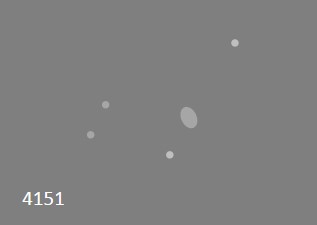 I noted this galaxy as being bright but
small, with a pronounced concentration in the core; this image
from flickr shows the orientation of the field stars that I sketched (turned upside down)
and also shows the supernova that apparently was detected in the first half of 2018 in this
galaxy ~ a good example of the problem with my strategy of not researching the objects first
before going out to observe them. this one is probably not bright enough to see visually,
but there could be cases for which one could see it. Incidentally, this galaxy is also
known as The
Eye of Sauron galaxy. I noted this galaxy as being bright but
small, with a pronounced concentration in the core; this image
from flickr shows the orientation of the field stars that I sketched (turned upside down)
and also shows the supernova that apparently was detected in the first half of 2018 in this
galaxy ~ a good example of the problem with my strategy of not researching the objects first
before going out to observe them. this one is probably not bright enough to see visually,
but there could be cases for which one could see it. Incidentally, this galaxy is also
known as The
Eye of Sauron galaxy. |
| 215 | 4179 | June 14, 2018 | 13.1" dob | Blue Ridge Parkway | Virgo | 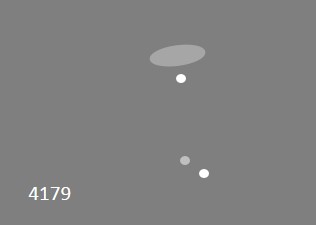 My notes indicate that I thought this galaxy looked like an edge-on spiral, with
a strong core. Compared to many of the galaxies that I've observed this evening, this
one was significantly more elongated, and even though it was listed as magnitude 12.0, the
surface brightness gave me the impression that it was a fairly bright object. Based
on this image, I correctly identified
the galaxy because the star pattern of the three stars extending to the upper left from the
galaxy match what I drew in the sketch. My notes indicate that I thought this galaxy looked like an edge-on spiral, with
a strong core. Compared to many of the galaxies that I've observed this evening, this
one was significantly more elongated, and even though it was listed as magnitude 12.0, the
surface brightness gave me the impression that it was a fairly bright object. Based
on this image, I correctly identified
the galaxy because the star pattern of the three stars extending to the upper left from the
galaxy match what I drew in the sketch. |
| 216 | 4203 | Jan 6, 2019 | 13.1" dob | Blue Ridge Parkway | Coma Berenices | This galaxy appeared fairly round, bright, but small, with a pronounced core, and situated right next to a prominent field star. This is an excellent wide angle view of the galaxy among the nearby stars, on Dan Crowson's flickr page. It was not difficult to locate the vicinity in the finder scope and see the galaxy immediately in the field of view without the need for sweeping. |
| 217 | 4214 | Jul 14, 2018 | 13.1" dob | Blue Ridge Parkway | Canes Ventatici | I am pretty sure that I have observed NGC 4214 before since it is shown as being rather large on SkyAtlas 2000.0, and I noted it as being large, faint, elongated, and near a star which was situated just off one of the ends of the spindle-shaped galaxy. The Herschel 400 list shows that this galaxy shines at magnitude 10.5, while TheSky lists it as 9.69 and includes Dreyer's description of it being "Considerably bright, considerably large, irregular". After looking at this image of NGC 4214 by Jeff Johnson on flickr, I think I observed the correct galaxy, since if you consider only the central brighter part of the galaxy, it's clear that it is oriented toward the star at one end, which is the way I sketched it. This object certainly warrants another look under better conditions (when it's high in the sky and perhaps more transparent). |
| 218 | 4216 | June 14, 2018 | 13.1" dob | Blue Ridge Parkway | Virgo | I have definitely observed this object before, and although I know that it was large and bright, I did not recall how interesting a sight it is in the eyepiece: a long sliver with a central condensation; this image from wikipedia shows a great view of the galaxy and gives an indication of why I thought it presented a very interesting appearance in the eyepiece. I did not note any of the dust lanes or any other detail, but the shape was obvious. Another visit to this object under dark skies in the future is definitely warranted! |
| 219 | 4245 | Jan 6, 2019 | 13.1" dob | Blue Ridge Parkway | Coma Berenices | Under cold, windy, and very clear, transparent conditions, this galaxy appeared to be of medium size, with a rather low surface brightness, somewhat diffuse, and not much of a core, at 76x. I was able to locate this and several other galaxies in the Coma region by way of a distinctive asterism that resembled a squat version of the water jar in Aquarius; |
| 220 | 4251 | Jan 6, 2019 | 13.1" dob | Blue Ridge Parkway | Coma Berenices | At 76x, I noted this galaxy as being small, bright, rather concentrated, and easy to pick out; the conditions were cold, windy, and very transparent, so that made the job much easier! This object is easy to locate on the northwestern fringes of the cluster Melotte 111, as seen in this finder chart. |
| 221 | 4258 | Jul 14, 2018 | 13.1" dob | Blue Ridge Parkway | Canes Ventatici | This is M106, so I have definitely observed this galaxy many times, often with ease; in this case, I saw it as large, elongated, with a strongly concentrated core, and possibly mottling near the center. The viewing conditions were not ideal on this night, because it was low in the northwest where there was some skyglow. |
| 222 | 4261 | June 14, 2018 | 13.1" dob | Blue Ridge Parkway | Virgo | I have observed this galaxy before, because I recall examining the wall of galaxies that extends northward from the stars north and west of M61, of which NGC 4261 is one of the brighter members. I noted that it was easy to see opposite of NGC 4266 when compared to a field star; this absolutely great image by Jim Thommes shows the entire field with several of the galaxies on the H400 list included. I must have noted the field star HD107258 as being the anchor point between NGC 4261 and NGC 4266; based on this image, it's clear why I did not annotate much about the appearance of 4261, because it looks like an average elliptical glow. I did have to double check myself in this area of the sky because it is so packed with galaxies; I made a note about two companion galaxies but then I scratched it out because maybe I thought those belonged to another galaxy; according to the referenced image, however, I could have seen 4264 and 4257 flanking 4261 and thought that they make up "companions" to the main galaxy ~ not sure at this point if that's what I meant or not. |
| 223 | 4273 | June 14, 2018 | 13.1" dob | Blue Ridge Parkway | Virgo | This galaxy, along with NGC 4281 below, and one that is not part of the H400 list, NGC 4270, were easy in the eyepiece at 76x according to my notes. They are clearly seen in the image by Jim Thommes above, on the rigt side of the picture. although it was bright enough to make it obvious, I did not indicate that there was anything remarkable or noteworthy about this object. |
| 224 | 4274 | Jan 6, 2019 | 13.1" dob | Blue Ridge Parkway | Coma Berenices | This was one of a pair of galaxies that I observed at the same time, and at first had some confusion as to which was which, since my alt-az motions were about 45 degrees off of the north-south motion of an equatorial, but this galaxy along with NGC 4278, were a nice pair nonetheless; at 76x, NGC 4274 was the more diffuse of the two, but still bright, and possessing a definite orientation. This excellent image on distant-lights.at website shows three of the H400 galaxies in this area and makes it clear how they compare. |
| 225 | 4278 | Jan 6, 2019 | 13.1" dob | Blue Ridge Parkway | Coma Berenices | I noted this galaxy as being slightly more concentrated than NGC 4274, it was also bright, but had less of an elongation or orientation to it, which is corroborated by the image taken at Zellerndorf in May of 2011. I did not make any note of NGC 4283, which was shown on Sky Atlas 2000.0 but not visible in my scope; conditions were excellent for galaxy observing; the skies were cold, windy, and very transparent. |
| 226 | 4281 | June 14, 2018 | 13.1" dob | Blue Ridge Parkway | Virgo | This galaxy, which is listed as being magnitude 12.5 (same as NGC 4273 above), was easy to see; to me this indicates a high surface brightness, in other words relatively small size compared to its brightness. For some reason, I did not make a note of the elongated aspect of this galaxy, but it should have been obvious. |
| 227 | 4293 | Feb 3, 2019 | 13.1" dob | 213 OLC | Coma Berenices | 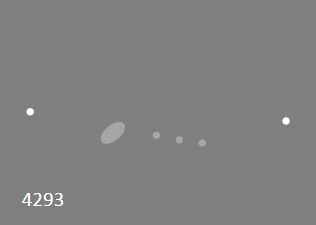 On a cold night of not very
good transparency, I was able to see this galaxy at 76x to be about the same size
as M85 nearby; there was maybe a hint of structure, but not really any concentration
to speak of; nevertheless, I thought it was easy to see, when I got it in the field
of view, I had no doubt which object the galaxy was. On a cold night of not very
good transparency, I was able to see this galaxy at 76x to be about the same size
as M85 nearby; there was maybe a hint of structure, but not really any concentration
to speak of; nevertheless, I thought it was easy to see, when I got it in the field
of view, I had no doubt which object the galaxy was. |
| 228 | 4303 | June 14, 2018 | 13.1" dob | Blue Ridge Parkway | Virgo | A little surprising that this object would be included in the H400 list, since it is M61, a large and bright galaxy. I noted that it is large and obvious compared to all the other galaxies that I have observed thus far, and that it gave the appearance of having an even illuminated hazy or fuzzy face, without much of a core in my opinion. I have observed this galaxy often before, and probably had a better view of it on other occasions, since I was viewing it rather low in the southwestern sky on this night. |
| 229 | 4314 | Mar 12, 2019 | 13.1" dob | 213 OLC | Coma Berenices | I saw this galaxy as definitely non-stellar, with a noticeable core but also a good-sized halo around the core, medium surface brightness, and with a clearly identifiable orientation, which I think based on its position in the sky and the time I observed it, is east to west more or less ~ the sky conditions on this morning were clear, transparent, slight breeze, but with some light pollution; the observation was at 76x. |
| 230 | 4346 | Jul 14, 2018 | 13.1" dob | Blue Ridge Parkway | Canes Ventatici | I doubt that I have observed this galaxy before, because my notes indicate that I saw it as tiny, looking very much like a fuzzy star; it was mostly just a core with a small region of nebulosity around it. |
| 231 | 4350 | Feb 3, 2019 | 13.1" dob | 213 OLC | Coma Berenices | I noted this galaxy as being small, with a noticeable core, rather faint, but slightly more noticeable than its companion, which is NGC 4340. My planetarium software, TheSky, lists NGC 4350 as magnitude 11.1 and NGC 4340 as magnitude 11.0, but NGC 4350 is smaller so its surface brightness must be higher, therefore more noticeable. This observation was made at 76x on a night of poor transparency, so there was quite a bit of humidity-induced sky glow. |
| 232 | 4361 | Feb 3, 2019 | 13.1" dob | 213 OLC | Corvus | I was able to find this planetary nebula easily by locating its position with the finder scope and without any sweeping it was situated in the middle of my FOV in the telescope; I saw it easily, noted that it showed more concentration than the previously observed galaxies in Corvus and Crater, and there was a clear reduction in brightness of the object with distance from the center. I could not detect any color on this occasion. |
| 233 | 4365 | June 14, 2018 | 13.1" dob | Blue Ridge Parkway | Virgo | 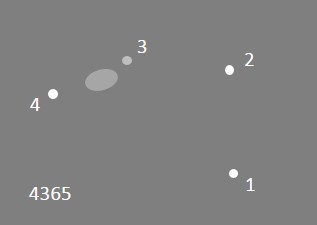 Since I only had my SkyAtlas 2000.0 with me at the observing site, I was at first
somewhat misled about this galaxy; it is not labeled correctly on the chart,
which shows it as NGC 4306, but this cannot be right according to the right ascension of the
object. In any event, I noted it as having a good core and it was easily seen.
From this annotated image based on a deep image I obtained from the Hanson Astronomy website, one can see the four
stars that I sketched and also the fact that I made no mention of other galaxies in the field
of view; this object would be very interesting to revisit with the companions in mind. Since I only had my SkyAtlas 2000.0 with me at the observing site, I was at first
somewhat misled about this galaxy; it is not labeled correctly on the chart,
which shows it as NGC 4306, but this cannot be right according to the right ascension of the
object. In any event, I noted it as having a good core and it was easily seen.
From this annotated image based on a deep image I obtained from the Hanson Astronomy website, one can see the four
stars that I sketched and also the fact that I made no mention of other galaxies in the field
of view; this object would be very interesting to revisit with the companions in mind. |
| 234 | 4371 | June 14, 2018 | 13.1" dob | Blue Ridge Parkway | Virgo | 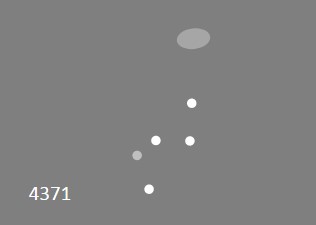 This magnitude 12.0 galaxy (according to the H400 list I have) was difficult to
locate, and when I did find it, I noted that it appeared small, but with a strong central
condensation. In this fabulous wide
angle image by Jim Thommes, NGC4371 is right in the middle, and the pattern of stars
that I sketched is fairly close to the galaxy, extending up and to the left (more up than
left) from it. It is located south of M84, but in a rather sparse area with few stars
on the chart to help guide the star-hopper to the target. A glance at the image above
shows that I didn't do a great job of sketching the proportions of the star-pattern near it
very well. This magnitude 12.0 galaxy (according to the H400 list I have) was difficult to
locate, and when I did find it, I noted that it appeared small, but with a strong central
condensation. In this fabulous wide
angle image by Jim Thommes, NGC4371 is right in the middle, and the pattern of stars
that I sketched is fairly close to the galaxy, extending up and to the left (more up than
left) from it. It is located south of M84, but in a rather sparse area with few stars
on the chart to help guide the star-hopper to the target. A glance at the image above
shows that I didn't do a great job of sketching the proportions of the star-pattern near it
very well. |
| 235 | 4394 | Feb 3, 2019 | 13.1" dob | 213 OLC | Coma Berenices | 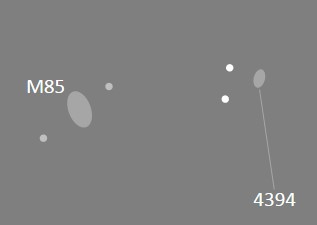 This night was mostly clear but
hazy with low transparency, and there is always some light pollution at my house, so
the conditions were not ideal; at 76x, I noted this galaxy as being clearly smaller
than M85 nearby to it, it was rather faint, but also clearly non-stellar owing to
the contrast with its two nearby field stars. This galaxy is designated as a
lenticular barred spiral, although I could not detect any of that kind of structure
or detail this evening; it would be interesting to see how much I could see under
better conditions in the spring. This image from Fred Espenak shows
the relationship of M85 and NGC 4394. On his image, the two galaxies are the
ones directly in the center. This night was mostly clear but
hazy with low transparency, and there is always some light pollution at my house, so
the conditions were not ideal; at 76x, I noted this galaxy as being clearly smaller
than M85 nearby to it, it was rather faint, but also clearly non-stellar owing to
the contrast with its two nearby field stars. This galaxy is designated as a
lenticular barred spiral, although I could not detect any of that kind of structure
or detail this evening; it would be interesting to see how much I could see under
better conditions in the spring. This image from Fred Espenak shows
the relationship of M85 and NGC 4394. On his image, the two galaxies are the
ones directly in the center. |
| 236 | 4414 | Mar 12, 2019 | 13.1" dob | 213 OLC | Coma Berenices | 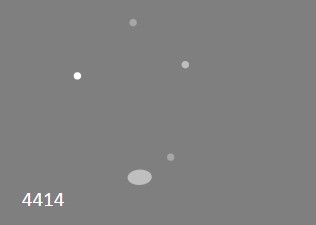 This galaxy was seen as quite bright,
with a very noticeable core, relatively high surface brightness compared to most of
the galaxies that I've observed, and a definite orientation which is hard for me to
tell because I'm using a dobsonian near the zenith, so since it was toward the west
a little bit, I can't tell how it was oriented; it made a nice Southern Cross-like
pattern with four other field stars. This galaxy was seen as quite bright,
with a very noticeable core, relatively high surface brightness compared to most of
the galaxies that I've observed, and a definite orientation which is hard for me to
tell because I'm using a dobsonian near the zenith, so since it was toward the west
a little bit, I can't tell how it was oriented; it made a nice Southern Cross-like
pattern with four other field stars. |
| 237 | 4419 | Feb 3, 2019 | 13.1" dob | 213 OLC | Coma Berenices | 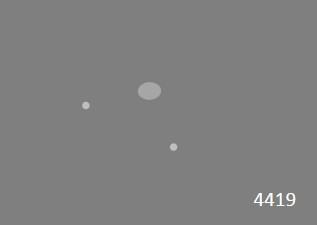 I noted this galaxy as being
not too faint or small, but in the skies that early morning, which were of poor
transparency, I did not detect anything noteworthy about it; there could have been
some elongation in the manner shown in the sketch relative to the two field stars
below the galaxy. I noted this galaxy as being
not too faint or small, but in the skies that early morning, which were of poor
transparency, I did not detect anything noteworthy about it; there could have been
some elongation in the manner shown in the sketch relative to the two field stars
below the galaxy.The two field stars that I included in the sketch are the two stars above the galaxy in this image on cloudynights.com uploaded by user elpajare; his or her picture shows the orientation of the galaxy in a manner that validates my sketch. I used a 20mm erfle eyepiece that yielded 76x on this evening; I should revisit this object in better skies in the mountains in the spring to see if I can detect more of its nature. |
| 238 | 4429 | June 14, 2018 | 13.1" dob | Blue Ridge Parkway | Virgo | 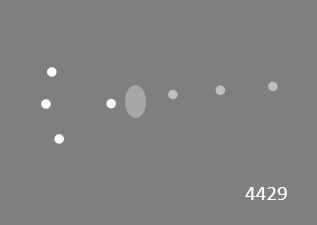 Given as magnitude 11.5 in the H400 list, my notes indicate that this galaxy was
easy and bright, near a star, and exhibiting some central condensation; the word I used to
characterize in the notes was "obvious", which means that I saw it immediately. It's
surface brightness is above average compared to the other galaxies that I have seen during
the evening because it is bright but not too large. I'm not sure that I realized the
fact that this galaxy is very close to NGC 4371 above, so they both appear on this wide angle image on flickr by
Dan Crowson; based on the image the view that I sketched is accurate but if you look up and
to the left of the galaxy, the brightest star in his image is not included in my sketch, so
it doesn't quite look the same. I included the three not-very-bright stars above the
galaxy, the one just above it, and the trailing group of three leading directly downward
from it. Given as magnitude 11.5 in the H400 list, my notes indicate that this galaxy was
easy and bright, near a star, and exhibiting some central condensation; the word I used to
characterize in the notes was "obvious", which means that I saw it immediately. It's
surface brightness is above average compared to the other galaxies that I have seen during
the evening because it is bright but not too large. I'm not sure that I realized the
fact that this galaxy is very close to NGC 4371 above, so they both appear on this wide angle image on flickr by
Dan Crowson; based on the image the view that I sketched is accurate but if you look up and
to the left of the galaxy, the brightest star in his image is not included in my sketch, so
it doesn't quite look the same. I included the three not-very-bright stars above the
galaxy, the one just above it, and the trailing group of three leading directly downward
from it. |
| 239 | 4435 | June 14, 2018 | 13.1" dob | Blue Ridge Parkway | Virgo | I have observed these galaxies (this one and the next one, NGC 4438) very often while galaxy-hopping through Markarian's chain; I noted NGC 4435 as easy, large, obvious, and at 76x the distorted shape was easy to discern. |
| 240 | 4438 | June 14, 2018 | 13.1" dob | Blue Ridge Parkway | Virgo | See the above remarks; the distorted shapes were easy to see, although the view that I had this time was not as good as at some of the other occasions, since on this evening, the Virgo galaxies were low in the western sky. |
| 241 | 4442 | June 14, 2018 | 13.1" dob | Blue Ridge Parkway | Virgo | 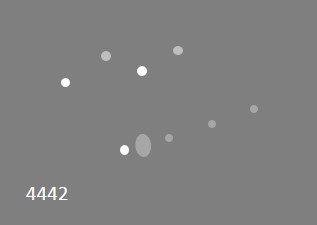 My notes indicate that this galaxy was seen as small, but fairly bright, which
goes along with its listed magnitude of 11.5. As seen in the sketch, if I observed
the correct galaxy, it was situated among numerous faint stars in the field of view. My notes indicate that this galaxy was seen as small, but fairly bright, which
goes along with its listed magnitude of 11.5. As seen in the sketch, if I observed
the correct galaxy, it was situated among numerous faint stars in the field of view. |
| 242 | 4448 | Mar 12, 2019 | 13.1" dob | 213 OLC | Coma Berenices | 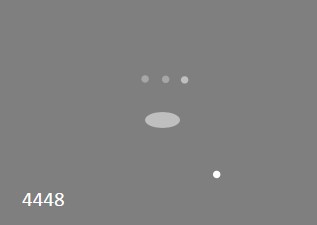 I saw this galaxy as obvious, but
nevertheless dimmer than NGC 4414 (the previous target for this evening), with a
good size, and therefore low surface brightness, a clear orientation to it that
paralleled a nice little string of three stars, with a much brighter star on the
other side of the galaxy, off toward one end; this image from texas tech shows
the line of three stars on one side of NGC 4448, although I didn't draw them with
the bend in the line as they really are. I saw this galaxy as obvious, but
nevertheless dimmer than NGC 4414 (the previous target for this evening), with a
good size, and therefore low surface brightness, a clear orientation to it that
paralleled a nice little string of three stars, with a much brighter star on the
other side of the galaxy, off toward one end; this image from texas tech shows
the line of three stars on one side of NGC 4448, although I didn't draw them with
the bend in the line as they really are. |
| 243 | 4449 | Jul 14, 2018 | 13.1" dob | Blue Ridge Parkway | Canes Ventatici | I have definitely observed this galaxy on previous occasions; on this night, I saw it as large, a very pronounced elongation, with structure and mottling along its length. This image from greg's astronomy shows that my sketch of 4449, if you turn them around to have the same orientation, is of the correct object. |
| 244 | 4450 | Feb 3, 2019 | 13.1" dob | 213 OLC | Coma Berenices | This early morning was clear but very humid, which resulted in low transparency, and of course there is some light pollution here, so even with the 13" dob, at 76x, my views were not that great; this galaxy showed a more defined core than many of the other galaxies that I observed, with a clear lessening of brightness toward the edges of the galaxy; it was situated near a fairly bright field star, which accentuated its non-stellar nature. |
| 245 | 4459 | Feb 3, 2019 | 13.1" dob | 213 OLC | Coma Berenices | 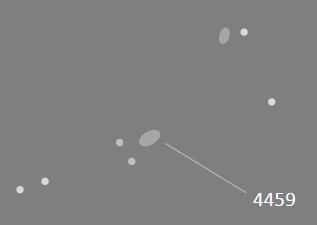 This object was in a rather
complicated field, as shown in the sketch; under the poorly transparent skies with
some light pollution in my driveway, I felt like by the time I got to this part of
the constellation, it became difficult to navigate and correctly identify each object
because the field is so crowded ~ there are too many galaxies in the field of view,
and in particular near NGC 4459, the northern end of Markarian's chain was just to
the south. My sketch shows the view I had at 76x with a 20mm erfle. This object was in a rather
complicated field, as shown in the sketch; under the poorly transparent skies with
some light pollution in my driveway, I felt like by the time I got to this part of
the constellation, it became difficult to navigate and correctly identify each object
because the field is so crowded ~ there are too many galaxies in the field of view,
and in particular near NGC 4459, the northern end of Markarian's chain was just to
the south. My sketch shows the view I had at 76x with a 20mm erfle.My sketch does not quite agree with this image of NGC 4459 from jwinman, in that the field stars near the galaxy are not oriented the same, but the fainter galaxy is similarly placed with respect it its two field stars and NGC 4459, so although I am not 100% sure I had the right object, I am more than 50% confident I did. |
| 246 | 4473 | Mar 12, 2019 | 13.1" dob | 213 OLC | Coma Berenices | On a clear, transparent morning with some light pollution at my site, using a 20mm erfle giving 76x, I saw this galaxy as easy, with a good surface brightness, a very noticeable core, having a definite orientation, and making a nice pair to scan back and forth to with NGC 4477, the next object below. This galaxy and NGC 4477 below are the last two objects in Markarian's Chain, so I have observed them many times before. |
| 247 | 4477 | Mar 12, 2019 | 13.1" dob | 213 OLC | Coma Berenices | I saw this galaxy as also being easy to locate and pick out, bright, good surface brightness, a noticeable core, and with an orientation that was about 90 degrees different from NGC 4473. |
| 248 | 4478 | June 14, 2018 | 13.1" dob | Blue Ridge Parkway | Virgo | I have certainly observed this galaxy in past years, since it is a companion to M87. My notes indicate that it was seen as small but bright, and much easier than NGC 4476, the other companion to M87. |
| 249 | 4485 | Jul 14, 2018 | 13.1" dob | Blue Ridge Parkway | Canes Ventatici | For a wide out image showing this galaxy along with its companion NGC 4490, see the below entry; NGC 4485 was very small and difficult to see, in fact I could not really see it without using averted vision. This part of the sky was in low in the northwest, where there was some light pollution, so maybe under better conditions, I would be able to see it directly. |
| 250 | 4490 | Jul 14, 2018 | 13.1" dob | Blue Ridge Parkway | Canes Ventatici | I know that I have observed this galaxy in the past, although I don't have a recollection of what I saw, nor do I know exactly when or where I observed it. This image from starry wonders shows the star Beta CVn (Chara) and the two galaxies NGC 4485 and NGC 4490. On this evening, I noted that it was easy, and sketched it as being rather elongated, with an even illumination across the surface, which suggests that I did not make note of much of a core. |
| 251 | 4494 | Mar 12, 2019 | 13.1" dob | 213 OLC | Coma Berenices | At 76x, on a clear, transparent morning, but with light pollution, I noted this galaxy as being small, with a bright core, and fairly circular in appearance, i.e., no discernible orientation. |
| 252 | 4526 | June 14, 2018 | 13.1" dob | Blue Ridge Parkway | Virgo | 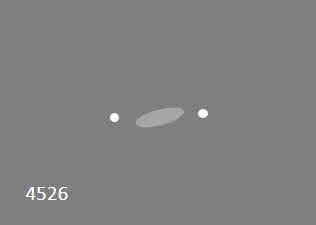 I drew this galaxy as being flanked by two field stars and presenting a very
obvious edge-on appearance; it was easy to see since it is listed in the Herschel 400 list
as being magnitude 11.0 ~ I suspect it is brighter than that, however, since the software
I use, TheSky, identifies it as magnitude 9.6. TheSky also calls it the "Lost Galaxy"
but I don't think that is correct, I believe that is supposed to refer to NGC 4535, which
is further down the list. I have definitely observed this galaxy before, under even
better conditions than this evening, but it was still a very nice sight on this occasion.
This image by Joseph
Brimacombe on flickr shows the galaxy between the two stars, and interestingly he also
refers to it as the Lost Galaxy. I drew this galaxy as being flanked by two field stars and presenting a very
obvious edge-on appearance; it was easy to see since it is listed in the Herschel 400 list
as being magnitude 11.0 ~ I suspect it is brighter than that, however, since the software
I use, TheSky, identifies it as magnitude 9.6. TheSky also calls it the "Lost Galaxy"
but I don't think that is correct, I believe that is supposed to refer to NGC 4535, which
is further down the list. I have definitely observed this galaxy before, under even
better conditions than this evening, but it was still a very nice sight on this occasion.
This image by Joseph
Brimacombe on flickr shows the galaxy between the two stars, and interestingly he also
refers to it as the Lost Galaxy. |
| 253 | 4527 | June 14, 2018 | 13.1" dob | Blue Ridge Parkway | Virgo | I doubt I have observed this galaxy before, but on this evening, I noted it as an edge-on spiral, faint but large; I did not make a sketch of it at the eyepiece. It must have had a low surface brightness if I thought it was faint, since it is listed in the H400 list as magnitude 11.5, and 10.4 in TheSky software. This image on billionsandbillions.com shows this galaxy to the lower left and one of the other galaxies below, NGC 4536, to the upper right. This pair would make a great target under similar conditions as tonight but when higher in the sky, so maybe in April one year. |
| 254 | 4535 | June 14, 2018 | 13.1" dob | Blue Ridge Parkway | Virgo | I have observed this galaxy, which I think is the true "Lost Galaxy", before, and it's located close to NGC 4526 as shown in the first image in this comment thread on CloudyNights, where 4526 is the edge-on spiral on the right side of the image. On this evening, which was an outstanding night, but unfortunately with the galaxies low in the west, I saw it as faint but large, and quite round; years ago in April I saw this galaxy better because it was much higher in the sky. |
| 255 | 4536 | June 14, 2018 | 13.1" dob | Blue Ridge Parkway | Virgo | I noted this galaxy as being fainter than the one above (NGC 4535), larger, and with a lower surface brightness. According to the H400 list, this galaxy is somewhat brighter than its companion (NGC 4527), being magnitude 11.0, and on TheSky it is shown as magnitude 10.4. |
| 256 | 4546 | June 14, 2018 | 13.1" dob | Blue Ridge Parkway | Virgo | I noted this galaxy as being easy to see, not large, with a very noticeable central condensation in the core, and near a star. This image on the bristolweather.org.uk website shows it fairly close to a bright field star like I noted it. |
| 257 | 4548 | Mar 12, 2019 | 13.1" dob | 213 OLC | Coma Berenices | This object is better known as M91, one of the few Messier objects to be included on the H400 list; seeing it is a reminder of why the Messier objects were discovered first by and large, because this galaxy is way more noticeable than most of the other objects on the list; it was seen as large, diffuse, low surface brightness, and not much of a core comapared to other galaxies ~ but the size sets it apart. I sketched it as almost circular with a swirly pattern to reflect the unevenness in the brightness across its face that I noticed, which matches the images of the galaxy, although I can't say that I saw the spiral arms, or at least I did not make note of them. |
| 258 | 4550 | June 14, 2018 | 13.1" dob | Blue Ridge Parkway | Virgo | 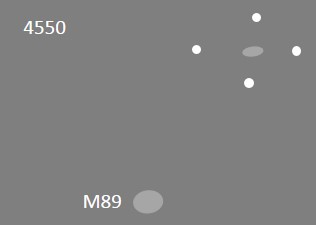 I noted this galaxy as being small but bright, which must mean it had a high
surface brightness, since the H400 list indicates it is only magnitude 12.5 (although
TheSky shows it as being magnitude 11.6). It is located in the part of the Messier
galaxy coat-hanger in between M58 and M87 and M89 (the triangle in the middle of the
coat-hanger); according to the sketch, I saw it nestled in the midst of 4 stars, with
M89 in the same 76x field of view. Although I have zero doubt that I was looking
at the correct galaxy, I did not make any note of NGC 4551, which is very close to NGC
4550, however based on this image
from Alan Dyer, one can see NGC 4550 as the small vertical edge-on galaxy near the
middle of the image with a diamond of stars around it, or maybe the one to the upper
left of it that I thought was a star was actually the galaxy NGC 4551; in the picture,
M89 is above and slightly to the left of NGC 4550. I noted this galaxy as being small but bright, which must mean it had a high
surface brightness, since the H400 list indicates it is only magnitude 12.5 (although
TheSky shows it as being magnitude 11.6). It is located in the part of the Messier
galaxy coat-hanger in between M58 and M87 and M89 (the triangle in the middle of the
coat-hanger); according to the sketch, I saw it nestled in the midst of 4 stars, with
M89 in the same 76x field of view. Although I have zero doubt that I was looking
at the correct galaxy, I did not make any note of NGC 4551, which is very close to NGC
4550, however based on this image
from Alan Dyer, one can see NGC 4550 as the small vertical edge-on galaxy near the
middle of the image with a diamond of stars around it, or maybe the one to the upper
left of it that I thought was a star was actually the galaxy NGC 4551; in the picture,
M89 is above and slightly to the left of NGC 4550. |
| 259 | 4559 | Mar 12, 2019 | 13.1" dob | 213 OLC | Coma Berenices | This galaxy was noted as obvious, large, with a definite orientation (elongated in a certain direction), a low surface brightness, very close to three field stars, but quite dim overall; the fact that it was obvious was mostly due to its size. This excellent image on flickr by Kayron Mercieca shows NGC 4559 on the left; from this image it can be seen that the galaxy does not have a high surface brightness. |
| 260 | 4565 | Mar 12, 2019 | 13.1" dob | 213 OLC | Coma Berenices | I have definitely observed this galaxy on many
occasions, most notably with the 22" dob at the Star Hill Inn in New Mexico in 2000 or 2003, I
am not sure which of the two years I observed it; I know that in 2003 I was there in August, so
it's more likely that I observed it in 2000 because I was there in May, which is spring galaxy
season. This chart shows how NGC 4565 compares with two
of the other large galaxies on this list. Finally, on March 12, 2019, I observed this galaxy as part of this program, and under clear, transparent skies, albeit not the darkest, I was able to easily see its needle-like shape, the central bulge being easily visible and maybe even some mottling. |
| 261 | 4570 | June 14, 2018 | 13.1" dob | Blue Ridge Parkway | Virgo | I did not sketch this galaxy, but noted it as small, bright, elongated like an edge-on spiral; it is listed as magnitude 12.0 in the H400 list. |
| 262 | 4594 | June 14, 2018 | 13.1" dob | Blue Ridge Parkway | Virgo | It seems a little strange that they would include M104, the Sombrero galaxy, in the H400 list; I have observed it many times, even with binoculars. On this occasion, I could see the elongated shape and the dust lane without much difficulty, even at 76x. The view would be even better if it had been higher in the sky, because I observed it just above the tree line in the southwest. |
| 263 | 4596 | June 14, 2018 | 13.1" dob | Blue Ridge Parkway | Virgo | 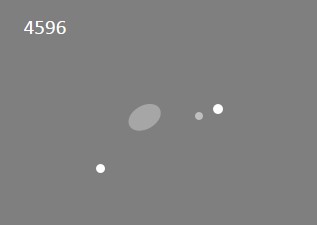 This magnitude 12.0 galaxy appeared small, not very bright, but nevertheless
distinct, which although I didn't write it down, probably means it has decent surface
brightness. This image
by Tenho Tuomi shows the two stars below and left of the galaxy that I drew, as well
as the single star above and to the left, but for some reason I did not include the star
just below the galaxy in my sketch; I also did not sketch its orientation the way that it
appears in the image. I also didn't make note of the strong core that the image
shows. This magnitude 12.0 galaxy appeared small, not very bright, but nevertheless
distinct, which although I didn't write it down, probably means it has decent surface
brightness. This image
by Tenho Tuomi shows the two stars below and left of the galaxy that I drew, as well
as the single star above and to the left, but for some reason I did not include the star
just below the galaxy in my sketch; I also did not sketch its orientation the way that it
appears in the image. I also didn't make note of the strong core that the image
shows. |
| 264 | 4618 | Jul 14, 2018 | 13.1" dob | Blue Ridge Parkway | Canes Ventatici | I noted that this galaxy was not small, but I thought it had a very low surface brightness; I could not really tell if there was much of an orientation or elongation in a particular direction. It stood out partly because it was adjacent to a field star. In this image on www.jwinman.com, the field star is to the upper left of the larger galaxy, and what immediately stands out is that I made no mention of the faint galaxy NGC 4625 very close to it. The other notable point is how irregular and interesting NGC 4618 really is, unfortunately none of its structure was visible to me in the eyepiece. |
| 265 | 4631 | Jul 14, 2018 | 13.1" dob | Blue Ridge Parkway | Canes Ventatici | I am sure that I have observed this galaxy in previous years, because it's large and the NGC number seems familiar to me. This evening, I noted it as huge, a long slivered appearance, with a very low surface brightness, and without a core or central condensation; I also could not make out any structure along the sliver. It was low in the west, where there was some sky brightening, when I observed it, so the conditions were certainly not ideal. This galaxy is close to the next one, NGC 4656, and they seem to be close in size and brightness, and I was able to pick out 4631 quickly and hold it easily. |
| 266 | 4636 | June 14, 2018 | 13.1" dob | Blue Ridge Parkway | Virgo | 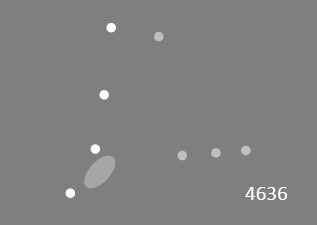 My notes for this magnitude 11.0 galaxy indicate that I saw it as large, bright,
and extended, but without a strong core; if the H400 list shows it as magnitude 11.0, then
it must be quite bright by comparison to most of the other galaxies I've been observing. My notes for this magnitude 11.0 galaxy indicate that I saw it as large, bright,
and extended, but without a strong core; if the H400 list shows it as magnitude 11.0, then
it must be quite bright by comparison to most of the other galaxies I've been observing. |
| 267 | 4643 | June 14, 2018 | 13.1" dob | Blue Ridge Parkway | Virgo | My notes indicate that I saw this galaxy as smaller than NGC 4636, but more concentrated, meaning it looked as though it had a higher surface brightness; I sketched it being near a faint star, and the pair were to be seen in the same field with a brighter star. According to deep images such as this from a thread on cloudy nights, this is a polar ring galaxy, but I did not detect anything of this structure in my brief look. I did sketch it as being elongated, so at least I noted that aspect of it. |
| 268 | 4654 | June 14, 2018 | 13.1" dob | Blue Ridge Parkway | Virgo | This galaxy is somewhat brighter than NGC 4643 above, magnitude 11.5 versus 12.0 from the H400 list, however I noted it as large and faint, so it must have a lower surface brightness. I noted that it was not quite as easy as NGC 4639 to the west of it (that one is not on the H400 list); as usual, Jim Thommes has a great annotated image showing the two galaxies, although based on his image, it's not obvious why I would have thought that NGC 4639 was easier than 4654. |
| 270 | 4660 | June 14, 2018 | 13.1" dob | Blue Ridge Parkway | Virgo | I did not sketch this galaxy, but I noted that it appeared more stellar than any other galaxy that I had observed up to this time of the night; there was very little hazy or nebulous material observable in the halo or arms, whatever kind of galaxy this is; this image from Texas Tech Univ. shows it to be rather featureless and small. Since I only observed it at 76x, it's hard for me to say if I saw only the core, or if I saw the halo shown in the image but it was so small that it just appeared like a fuzzy star. |
| 271 | 4665 | June 14, 2018 | 13.1" dob | Blue Ridge Parkway | Virgo | 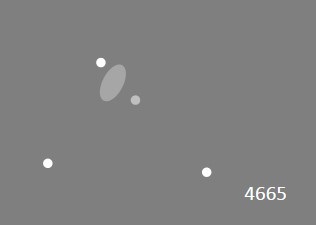 I noted this galaxy, which is listed
as magnitude 11.5 in the H400 list, as having
a condensed core, some haze around the core, and rather elongated; it was situated between
two stars and there were two other brighter field stars nearby that I could use to verify my
identification. this image from Texas
Tech again shows the two brighter stars flanking the galaxy in the same orientation that I
drew it (assuming that I saw the bar shape as the orientation of the elongation), and the two
field stars above and to the left, upside down from my sketch. I noted this galaxy, which is listed
as magnitude 11.5 in the H400 list, as having
a condensed core, some haze around the core, and rather elongated; it was situated between
two stars and there were two other brighter field stars nearby that I could use to verify my
identification. this image from Texas
Tech again shows the two brighter stars flanking the galaxy in the same orientation that I
drew it (assuming that I saw the bar shape as the orientation of the elongation), and the two
field stars above and to the left, upside down from my sketch. |
| 272 | 4666 | June 14, 2018 | 13.1" dob | Blue Ridge Parkway | Virgo | My notes on this galaxy state that I saw it as very edge-on, rather large, but not too bright; it is listed as magnitude 11.5 on the H400 list, but in TheSky software, it is shown at magnitude 10.8. The observing notes included in the software say that it is "very elongated" and has a "bright core," and is "very large, moderately extended" according to J.L.E. Dreyer. A very nice shot from the ESO shows the field from Porrima up to NGC 4666 and gives a good view of how elongated it is. |
| 273 | 4689 | Mar 12, 2019 | 13.1" dob | 213 OLC | Coma Berenices | At 76x, I noted this galaxy as having a very low surface brightness, and barely detectable, even with very clear, transparent skies; I am sure that with normal conditions here at my house, where there is often a good bit of water vapor in the air, I would not have seen it; the shape was either circular or a slight oval, I could not see any evidence of a core, so it gave the appearance of a face-on spiral; the main reason I thought I could see it without too much difficulty is that it appeared larger than most of the galaxies on this list. Rick J on Cloudynights posted this image of NGC 4689 that reveals why it presented the appearance it did to me. |
| 274 | 4697 | June 14, 2018 | 13.1" dob | Blue Ridge Parkway | Virgo | I did not sketch this galaxy nor make notes beyond saying that it was bright, an obvious sight in the eyepiece when I moved to the field, and that it had a very clear orientation; it is listed as magnitude 10.5 in the H400 list and 9.3 in TheSky software. This image from shickworld shows that it is bright, condensed, and clearly displays an elongation in one direction. |
| 275 | 4698 | June 14, 2018 | 13.1" dob | Blue Ridge Parkway | Virgo | 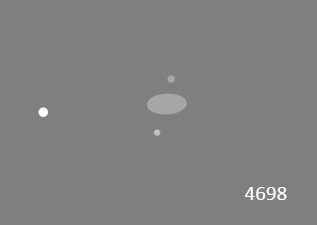 This galaxy was seen as small,
bright, rather condensed, with some nebulosity around the core, and located between
two field stars as can be seen in the sketch; from this Texas Tech image, it is
clear that I drew the flanking stars and the brighter field star correctly, but I
got the orientation of the galaxy completely wrong, it's about 90 degrees off from
the orientation that I sketched. This galaxy was seen as small,
bright, rather condensed, with some nebulosity around the core, and located between
two field stars as can be seen in the sketch; from this Texas Tech image, it is
clear that I drew the flanking stars and the brighter field star correctly, but I
got the orientation of the galaxy completely wrong, it's about 90 degrees off from
the orientation that I sketched. |
| 276 | 4699 | June 14, 2018 | 13.1" dob | Blue Ridge Parkway | Virgo | I noted this galaxy as being small, bright, presenting a hazy or gauzy appearance, overall very easy to see even though by this time, I was looking even more down toward the southwestern horizon, especially considering the -8 degree declination of this object. According to notes from TheSky software, it is an "elongated galaxy with bright core" but the comments they cite from J.L.E. Dreyer indicate that he saw it as "very bright, round". I did not write down anything about the galaxy being elongated. Here is a good image from the website "lumpydarkness" showing an approximation of what it looks like in the eyepiece. |
| 277 | 4725 | Mar 12, 2019 | 13.1" dob | 213 OLC | Coma Berenices | Compare how this galaxy stacks up against the
other large Coma Berenices galaxies to get an idea of what
kind of galaxy group is concentrated here in this small area of the sky. I finally observed this object on March 12, 2019, and at 76x under clear, transparent skies noted that it was obvious, large, and possessed a clear orientation; it had a strong, obvious core, but otherwise seemed to have a relatively low surface brightness; this galaxy would probably be great in a dark sky. |
| 278 | 4753 | June 14, 2018 | 13.1" dob | Blue Ridge Parkway | Virgo | I noted this galaxy as being roundish, not having a high surface brightness, and without much of a core, but fairly good-sized compared to many others that I've observed this evening. I could not find a great wide-field image of this galaxy, but this image from the Carnegie-Irvine Galaxy Survey shows that the core is tiny, which would bolster my impression that it did not have a significant central condensation. |
| 279 | 4754 | June 14, 2018 | 13.1" dob | Blue Ridge Parkway | Virgo | I only noted this galaxy as being roundish and small. It's curious that I made no notes regarding the fact that it is located in the same field of view as NGC 4762, the next object in the list below. Martin Germano's image shows the contrast in appearance of these two galaxies and also gives a pretty good feel for what can be seen in the eyepiece in terms of detail and the shape/orientation of the objects. |
| 280 | 4762 | June 14, 2018 | 13.1" dob | Blue Ridge Parkway | Virgo | My only notes on this galaxy were that I saw it as an edge-on sliver, oriented roughly north-south. I think I misjudged the orientation because I was viewing it low in the west with an alt-az mount so I probably actually saw it "up-down" in the eyepiece. This capture from TheSky software shows the two galaxies (4754 to the right, 4762 to the left) with their correct orientation and north being straight up. An interesting fact from wikipedia on these two galaxies is that NGC 4754 is listed as being 53 million light years away, while the distance to NGC 4762 is given as 60 million light years, which means they are about 3 times farther away from each other as we are from the Andromeda Galaxy. |
| 281 | 4781 | June 14, 2018 | 13.1" dob | Blue Ridge Parkway | Virgo | My notes for this galaxy show that I saw it as faint, rather large, and no discernible core; it was low on the horizon, however, so it must have suffered quite a bit from atmospheric extinction. If it was large in size, then it probably would make a good target to revisit under better conditions. |
| 282 | 4800 | Jul 14, 2018 | 13.1" dob | Blue Ridge Parkway | Canes Ventatici | Here is another example of how a fainter galaxy can be easier to see; I noted that this galaxy listed as magnitude 13.0 in the H400 was "easy" and had a good, concentrated core. Although I did not comment specifically about it, the object must have had good surface brightness. |
| 283 | 4845 | June 14, 2018 | 13.1" dob | Blue Ridge Parkway | Virgo | 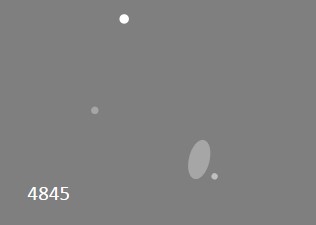 This is, like many of these
objects, my first observation of this galaxy that I can recall, and I found it to
be faint, not small, so probably medium-sized, with no discernible core and a low
surface brightness. This image from
az-dahut shows that I sketched the brightest stars in relation to the galaxy
correctly; I definitely drew the galaxy as elongated in the manner of an edge-on
spiral, but I made no mention of the aspect ratio in my notes. This is, like many of these
objects, my first observation of this galaxy that I can recall, and I found it to
be faint, not small, so probably medium-sized, with no discernible core and a low
surface brightness. This image from
az-dahut shows that I sketched the brightest stars in relation to the galaxy
correctly; I definitely drew the galaxy as elongated in the manner of an edge-on
spiral, but I made no mention of the aspect ratio in my notes. |
| 284 | 4856 | Mar 12, 2019 | 13.1" dob | 213 OLC | Virgo | At 76x, on a clear and steady night, I noted this galaxy as being small, with a good core and a faint halo around it; I could not detect any structure ~ this image from texas tech univ shows that this galaxy would not display much structure in a backyard scope especially from my light-polluted home. |
| 285 | 4866 | June 14, 2018 | 13.1" dob | Blue Ridge Parkway | Virgo | I did not make a sketch of this galaxy but my notes indicate that I saw it as faint, not small, and elongated in an east-west direction as best I could tell, considering the fact that my scope is alt-az and the object was near the western horizon. Interesting that in TheSky software, they quote Dreyer as describing the galaxy as "bright, pretty large", so that gives me a 50% correlation to his description LOL. The location of this galaxy is kind of interesting too ~ it is one of the first ones in this list that is clearly outside of the main swarm of galaxies near the center of the Virgo cluster, in a rather sparse area of the sky. |
| 286 | 4900 | June 14, 2018 | 13.1" dob | Blue Ridge Parkway | Virgo | 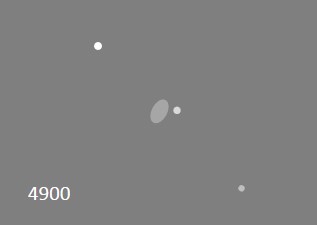 I described this galaxy as
faint, small, and with not much of a core; I thought that it stood out very clearly
in the telescope because it was an obvious fuzzy spot right next to a field star,
so the contrast between the two made it more apparent; one thing is clear if you
look at this image from ttu.edu,
and that is that I drew the galaxy as somewhat elongated, but according to the image
it is almost perfectly round. The star pattern I drew matches the image, so at
least I have extra confidence that I observed the correct object. I described this galaxy as
faint, small, and with not much of a core; I thought that it stood out very clearly
in the telescope because it was an obvious fuzzy spot right next to a field star,
so the contrast between the two made it more apparent; one thing is clear if you
look at this image from ttu.edu,
and that is that I drew the galaxy as somewhat elongated, but according to the image
it is almost perfectly round. The star pattern I drew matches the image, so at
least I have extra confidence that I observed the correct object. |
| 287 | 4958 | June 14, 2018 | 13.1" dob | Blue Ridge Parkway | Virgo | I noted that this galaxy was a north- south sliver, presenting a very edge-on appearance, not bright, but nevertheless an interesting, engaging sight ~ something to come back to at a later date when it's higher in the sky. This image from a thread on cloudynights shows the galaxy well, in particular its pronounced elongation. |
| 288 | 4995 | June 14, 2018 | 13.1" dob | Blue Ridge Parkway | Virgo | I found this galaxy to be faint, no central condensation that I could detect, and quite difficult, almost assuredly also due to it being at a southerly declination and low in the west. |
| 289 | 5005 | Jul 14, 2018 | 13.1" dob | Blue Ridge Parkway | Canes Ventatici | My notes indicate I saw this galaxy as not small, with a good core, but also with an extended nebulous area around the core. My sketch of the galaxy and the surrounding field stars is fairly in line with this image from www.astronomersdoitinthedark.com, if you rotate one of them to just about upside down. |
| 290 | 5033 | Jul 14, 2018 | 13.1" dob | Blue Ridge Parkway | Canes Ventatici | I noted this galaxy as being easy, and fairly bright, with an obvious elongation, which can be seen relative to the field stars in my sketch. |
| 291 | 5054 | Mar 12, 2019 | 13.1" dob | 213 OLC | Virgo | At 76x on a clear and transparent night, but with some light pollution, and not great dark adapation owing to headlights, I saw this galaxy as large, faint, no core, overall a very interesting and unusual view when compared to many galaxies on the H400 list ~ it presented an evenly illuminated hazy aspect across its entire face. The diffuse appearance of this galaxy comes across in this sketch on the ASOD website. |
| 292 | 5195 | June 15, 2018 | 13.1" dob | Blue Ridge Parkway | Canes Ventatici | I have definitely observed the companion to M51, the Whirlpool galaxy on many occasions, most recently on the listed date while focusing on Leo, Virgo, and Ursa Major for most of the night; under excellent skies, but with the galaxies sliding down to the west in an area of slight light pollution, I saw great structure in M51, an obvious spiral shape, and the mottled glow of NGC 5195 connected to it by a continuous bridge of nebulosity that was moderately bright. The mottling of the main part of the galaxy was either an illusion of mine or I was seeing a real manifestation of the disturbed nature of the galaxy. I need to revisit this object again under dark skies and this time view it when it is higher in the sky. What was surprising about this observation of 5195 is that I thought its core was brighter than M51, and that it had a decidedly off-center look to it. |
| 293 | 5248 | Aug 13, 2018 | 13.1" dob | Blue Ridge Parkway | Bootes | I finally nabbed this galaxy, even though it was low in the west, although the sky was very clear. I noted a small, but medium bright galaxy with a clear central bulge and a tapering disk on either side, viewed seemingly edge-on, that became points at the ends. |
| 294 | 5273 | Jul 14, 2018 | 13.1" dob | Blue Ridge Parkway | Canes Ventatici | I noted this galaxy, which I have never observed before, as being very faint, not small, a noticeable core, but not able to be held without averted vision. |
| 295 | 5322 | June 15, 2018 | 13.1" dob | Blue Ridge Parkway | Ursa Major | My notes about this galaxy indicate that I saw it as not large, with a high surface brightness, a pronounced core, and not a very large halo of nebulous material around the core. This image by Martin Germano conveys pretty much what I saw, namely a clearly nebulous object with a strong central region, but otherwise totally featureless. |
| 296 | 5363 | Mar 12, 2019 | 13.1" dob | 213 OLC | Virgo | This early morning was clear, dry, and very transparent, with a mild breeze, so in other words the sky conditions were excellent, even though at my location there is some light pollution and headlights periodically shining in from the highway. At 76x, I saw this galaxy as bright, small, with a nearly stellar core, adjacent to a field star; it appeared to be oriented somewhat east-west. In the same field of view, I could see the next object, NGC 5364, compared to which this object is much more prominent. |
| 297 | 5364 | Mar 12, 2019 | 13.1" dob | 213 OLC | Virgo | This galaxy was much fainter but the same size as NGC 5363 above, which shows its much lower surface brightness; this pair would be very interesting in a darker site with good dark adaptation. Compare the two in this image from Martin Germano which shows that NGC 5363 shows a larger area of brightness while NGC 5364 has a large area of its spiral arms that are much dimmer. |
| 298 | 5466 | June 14, 2018 | 13.1" dob | Blue Ridge Parkway | Bootes | Not my first observation of this globular cluster, but still very difficult! It was low in the west where, despite being in the mountains, there was still slight pollution; it was a very low surface brightness, even glow that had a granular appearance with not much of a discernible concentration toward the center. |
| 299 | 5473 | June 15, 2018 | 13.1" dob | Blue Ridge Parkway | Ursa Major | Now we're getting to some interesting fields since this galaxy and the next are in the immediate vicinity of M101, although my suspicion is that they are far in the background compared to M101. This galaxy is listed in the H400 table as being magnitude 13.0, but 11.4 in TheSky software, which is a pretty big delta if you ask me ~ which is it? My notes say that it is rather small, fairly condensed, located adjacent to a star, and with a low to moderate amount of nebulous material around the core. I think this image from phys.ttu.edu does justice to what I observed. Various sources on the internet listed the distance to NGC 5473 and NGC 5474 as being around 80 million light years, while the distance to M101 is given as 21 million l.y., confirming my suspicion that these two "companions" are not related to M101 except by chance alignment. |
| 300 | 5474 | June 15, 2018 | 13.1" dob | Blue Ridge Parkway | Ursa Major | This galaxy is just on the other side of M101 from NGC 5473, although I found it to be larger, not much of a core, and more even illumination ~ this page of observing notes gives someone else's description of how these two "satellite" galaxies of M101 compare and the challenges in locating them; I did not find either one to be difficult to find, probably owing to the aperture I used and the dark skies under which I was observing. |
| 301 | 5557 | June 14, 2018 | 13.1" dob | Blue Ridge Parkway | Bootes | Even though Bootes was low in the west and there was a small bit of light pollution in that direction, I saw this magnitude 13 galaxy fairly easily, which means that it must have a high surface brightness; it appeared small, was snugged right up next to a field star, and exhibited a fairly concentrated core. |
| 302 | 5566 | Mar 12, 2019 | 13.1" dob | 213 OLC | Virgo | At 76x, I saw this galaxy as bright, with a good core, very high surface brightness, and adjacent to a field star. |
| 303 | 5576 | Mar 12, 2019 | 13.1" dob | 213 OLC | Virgo | At 76x, under a clear and transparent sky, this galaxy appeared dimmer than NGC 5566 but brighter than NGC 5574, which is very close by to NGC 5576. The two of them would make a great pair under nice dark skies. It has a decent core but not as concentrated as 5566. This image from texas tech shows a good comparison between NGC 5576 and its close companion. |
| 304 | 5631 | June 15, 2018 | 13.1" dob | Blue Ridge Parkway | Ursa Major | I noted this galaxy as having a strong core, a relatively high surface brightness, with a not very sizeable hazy area surrounding the center. |
| 305 | 5634 | Mar 12, 2019 | 13.1" dob | 213 OLC | Virgo | This was a bit of a surprise since I didn't expect to have anything except galaxies in Virgo, but this globular cluster presented a nice appearance, surprisingly interesting; it was small, circular, i.e., no asymmetry that I could tell, close to a field star, not resolved, but definitely brighter toward the center and quickly fading toward the edge. I would say it was comparable to many of the globular clusters in Ophiuchus that I observed in the summer of 2018 as part of this list. |
| 306 | 5676 | June 14, 2018 | 13.1" dob | Blue Ridge Parkway | Bootes | This magnitude 12 galaxy was not quite as easy to see as 5557 above, but was somewhat larger; I did not notice much of a core, rather it presented a more even illumination across its face. |
| 307 | 5689 | June 14, 2018 | 13.1" dob | Blue Ridge Parkway | Bootes | I saw this galaxy as fairly small, a rather noticeable core, and somewhat elongated; it was not very bright. |
| 308 | 5694 | Mar 12, 2019 | 13.1" dob | 213 OLC | Hydra | On a very clear, transparent night, but with some light pollution, at 76x, this globular cluster was seen as very small, the smallest one I have ever seen I think, showing up as just barely non-stellar, not resolved of course, and adjacent to two faint field stars. This globular is easy to locate since it's situated in the crook of a small grouping of stars, all of which are at the focus of a chevron-shaped group of stars. |
| 309 | 5746 | Mar 12, 2019 | 13.1" dob | 213 OLC | Virgo | This galaxy looked like a spiral to me at 76x under very good skies but not super dark; it appeared elongated north-south, almost spindle-like, so perhaps it could be a lenticular as opposed to a spiral, but in any event it was quite long, so this object would be a great one to revisit in a dark sky if it could be seen well under these conditions. |
| 310 | 5846 | Mar 12, 2019 | 13.1" dob | 213 OLC | Virgo | 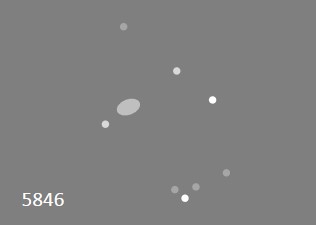 This galaxy was seen as somewhat oval
but not too far from round, appearing obvious in the eyepiece but not much of a core,
and with average surface brightness; what is interesting, when you look at this sketch of
the galaxy on cloudy nights, is that even though my drawing clearly shows that
I had the correct object, I made no note of the other galaxies in the vicinity,
especially that of NGC 5850, which is in the upper right of the cloudy nights
sketch. This is certainly a group that I want to revisit under dark skies. This galaxy was seen as somewhat oval
but not too far from round, appearing obvious in the eyepiece but not much of a core,
and with average surface brightness; what is interesting, when you look at this sketch of
the galaxy on cloudy nights, is that even though my drawing clearly shows that
I had the correct object, I made no note of the other galaxies in the vicinity,
especially that of NGC 5850, which is in the upper right of the cloudy nights
sketch. This is certainly a group that I want to revisit under dark skies. |
| 311 | 5866 | Mar 23, 2019 | 13.1" dob | 213 OLC | Draco | This galaxy should be a treat to observe if I
can manage to see it under dark skies; it's called the spindle galaxy (type: lenticular) and
shows a razor-thin dust lane
along its length. Don't know whether I'm goign to be able to see that or not; according
to Wikipedia, this galaxy was discovered initially by either Messier or Mechain, and is thought
according to some theories to be the missing M102. Finally, on March 23, 2019, I was able to see this galaxy fairly easily even though I was looking low to the northeast into some light pollution; I saw it as an elongated object, with a clearly brighter core and a dimmer haze around the core. The pattern of stars around the galaxy clearly matched the pattern shown on the charting software, so I know I had the right object; it clearly must be a very bright object to be seen so well that low in a bright sky. |
| 312 | 5897 | Feb 3, 2019 | 13.1" dob | 213 OLC | Libra | I have observed this globular cluster on several
occasions in the past, the most memorable of which was a period of time in the late winter of 2005
or 2006, when I woke up in the morning hours to scan the southern sky in the area where Libra,
Hydra, and Centaurus converge to practice identifying the "leading edge" globular clusters in the
area; all of them are small and relatively faint, and since I was only using 20x50 or 20x80
binoculars, I could not see much except to identify the fuzzy ball that clearly was not stellar.
This particular cluster was a challenge to find because I had to star-hop from Sigma Librae
up a rather sparse chain of stars to get to a distinctive grouping of stars, among which I learned
where to look for NGC 5897. This image
from the Orion website shows the relationship of the cluster to the nearby field stars (to the
left in the image) that can be seen in binoculars. Finally, on February 3, 2019, I was able to barely detect this object with my 13" dob in poor skies at my house. I saw it as surprisingly large, very faint, extremely low surface brightness, no structure or resolution. The skies on this cold morning were not very transparent due to the humidity and light pollution here, so if I can observe this globular cluster from a darker site under better conditions, I should have a better idea of how it compares to others of its type. The view this morning was puzzling in that it appeared to be much larger than most of the globular clusters in Ophiuchus that I saw last summer, but far dimmer. How is that possible? |
| 313 | 5907 | Mar 23, 2019 | 13.1" dob | 213 OLC | Draco | I know that I have observed this galaxy in the
past while trying to follow the lead of articles suggesting that this object might be the lost
galaxy M102, although I did not make any notes nor do I recall what the object looked like in
the eyepiece. According to TheSky, it is listed as magnitude 10.4, and based on images
such as this one from starhopper.at,
it is a razor-thin edge-on spiral and ought to be interesting to observe if I can manage to get
it from a dark sky location. This galaxy was hard to detect in the bright sky, but after my eyes dark adapted somewhat, on March 23, 2019, I was able to finally detect the faint sliver that must be the thinnest edge-on galaxy I've ever observed. Part of that impression must be because the sky was so bright that I could only see the brightest inner part. This would be a great galaxy to view from a dark location. |
| 314 | 5982 | Mar 23, 2019 | 13.1" dob | 213 OLC | Draco | This elliptical galaxy should be interesting
to observe because it is the middle galaxy in a close grouping of three different types of
galaxies, all in a row. This image
from Astronomy magazine shows the angled spiral, the elliptical, and the edge-on spiral,
given the moniker "The Draco Trio" in the article. On March 23, 2019, I was able to find this galaxy but only with great difficulty ~ it was low in the northeast in a light polluted sky and the only thing I could make out is the brightest part of the core; nothing could be seen of the other two members of the Draco trio as shown in the referenced image; I really need to go to a dark sky location to get a good view of this object. |
| 315 | 6118 | Sept 5, 2018 | 13.1" dob | Blue Ridge Parkway | Serpens | I tried multiple times to see this object from the Blue Ridge Parkway on August 13, 2018, but with no luck. I know from the charts and from other postings on the net that I was looking in exactly the right spot, but I could not pull it out of the sky background. My next time up in the mountains, on September 5th, I again viewed the area fairly low in the southwest, so the location was not optimal, and worse, the sky transparency was not at its best owing to the high humidity. Nevertheless, I saw slightly more this time than I had in previous attempts, so the barest hint of a smudge was all I could make out, among other hints of a slight fog in other areas of sky near the first candidate smudge. My sketch of the object shows that, by comparison to this SkyView DSS image, I was indeed seeing the galaxy and looking in exactly the correct spot. |
| 316 | 6144 | Aug 13, 2018 | 13.1" dob | Blue Ridge Parkway | Scorpius | I tried observing this globular cluster on the night of August 4, 2018, the same date as the below object, but could not see it to save my life; I know I was looking at the exact spot based on the star pattern, but it was not to be seen. I tried again several night later with my 120 refractor from my house, but again no luck. Finally, on the listed date, I was able to see the globular cluster from the Blue Ridge Parkway. It was fairly large, very faint, with a very low surface brightness, and perhaps some slight resolution into a few stars around the edges. Mostly, just a faint unresolved glow, even in the dark skies of the mountains. I also noted that on an image I acquired in July from my driveway of the Antares region, this globular is faintly visible just to the upper right of Antares, so even though that doesn't count as an *observation*, I did record it before I saw it visually LOL. |
| 317 | 6171 | Aug 13, 2018 | 13.1" dob | Blue Ridge Parkway | Ophiuchus | I have observed M107 on a fair number of other occasions, probably under better conditions, but don't recall anything extraordinary about it ~ on this date, I saw it as not small, pretty dim, with a low surface brightness, and what I thought was partial resolution into stars at the edges. |
| 318 | 6207 | June 15, 2018 | 13.1" dob | Blue Ridge Parkway | Hercules | I have seen this little galaxy near M13 on several occasions, the most recent of which was after most of my observing session in the mountains on the listed date was completed; I looked at M13 and then found the small, very oval galaxy nearby, with what I listed as good surface brightness but not much of a difference between the core and outlying areas of the halo in terms of brightness. It was very high in the sky, almost overhead, when I observed it, so I estimate that I had one of the best views I have ever had of the object. Another observation on August 13, 2018, the same night as the observation of the next object, showed the galaxy as small at 76x, noticeably elongated, and somewhat concentrated at its core. Why I saw it differently on this night compared to June 15, I don't know ~ perhaps sky conditions were different? |
| 319 | 6217 | June 15, 2018 | 13.1" dob | Blue Ridge Parkway | Ursa Minor | I noted this galaxy as easy, fairly large, with some noticeable concentration toward the middle, average surface brightness, and a generous sized halo of haze surrounding the core. |
| 320 | 6229 | Aug 13, 2018 | 13.1" dob | Blue Ridge Parkway | Hercules | I saw this globular as quite bright, concentrated, and some resolution of stars at the edges. |
| 321 | 6235 | Aug 13, 2018 | 13.1" dob | Blue Ridge Parkway | Ophiuchus | I noted this globular cluster as being dim, small, not resolved into stars at 76x, but nicely nestled in between two stars so it made for an attractive view. |
| 322 | 6284 | Aug 13, 2018 | 13.1" dob | Blue Ridge Parkway | Ophiuchus | This globular was somewhat brighter than NGC 6235, but also small, with a more noticeable core that faded out toward the edges; it had a higher surface brightness than 6235. |
| 323 | 6287 | Aug 13, 2018 | 13.1" dob | Blue Ridge Parkway | Ophiuchus | I saw this globular as having the same size as NGC 6284, but with the core not as pronounced, and not resolved at the edges at 76x. |
| 324 | 6293 | Aug 13, 2018 | 13.1" dob | Blue Ridge Parkway | Ophiuchus | I noted this globular cluster as being slightly bigger than the previous ones, with a hint of resolution at the edges; the core was somewhat more pronounced, and after the previous three or four targets, this one had a "bright" appearance by comparison. |
| 325 | 6304 | Aug 13, 2018 | 13.1" dob | Blue Ridge Parkway | Ophiuchus | This object must be even better than my impression in the eyepiece, because I was viewing it through the edges of the treeline above my location; I noted it as bright, small, not resolved, but with a definite core; this would be one to revisit under better conditions and without any visual obstructions! |
| 326 | 6316 | Aug 13, 2018 | 13.1" dob | Blue Ridge Parkway | Ophiuchus | I noted this globular cluster as being very small, adjacent to a star, and not bright, but with a slightly noticeable core at 76x. |
| 327 | 6342 | Aug 13, 2018 | 13.1" dob | Blue Ridge Parkway | Ophiuchus | This globular cluster presented a similar appearance to the previous one, NGC 6316, because it seemed very small, also adjacent to a star, was not bright, and not a very noticeable halo; it looked like a core with almost no halo, just fuzzy. |
| 328 | 6355 | Aug 13, 2018 | 13.1" dob | Blue Ridge Parkway | Ophiuchus | This globular was challenging for me; I noted it as being small, dim, and barely detectable. The given magnitude of the object in the H400 list is 9.5, which is among the brightest of all the globular clusters in Ophiuchus, but I definitely did not see that. TheSky planetarium software lists its magnitude at 9.6, so for one thing that is a little unusual in that it agrees almost exactly with the H400 list, but then they include the JLE Dreyer description as being "Considerably faint, large, round, gradually brighter middle, well resolved." Maybe the issue with this cluster is that it is large but has a low surface brightness, so when I observed it, it appears less prominent than ones that are smaller and dimmer because it does not match the surface brightness of the others. |
| 329 | 6356 | Aug 13, 2018 | 13.1" dob | Blue Ridge Parkway | Ophiuchus | I saw this globular cluster as bigger, brighter, and partially resolved compared to the others I have seen on this night; my impression was that it was the nicest one of the night so far. One issue that I could be having in my comparison of these objects is that they are all fairly low in the sky, so when some of these, for example NGC 6355, are at -26 degrees declination, and others such as this one, are at -17 degrees, that is a huge difference in the amount of atmospheric attenuation for the two objects, something that would not be as pronounced if they were all higher in the sky. |
| 330 | 6369 | Aug 13, 2018 | 13.1" dob | Blue Ridge Parkway | Ophiuchus | The magnitude of this object in the H400 list, 14.0, is a bit intimidating, but actually this planetary nebula was easy to see, immediately apparent upon sweeping it up that this was the planetary and not a star. It looked grey, tiny at 76x, so therefore I did not see any structure either. |
| 331 | 6401 | Aug 13, 2018 | 13.1" dob | Blue Ridge Parkway | Ophiuchus | I noted this globular cluster as small, not bright, but with a high surface brightness, presenting the appearance of a fuzzy core to a globular. |
| 332 | 6426 | Aug 13, 2018 | 13.1" dob | Blue Ridge Parkway | Ophiuchus | This globular, even though it was much higher in the sky than most of the other globulars I have observed in Ophiuchus, about 20 to 30 degrees higher than most in fact, still seemed extremely dim to me, barely detectable in fact, with a very low surface brightness. It was not small, which gives a clue that its meager brightness is smeared out over a large area. It was easy to find, however, being just south of the huge open cluster IC 4665, in the vicinity of beta Ophiuchi. The JLE Dreyer description is "Very faint, considerably large, extended, very little brighter middle." That is pretty much what I saw. |
| 333 | 6440 | Aug 4, 2018 | 13.1" dob | 213 OLC | Sagittarius | This object was more concentrated than the Scorpius open cluster NGC 6451, rather small at 76x, and not resolved. |
| 334 | 6445 | Aug 4, 2018 | 13.1" dob | 213 OLC | Sagittarius | This planetary nebula was not hard, in fact I thought it was easy, because it was obviously fuzzy, not starlike at all, and bright enough to stand out; I did not detect any color. |
| 335 | 6451 | Aug 4, 2018 | 13.1" dob | 213 OLC | Scorpius | Observing on a moonless night but very muggy and with some clouds moving through; transparency not good at all and optics adversely affected by the humidity; this object was dim, but large, and not resolved. I did not have difficulty in locating it. This open cluster could be interesting to see under dark, transparent skies. |
| 336 | 6514 | Aug 4, 2018 | 13.1" dob | 213 OLC | Sagittarius | This is M20, the Trifid Nebula, which I have seen on many occasions very well, including a month ago in the mountains; on this night, however, there was very little to see; the cluster came through OK, although I am sure that the dimmer stars were suppressed, but the nebulosity was almost impossible to see, the humidity and haze being so overpowering. |
| 337 | 6517 | Aug 13, 2018 | 13.1" dob | Blue Ridge Parkway | Ophiuchus | This globular is located about 12 degrees south of NGC 6426, and is listed as being half a magnitude fainter as well, so it's not surprising that I noted it as faint, and that it looked like a fuzzy star; I thought it had a higher surface brightness than NGC 6426. I thought it was easy to identify, however, because it made a nice triangular pattern with two field stars that really accentuated the non-stellar appearance of it, as this nice image from jwinman shows. |
| 338 | 6520 | Aug 4, 2018 | 13.1" dob | 213 OLC | Sagittarius | This open cluster was easy, but was still an unresolved glow of stars in the core, along with two bright stars amidst the core, and then a ring of similarly bright stars surrounding the core, but offset from it (i.e., the unresolved core was located off-center from the actual middle of the ring of stars). |
| 339 | 6522 | Aug 4, 2018 | 13.1" dob | 213 OLC | Sagittarius | This globular cluster and the next one, NGC 6528, form a pair that was easy to see together at 76x in the same FOV; NGC 6522 was larger and brighter of the two, although neither were resolved. Although 6522 was larger, it was not by much. |
| 340 | 6528 | Aug 4, 2018 | 13.1" dob | 213 OLC | Sagittarius | According to the H400 listing I am using for this project, this globular cluster is magnitude 11.0 compared to NGC 6522 being 10.5; I would have said that 6522 is more than just half a magnitude brighter than this one based on my observation tonight. |
| 341 | 6540 | Aug 4, 2018 | 13.1" dob | 213 OLC | Sagittarius | I saw this open cluster as faint and small, almost overlooked; it was much less noticeable than NGC 6520; I don't really have anything to indicate that I saw the correct object except that it really is much smaller and less noticeable than 6520, so I think I did observe it. Faint open clusters such as this one really require transparent skies to see well, so I should come back to this if I have a nice night in the mountains when it's clearer and drier. I just noticed that the H400 list shows this open cluster as magnitude 14.5, and TheSky software indicates that it is magnitude 15, which is almost impossible to believe. If these figures are true, then I cannot possibly have seen it on this night, when I couldn't even see NGC 6144, the globular cluster near Antares. Something is up with this object that I need to run down. Another problem I just discovered is that the list shows this object as an OCl, or open cluster, whereas the Wikipedia entry for it identifies it as a magnitude 9.3 globular cluster. What is going on here? Every reference I found in which people actually discussed observing this object describes it as a small globular, and then I found this reference that briefly summarizes the history of the object, namely that it was wrongly classified as an open cluster by Per Collinder and perhaps others. So it's definitely a globublar cluster. In his book, Herschel 400 Observing Guide, Stephen James O'Meara also notes the discrepancy in many quoted magnitudes versus its actual appearance; this is an example of how research into the object actually turned out to be more interesting than its appearance in the eyepiece. |
| 342 | 6543 | Mar 31, 2019 | 150mm f/5 achromat | 213 OLC | Draco | The Cat's Eye nebula is one that I have seen
on several occasions, and although I did not keep notes during earlier observations, I recall
that it was quite bright and had a very obvious bluish color. This DSLR
Image is about the widest field view I could find to show the surrounding star field.
Finally, on March 31, 2019, around 10:30 local time, I was able to observe this planetary nebula; the sky conditions were clear and cold, but with light pollution and observing the object low in the north-northeast, where the sky is bright because of Washington, D.C., the conditions were not great despite the good skies. I saw it as obvious in the eyepiece at 38x, as bluish and non-stellar, effects which were enhanced at 63x. I was able to verify the position of the nebula with respect to the adjacent stars with my planetarium software, so I know I had NGC 6543 in view. Even at 63x, it was small, bright, bluish, and displaying a fairly even brightness across its disk, i.e., at the magnification I was using, I could not detect any dimming of the disk in either the center or the edges. |
| 343 | 6544 | Aug 4, 2018 | 13.1" dob | 213 OLC | Sagittarius | I found this object to be small, but easy, and that it stood out well from the field, however I could not resolve it on this night at 76x; I need to try this one again under darker skies, because I am sure that I've obsevered it in the past on better occasions. This globular was easy to locate, southeast of M8 fairly close to a relatively bright field star. See the below entry for a wide field image. |
| 344 | 6553 | Aug 4, 2018 | 13.1" dob | 213 OLC | Sagittarius | Going a little further south and to the east, I saw NGC 6553 as a bit larger but dimmer, which probably means a lower surface brightness than 6544; it also was not resolved on this evening. I know that I was looking for these objects in the right place, but this DSS image from SkyView shows that my observations were almost opposite to how the two appear on images. Who knows, maybe my optics had fogged some, or there was an uneven layer of clouds, it's difficult to tell. |
| 345 | 6568 | Aug 4, 2018 | 13.1" dob | 213 OLC | Sagittarius | This open cluster was easier than many of the others on the night ~ I saw it as sprawling compared to most other objects that I've viewed this evening, many if not all stars resolved, perhaps a slight unresolved haze in the middle of the group of resolved stars, but given the conditions tonight, I cannot be sure that it wasn't fog on the optics. See the entry for NGC 6583 below for a wide angle image. |
| 346 | 6569 | Aug 4, 2018 | 13.1" dob | 213 OLC | Sagittarius | I saw this globular cluster as a very evenly bright hazy spot, i.e., very little brightening toward the center; it was not resolved, but obvious in the eyepiece, just a gray fuzzy disk. |
| 347 | 6583 | Aug 4, 2018 | 13.1" dob | 213 OLC | Sagittarius | This open cluster was very difficult to see on this evening ~ at first I mistook something else, probably just a bright knot of stars in the milky way background, for it, but then I am pretty sure that I saw it, because I found a faint, unresolved, and small object in the field where it is supposed to be, even though I had switched now to 123x. My impressions of this object and NGC 6568, above, are basically confirmed by this image from DSS showing how they compare to each other. |
| 348 | 6624 | Aug 4, 2018 | 13.1" dob | 213 OLC | Sagittarius | This globular cluster actually looked just like they're supposed to look, with a good core and a gradually diminishing halo outside of the core; I thought it was almost resolved in its outer regions, viewing at 123x. |
| 349 | 6629 | Aug 4, 2018 | 13.1" dob | 213 OLC | Sagittarius | This turned into one of the most interesting sights of the night, not because of its visual appearance, but owing to the challenge in finding it and seeing what it looked like once located. It showed as very small, almost stellar even at 123x, but it was bright and easy to see. I had to consult TheSky planetarium software to identify the pentagon of stars with the top one being a wide double to see where the planetary nebula was (I made the observation with 123x). |
| 350 | 6633 | Aug 13, 2018 | 13.1" dob | Blue Ridge Parkway | Ophiuchus | I have observed this cluster many time as part of the delightful comparison with the larger nearby cluster in Serpens, IC 4756; although I had not kept notes on it in the past, I recall from observing with smaller refractors and my 20x80 binoculars that this object has a fairly pronounced elongation to the shape of the visible stars, oriented roughly in an east-west direction. On this date, I noted that it was huge, comprising several clumps of stars; the southwest tip is the most concentrated, while the northeast is the loosest but with brighter stars; the whole cluster has a curved oblong shape to it, very distinctive. This image by Jim Thommes shows a wide-angle view of this cluster along with IC 4756 in Serpens. |
| 351 | 6638 | Sept 5, 2018 | 13.1" dob | Blue Ridge Parkway | Sagittarius | This globular cluster looked like a fuzzy star at 76x, it was not resolved, and appeared much smaller than NGC 6712 in Scutum that I had just observed before this one. |
| 352 | 6642 | Sept 5, 2018 | 13.1" dob | Blue Ridge Parkway | Sagittarius | I saw this object as being very similar to NGC 6638, in other words very small, unresolved, more like a fuzzy star; both of them were easy to see however, so they were not dim, just small. |
| 353 | 6645 | Sept 5, 2018 | 13.1" dob | Blue Ridge Parkway | Sagittarius | This was a very distinctive open cluster, a real treat to look at after these bland, distant globulars! I noted a ring of stars in the center of the cluster, with curving chains of stars going out in several directions; I noticed a brighter star above the ring, and the two most prominent curved chains emanating out to the upper left and right from that bright star; other, less prominent cuved chains were noted below the ring of stars. |
| 354 | 6664 | Aug 13, 2018 | 13.1" dob | Blue Ridge Parkway | Scutum | This open cluster was easy to locate but not the easiest object I have ever had to identify. It was surprisingly faint. I saw about ten or so bright stars loosely arranged over many more dimmer ones, all overlaying a possible haze of unresolved stars. |
| 355 | 6712 | Sept 5, 2018 | 13.1" dob | Blue Ridge Parkway | Scutum | This globular cluster was not hard to find, and once seen, I noted it as easy, seemingly partially resolved into the core (although still with some of the core unresolved), and fairly large compared to many of the Ophiuchus globular clusters. |
| 356 | 6755 | Sept 5, 2018 | 13.1" dob | Blue Ridge Parkway | Aquila | This image from Jim Thommes website shows this open cluster along with its companion, the smaller and fainter NGC 6756 (see below), in the same field of view. I noted that this open cluster appears much larger than 6756; NGC 6755 seemed to comprise two main clumps of stars and nebulosity ~ some of the stars seemed to be resolved, while others were not in both clumps; the larger, upper clump was marked by a curving chain of stars going up and curving a little to the left, emanating from the right side of the clump. The lower clump was marked by a chain of stars leading away to the right and slightly upward from the right side of it. I did not make a note of any discernible nebulosity or unresolved haze of stars in between the two clumps. |
| 357 | 6756 | Sept 5, 2018 | 13.1" dob | Blue Ridge Parkway | Aquila | I saw this open cluster as much smaller, partially resolved, but also some unresolved haze underlying the stars that I could make out. |
| 358 | 6781 | Sept 5, 2018 | 13.1" dob | Blue Ridge Parkway | Aquila | I am pretty sure that I've observed this planetary nebula before, although I didn't record any notes nor do I recall what I saw, but I do remember at one point making an effort to see all the major planetaries in Aquila. This image from arar.it shows the nebula in greyscale, which is likely what it's going to look like through the eyepiece, however if I do see it in color, it may be reddish around the edge and green/blue in the interior. On this night, I was able to see NGC 6781 as pretty large, low surface brightness, but nevertheless obvious in the eyepiece. I could not detect any color but the even grey across the entire disk, and I am not sure if I saw that there was a darkening toward the middle, which would indicate that I saw a hint of a ring. The coloration and disk brightness that I saw is similar to this image from virtual telescope much like the image from arar.it above. |
| 359 | 6802 | Sept 5, 2018 | 13.1" dob | Blue Ridge Parkway | Vulpecula | I saw this open cluster as faint, stars barely resolved, elongated north/south, not small but very diaphonous. |
| 360 | 6818 | Sept 5, 2018 | 13.1" dob | Blue Ridge Parkway | Sagittarius | I have observed this object before, but it has been many years since I looked at it and I don't remember my impressions of it, so this will be like a new observation. At 76x, I saw it clearly non-stellar, it was bright, but I could not detect any color; it appeared evenly illuminated across the disk, without any discernible structure, even looking at it with my 4.7mm UWA (which gives 324x in my dob). |
| 361 | 6823 | Sept 5, 2018 | 13.1" dob | Blue Ridge Parkway | Vulpecula | This cluster came across as coarse, maybe a dozen stars in the central region, and then there is another barely resolved cluster or nebulous area below the main area. |
| 362 | 6826 | Sept 5, 2018 | 13.1" dob | Blue Ridge Parkway | Cygnus | I saw this planetary as barely non-stellar at 76x, but nevertheless easy to distinguish from the surrounding stars; at 159x, maybe a hint of blue color? At the increased magnification, it was much more obviously a planetary nebula, but still I could not see any structure except for a raggedness to the disk. |
| 363 | 6830 | Sept 5, 2018 | 13.1" dob | Blue Ridge Parkway | Vulpecula | Kind of a sprawling area, difficult to tell where the cluster starts and ends; the center appears to be a cross with a wide diamond on the top. |
| 364 | 6834 | Sept 5, 2018 | 13.1" dob | Blue Ridge Parkway | Cygnus | I am pretty sure I had never before observed this open cluster before; I saw a mixture of a few bright stars, a greater number of dimmer ones, all over an unresolved haze. This object seemed bigger to me than I was expecting based on the symbol in SkyAtlas 2000.0. |
| 365 | 6866 | Sept 5, 2018 | 13.1" dob | Blue Ridge Parkway | Cygnus | I saw this cluster as quite bright, with several clumps of stars of different sizes comprising the entire cluster, nice overall effect. At 76x, I thought all of the stars were resolved, i.e., not a case of there being an unresolved haze underneath the cluster stars. The view I had through the eyepiece is somewhat corroborated by the image at view-from-earth showing the largest grouping of stars slightly below left of center, a more scattered grouping near the top, and a small knot to the lower right of the main clump. |
| 366 | 6882 | Sept 5, 2018 | 13.1" dob | Blue Ridge Parkway | Vulpecula | There was some confusion surrounding this object since SkyAtlas 2000.0 does not label anything as 6882, but I assumed that it must be the cluster around 20 Vulpeculae; the stars were mostly concentrated northwest of 20, with a few to the west and south, and a few dimmer ones to the east. |
| 367 | 6885 | Sept 5, 2018 | 13.1" dob | Blue Ridge Parkway | Vulpecula | I saw an unresolved haze inside of a diamond shaped group of stars that resembled a Delphinus head, but outside of the stars comprising the diamond, I did not see any individual stars. |
| 368 | 6905 | Sept 5, 2018 | 13.1" dob | Blue Ridge Parkway | Delphinus | My notes say that I saw this planetary nebula as small, nestled between three stars, color was grey, no structure at 76x, not too much of a surprise there, but I didn't go to higher powers, because I could see it as being clearly non-stellar even at that magnification, so I was able to identify the object clearly enough. Here is a nice wide angle view of the planetary that shows the field stars immediately around it. |
| 369 | 6910 | Sept 5, 2018 | 13.1" dob | Blue Ridge Parkway | Cygnus | This open cluster is located just north of the middle star of the northern cross, Sadr; I saw it as very small with just a few stars tightly packed in; two bright stars bracket the cluster and with several more outlying stars, the impression is of a little water jar asterism. |
| 370 | 6934 | Sept 5, 2018 | 13.1" dob | Blue Ridge Parkway | Delphinus | I saw this globular cluster as small, but very bright, unresolved, adjacent to a field star, and surprisingly bright for an object so small (this based on my experience looking at globulars in Ophiuchus a month ago and Sagittarius globulars earlier in the evening). |
| 371 | 6939 | Aug 13, 2018 | 13.1" dob | Blue Ridge Parkway | Cepheus | I have definitely observed this open cluster before on several occasions, such as from the Blue Ridge Parkway with the 13" dob during the fall, so this is not my first observation of the object; after having read Ken Hewitt-White's article in S&T this month on these objects, I immediately noted the sharp 90 degree angle of two straight lines of stars that meet at a point in the cluster, which gives it sort of an appearance like M11. I saw too many stars to count but there was also some underlying degree of non-resolution behind the resolved stars; a very dense cluster at 76x. |
| 372 | 6940 | Sept 5, 2018 | 13.1" dob | Blue Ridge Parkway | Vulpecula | This object was huge and spectacular; it filled the eyepiece at 70x; the stars are not faint, and there were many bright ones to be seen. The southern part of the cluster seems to be richer with fainter stars, than the northern section. This image on Wikipedia shows how rich this cluster is, although my impression of two sections does not really come through in the image. |
| 373 | 6946 | Aug 13, 2018 | 13.1" dob | Blue Ridge Parkway | Cepheus | Just like with NGC 6939 above, I have observed this galaxy before as a compelling duo with the open cluster; on this date, I saw the central part of it to be about the size of the open cluster, but I also thought I saw fragments of nebulosity scattered around the central haze, in all directions, which could have been pieces of the arms. The sky on this evening was pretty clear in that area, and so I don't think the hints of haze that I noted outside the bounds of the core was just dew or condensation on the optics or clouds in the sky. |
| 374 | 7000 | Sept 5, 2018 | 13.1" dob | Blue Ridge Parkway | Cygnus | I have observed this object, the North America Nebula, many times with different instruments, from 20x80 binoculars to my 13" dob; following suggestions found in S&T articles, I was able to trace out at high power the Gulf of Mexico and eastern seaboard boundaries, as well as part of the west coast, in addition to some of the adjacent edges of the Pelican Nebula. On this evening, I was able to see the broad outline of the nebular in the 9x50 finder. At 76x, I was able to make out Mexico and Baja California, as well as the west coast. Maybe I could also make out Florida. I don't think this was the best view I've had, and I also did not attempt to use any nebula filters either. |
| 375 | 7006 | Sept 5, 2018 | 13.1" dob | Blue Ridge Parkway | Delphinus | I have observed NGC 7006 before, but other than knowing that it's dim and distant, I didn't have any specific recollection of its presentation in the eyepiece. I saw it as small, dim, unresolved, clearly non-stellar at 76x, and very decidedly not nearly as bright as NGC 6934. Based on the wikipedia article, this object is 135,000 light years away, far farther than all the bright globulars that are normally observed (by comparison, M13 is only 22,000 light years distant). |
| 376 | 7008 | Sept 5, 2018 | 13.1" dob | Blue Ridge Parkway | Cygnus | I saw this planetary nebula as pretty big, with a low surface brightness, adjacent to a bright star that makes it stand out strongly as a nebula. At 76x, I could not detect any structure, just a uniform grey disk. |
| 377 | 7009 | Nov 20, 2017 | 13.1" dob | 213 OLC | Aquarius | very bright, even brightness across disk, slightly elongated east-west |
| 378 | 7044 | Sept 5, 2018 | 13.1" dob | Blue Ridge Parkway | Cygnus | I noted this open cluster as totally unresolved, just a grey haze set inside a quadrilateral of brighter stars. The notes indicate I thought it was a very unique-looking open cluster. |
| 379 | 7062 | Sept 5, 2018 | 13.1" dob | Blue Ridge Parkway | Cygnus | I think I have observed this open cluster before, although I don't recall my impressions, just the NGC number! I saw it as small, but bright, with a barely resolved haze nestled inside a diamond of stars, as shown in my sketch. |
| 380 | 7086 | Sept 5, 2018 | 13.1" dob | Blue Ridge Parkway | Cygnus | I saw this open cluster at 76x as a superposition of some bright and dim stars arrayed in chains over an unresolved haze; one larger clump of stars, oblong, below a smaller more oblong clump, almost a stream of stars; very unique view, something to revisit when I have more time. |
| 381 | 7128 | Sept 5, 2018 | 13.1" dob | Blue Ridge Parkway | Cygnus | I am sure that I have never observed this cluster before; I noted three stars cradling a small, nebulous haze, and finally with averted vision, I decided that it was a ring of stars around the unresolved haze not just three stars. My sketch, except that I included the haze of the cluster, looks similar to the sketch of the cluster on the graphite galaxy website. |
| 382 | 7142 | Aug 13, 2018 | 13.1" dob | Blue Ridge Parkway | Cepheus | I don't recall ever observing this object before, so this is almost assuredly my first observation of it; I noted three bright stars over many faint ones, all over an unresolved haze; based on the size of the symbol in SkyAtlas 2000.0, I was surprised that the cluster appeared so large. |
| 383 | 7160 | Aug 13, 2018 | 13.1" dob | Blue Ridge Parkway | Cepheus | I noted this cluster as having two bright stars that dominated the scene, three stars in an arc that were also prominent, and many other fainter stars, all superimposed over an unresolved haze. This image from phys.ttu.edu shows the two bright and three arc-stars, but does not show a hint of unresolution, so maybe I was deluded there or mistook some haziness in the air or on the optics for a lack of resolution in the cluster. |
| 384 | 7209 | Sep 29, 2018 | 120mm f/5 achro | 213 OLC | Lacerta | I have observed this open cluster on a good number of other occasions; this evening, at 30x, on a night of decent quality but rather humid, I easily saw the cluster as completely resolved, nestled inside a rough pentagon of stars, off to one side of the pentagon, opposite the brightest star in the outline of the pentagon. The cluster was fairly rich, with at least many dozens of stars; most were pretty faint but I only used 30x and my eyes were not thoroughly dark adapted. A nice field overall. |
| 385 | 7217 | Sept 5, 2018 | 13.1" dob | Blue Ridge Parkway | Pegasus | This galaxy is a face-on spiral about 50 million light years away ~ about the same distance as many of the Virgo cluster galaxies, so it will be interesting to compare this one to those. TheSky lists its magnitude as 10.19, and because it is fairly far north in the sky, if I have good conditions, it should be easy to see. This sketch from the website graphitegalaxy.com shows what I probably will see in the eyepiece. On this clear but humid evening, I noted that NGC 7217 was bright, but rather indistinct in that I could see a fuzzy haze around a core, but I could not determine if there was much of an orientation to the galaxy. I thought that the halo might be quite extended because of the faint nebulosity that I saw, or it might have just been the humidity causing issues. It seems to me that many galaxies in the Virgo cluster are larger than this one. |
| 386 | 7243 | Sep 29, 2018 | 120mm f/5 achro | 213 OLC | Lacerta | 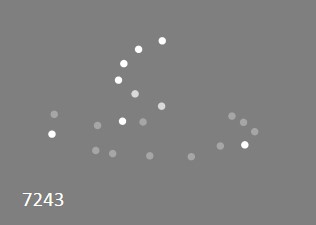 This cluster, which I am sure I have
observed before, but of which I don't have any specific recollection, possessed the most
interesting pattern of the three Lacerta objects. The main impression of the stars
in this cluster is shown in my sketch, although I did not make a note of any of the field
stars surrounding the cluster. My observations were only at 30x and also 37.5x. I
noticed that there was a hint of unresolved haze across the field at times, but the sky
conditions were humid, so that could also have just been some condensation on my optics. This cluster, which I am sure I have
observed before, but of which I don't have any specific recollection, possessed the most
interesting pattern of the three Lacerta objects. The main impression of the stars
in this cluster is shown in my sketch, although I did not make a note of any of the field
stars surrounding the cluster. My observations were only at 30x and also 37.5x. I
noticed that there was a hint of unresolved haze across the field at times, but the sky
conditions were humid, so that could also have just been some condensation on my optics. |
| 387 | 7296 | Sep 29, 2018 | 120mm f/5 achro | 213 OLC | Lacerta | This open cluster was very small and hazy, mostly unresolved at 48x, not too far from a bright field star, and embedded in a rich star field. It was much smaller and nondescript than the other two open clusters in Lacerta, but nevertheless interesting ~ it kind of presented a view like a small globular in Ophiuchus or Delphinus. |
| 388 | 7331 | Sept 5, 2018 | 13.1" dob | Blue Ridge Parkway | Pegasus | I have definitely observed this galaxy on many occasions, although never documented my observations. It is listed as being about 40 million light years away; if I can observe it under dark skies, it should be interesting to see if I can make out the dust lanes. I saw the galaxy this evening as definitely elongated north to south and with the core much brighter than the extended regions of the arms; I could barely detect some uneven illumination in the core at 76x but could not see the dust lane. |
| 389 | 7380 | Aug 13, 2018 | 13.1" dob | Blue Ridge Parkway | Cepheus | I noted this open cluster as presenting about two dozen stars over an unresolved haze, which based on the images I found online, may or may not have been the emission and/or reflection nebulosity associated with the cluster; somehow, I doubt that I was able to see that, especially since I don't recall looking for it. I thought the cluster showed a very nice pattern with two bright field stars. |
| 390 | 7448 | Sept 5, 2018 | 13.1" dob | Blue Ridge Parkway | Pegasus | 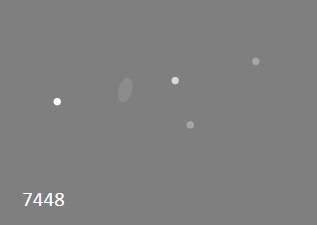 I saw this galaxy as very dim overall, with a
faint core and a slightly visible halo or outer area, and with an orientation possibly as I drew
it in the sketch. Interestingly, JLE Dreyer described it as pretty bright and large, while
this site describes it as unusual
owing to its designation as an Arp peculiar galaxy with a detached extension. I could not
see any of that, but in the image at the link, if you rotate the image 90 counter-clockwise, you
can see that the bright stars match my sketch quite well. In terms of locating this galaxy,
I thought that SkyAtlas 2000.0 did not quite have enough stars plotted to make identification of
the location easy ~ I had to extrapolate its position with a fairly long mental triangle to get
the location. I saw this galaxy as very dim overall, with a
faint core and a slightly visible halo or outer area, and with an orientation possibly as I drew
it in the sketch. Interestingly, JLE Dreyer described it as pretty bright and large, while
this site describes it as unusual
owing to its designation as an Arp peculiar galaxy with a detached extension. I could not
see any of that, but in the image at the link, if you rotate the image 90 counter-clockwise, you
can see that the bright stars match my sketch quite well. In terms of locating this galaxy,
I thought that SkyAtlas 2000.0 did not quite have enough stars plotted to make identification of
the location easy ~ I had to extrapolate its position with a fairly long mental triangle to get
the location. |
| 391 | 7479 | Sept 5, 2018 | 13.1" dob | Blue Ridge Parkway | Pegasus | 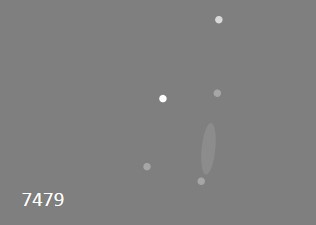 This galaxy appeared faint but fairly large
at 76x. I did not detect much of a core, but saw it as very elongated and lined up nicely
with several stars in a row as shown in the sketch. From this image on astroimages.org, one can see why
this galaxy was included in the H400 list, because of its unique spiral arms ~ from my notes and
sketch, it's clear that I did not see any of the arms, just the central section. Also, it's
clear that I saw the correct galaxy because my sketch matches the star positions correctly and in
particular I noted the faint star just off the northern tip of the galaxy. This galaxy appeared faint but fairly large
at 76x. I did not detect much of a core, but saw it as very elongated and lined up nicely
with several stars in a row as shown in the sketch. From this image on astroimages.org, one can see why
this galaxy was included in the H400 list, because of its unique spiral arms ~ from my notes and
sketch, it's clear that I did not see any of the arms, just the central section. Also, it's
clear that I saw the correct galaxy because my sketch matches the star positions correctly and in
particular I noted the faint star just off the northern tip of the galaxy. |
| 392 | 7510 | Aug 13, 2018 | 13.1" dob | Blue Ridge Parkway | Cepheus | I noted this open cluster as having a wierd appearance; one bright star and five others in a narrow polygon over a linear unresolved haze; The bright star was at the top of the field of view, then below it a grouping of the five or so middling bright stars, with all of them superimposed over an elongated hazy area. This image from a thread on cloudy nights clearly shows the oblong shape. |
| 393 | 7606 | Nov 20, 2017 | 13.1" dob | 213 OLC | Aquarius | first observation of this galaxy, very faint, elongation along north-south axis |
| 394 | 7662 | Nov 20, 2017 | 13.1" dob | 213 OLC | Andromeda | Blue Snowball, color distinctly blue, no structure, evenly illuminated across face |
| 395 | 7686 | Nov 20, 2017 | 13.1" dob | 213 OLC | Andromeda | open cluster in northern Andromeda, located around two uneven bright stars, arrayed in arcs around the two stars, but a fainter grouping between the two, centered on the brighter one |
| 396 | 7723 | Nov 20, 2017 | 13.1" dob | 213 OLC | Aquarius | first observation, faint, smaller than 7606, pretty diffuse |
| 397 | 7727 | Nov 20, 2017 | 13.1" dob | 213 OLC | Aquarius | first observation of this galaxy, faint, but more concentrated than 7723, easier to see than either 7723 or 7606 (nearby in Aquarius) |
| 398 | 7789 | Nov 11, 2018 | 150mm f/5 achromat | 213 OLC | Cassiopeia | I have observed this cluster many times in the past, but not recorded any notes as to its appearance; nevertheless, I always agreed with the reports of other observers that it was very rich, large, and with a sugar on velvet kind of appearance, similar to M37. On this occasion, I also noted it as being very rich, with a large round area of similarly bright stars covering a sizeable portion of the sky even at 37x. Very pretty sight! |
| 399 | 7790 | Nov 11, 2018 | 150mm f/5 achromat | 213 OLC | Cassiopeia | Surprisingly difficult to find, but once I got my finder properly aligned and used to the fact that my eyepiece yielded only 37.5 power, I was able to locate the cluster with ease and see that it was rather coarse, with several bright stars amid a good number of dimmer ones. The brighter stars were considerably brighter than the dimmer ones, but I did not detect much of an "unresolved haze" from much dimmer stars the way one sometimes sees. Nearby, presenting an almost more interesting appearance was the smaller cluster NGC 7788; it was more noticeably a small knot of stars at 37x than 7790; the cluster symbol in my planetarium software TheSky made me expect something larger than what 7790 looked like in my eyepiece. |
| 400 | 7814 | Sept 5, 2018 | 13.1" dob | Blue Ridge Parkway | Pegasus | I noted this galaxy as also being a little challenging to locate using just SkyAtlas 2000.0, owing to the dearth of stars plotted in that area. The finder scope shows quite a bit more, so identification is tricky, but I was able to locate it after a bit. My notes indicate that I saw it as not small and not bright, but it definitely looked elongated immediately when I saw it; it appeared a bit brighter toward the center of the galaxy, not hugely so, but somewhat. This image from Astronomy magazine shows why it was selected for the Herschel 400 list ~ it's called the mini-Sombrero galaxy because of a thin dust lane through the center, which of course I did not see. |